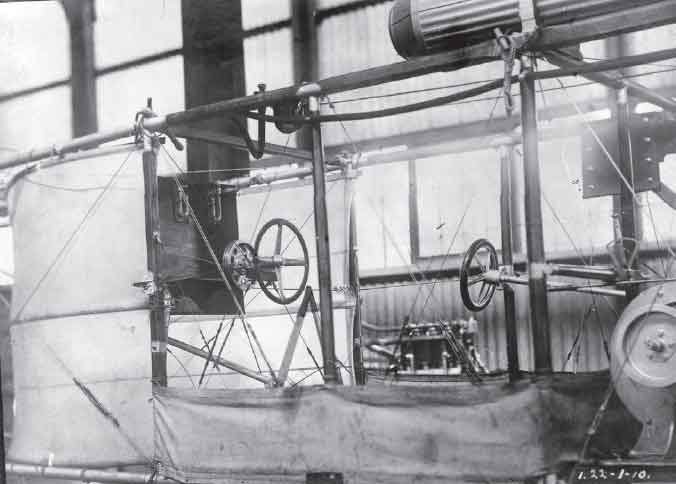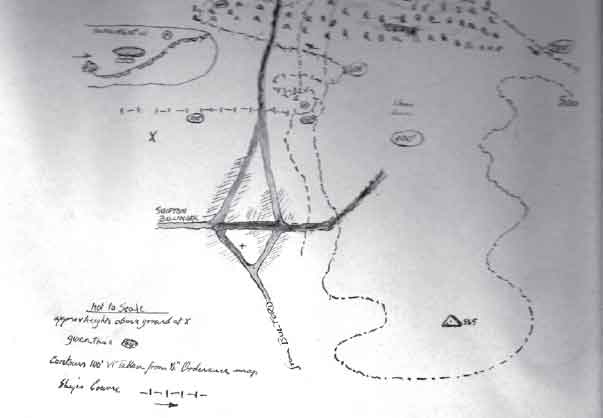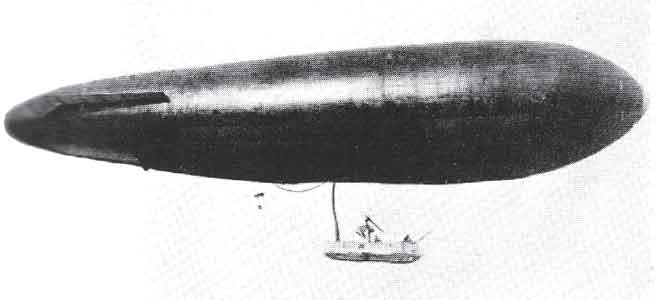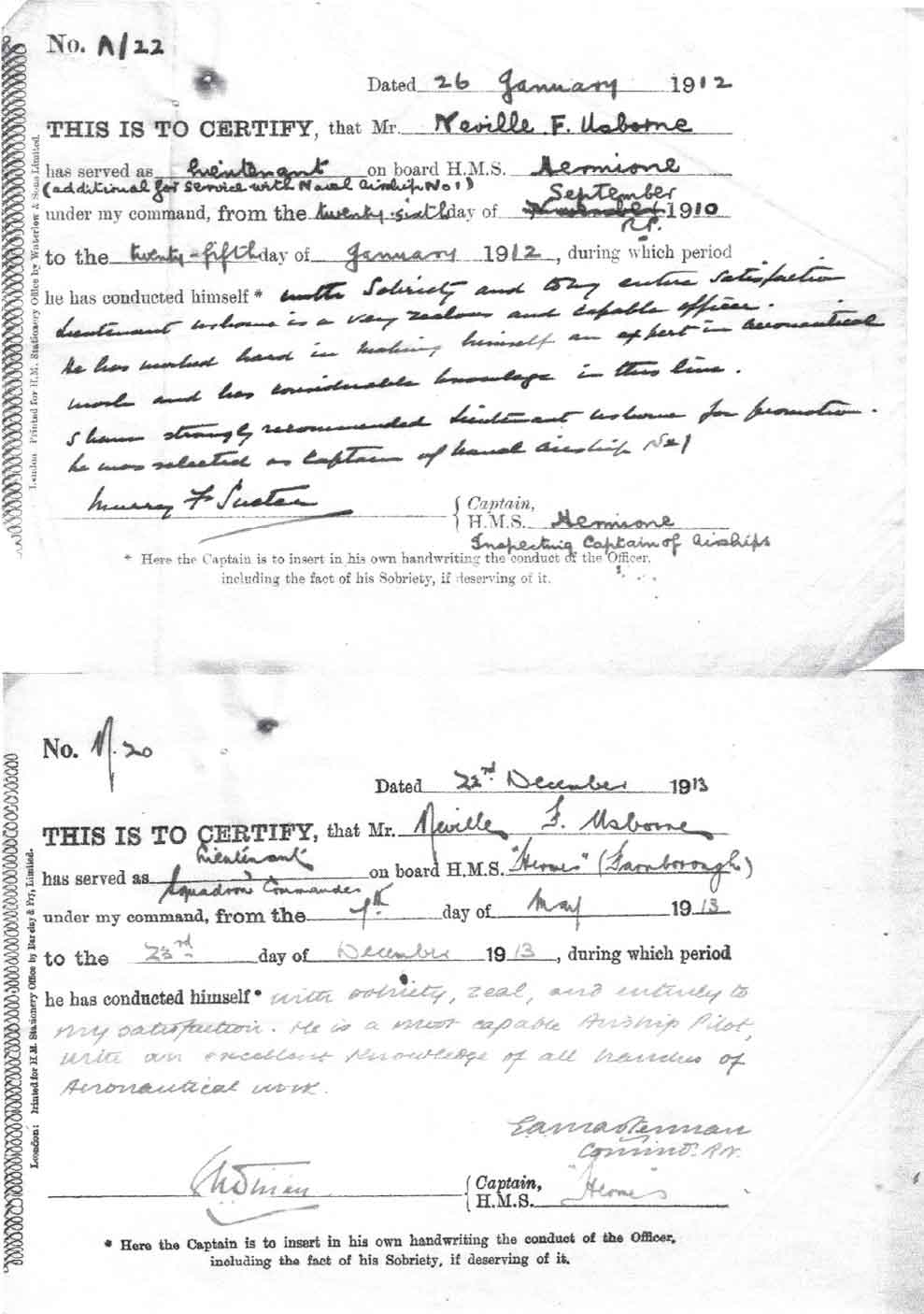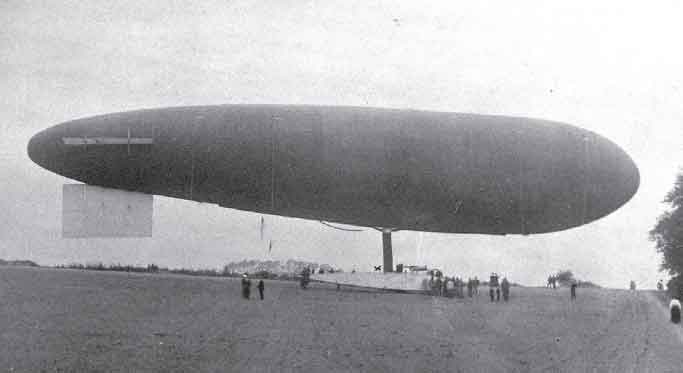The ‘Golden Age’ before August 1914
Naval Aviation Career before the First World War
Towards the end of 1908, or the start of 1909, Neville was appointed for work at Barrow-in-Furness in connection with construction of Naval Airship No 1. An entry in his naval record of service notes he was on the books of HMS Vernon for further torpedo qualifications, but also seconded to the Admiralty for special services in connection with airship construction and also for duties as an interpreter in German.1
The first indication of any serious interest being taken in aviation by the Admiralty was on 21 July 1908, when Captain R.H.S. Bacon2, CVO, DSO, RN, the Director of Naval Ordnance, submitted proposals to the First Sea Lord, Admiral Sir John Fisher3, GCB, GCVO, ADC, suggesting that a Naval Air Assistant be appointed, that the War Office should be asked to place the Superintendent of the Balloon School in contact with the Admiralty and that a rigid type of airship should be built for the Royal Navy.4
On 14 August 1908, a letter from the Admiralty invited Messrs Vickers, Son & Maxim of Barrow (Which, as part of BAE Systems, is still to this day a major contractor for UK Government armament work.) to tender for a rigid airship comparable to, or better than, current German airships. There is no doubt that Usborne would have been aware of the developments in lighter-than-air aviation over the previous decade, and that his skills in German would have been most useful in reading material written in the German technical and aviation press.
Progress in Germany
The reconstituted design and production team at Friedrichshafen had suffered the trials and tribulations associated with the development of any new technology. It is of interest to note that British official interest had been aroused, as in December 1905 the British consul in Stuttgart was asked to take note of events at the Zeppelin works.5 The LZ2, which was smaller than the LZ1 and with more powerful engines, crashed on its maiden flight in January 1906 due to uncontrollable pitching movements, engine and steering failure, and was totally wrecked. Sustained flight was achieved with the LZ3 later in that year, which had horizontal stabilisers to cure the problem. Its maiden flight, on 9 October, lasted over two hours, achieving a top speed of 24mph (38kph) with eleven souls on board. In 1907, the Daily Mail’s air correspondent, Harry Harper, who, in 1906, had been appointed the first full-time air correspondent of a national newspaper, reported:
‘Out upon the gleaming surface of Lake Constance the giant craft lies hidden in its floating corrugated iron shed. Count Zeppelin’s crew are at work inside making various changes suggested by successful trials. When they have finished, Count Zeppelin is confident that he will be able to sail for an unbroken period of twenty-four hours. German military experts were jubilant over the Count’s latest achievements and are bringing their utmost influence to bear to induce the government to purchase the ship without waiting for further experiments. Count Zeppelin’s manoeuvres with his airship during the past week have been most remarkable and have convinced everyone that the ship is the most efficient at present in existence.’6
In 1907, at the Second Hague Conference, the declaration prohibiting the dropping of explosives from the air was renewed, but was signed by only twenty-seven of the forty-four powers represented there and of those who would take part as belligerents in the First World War; by Great Britain, the United States, Portugal and Belgium only. The bombardment of undefended places by any means whatever was forbidden. It lapsed automatically in August 1914 and ceased to be binding when non-contracting powers became belligerents. In the meantime it served to concentrate the minds of those in government in Great Britain and would result in the establishment – the following year – of a committee under Lord Esher,7 which will be discussed below.
On 1 July 1908, LZ4 made the first international flight by Zeppelin to Switzerland, overflying Lucerne and Geneva, setting a new world air endurance record of twelve hours. A twenty-four hour flight followed a month later at a time when the longest duration aeroplane flight in Europe was but fifteen minutes. (Though Orville Wright was soon to make a solo flight of an hour and a half in the USA.) Unfortunately, LZ4 came to grief while moored on the ground near Stuttgart. It was destroyed in a gas explosion caused by the build up of static electricity caused by the rubberised cotton gas cells rubbing against each other. Luckily nobody was injured. But from the wreckage emerged a wealth of public support in Germany. Money poured in from the rich and poor, which enabled construction of the LZ5 to begin. On 10 November 1908, Kaiser Wilhelm II came to Friedrichshafen to award the Count with the Prussian Order of the Black Eagle and to declare that he was the greatest German of the new century. In the spring of 1909, LZ5 made a long distance flight of 39 hours and 39 minutes, covering 712 miles (1150 km). The Count had become a national hero:
‘An emblem of German pride, honour and endeavour. Shops sold marzipan Zeppelins, sweets, cigarettes, harmonicas and yachting caps. There were Zeppelin streets, squares, parks, roses and chrysanthemums.’8
More importantly, perhaps, from a practical point of view, the German Army bought LZ3, renaming it SMS (Seiner Majestaet Schiff) Z-I, and LZ5, which became Z-II.9 A little later, in 1909, one of the army airships was flown by Count Zeppelin, Major Sperling, and a crew from the Army Balloon Corps, to Munich, followed by a detachment of cavalry, where she was reported as having dipped her nose three times in salute to the Prince Regent and a huge crowd at the city’s Exhibition Hall, and then onwards over the Royal Palace, from where the Princess Maria Theresa and her daughters waved their handkerchiefs in salutation.10 Soon afterwards, Zeppelin and Parseval airships took part in the Imperial Army manoeuvres, held on the border of Wurtemburg and Bavaria, as also did Krupp’s newly invented anti-aircraft artillery.11
Work progresses at Farnborough under Colonel Capper
Sadly, the first and only fatal accident experienced by British Army free ballooning aeronauts occurred on 25 May 1907. King Edward VII and Prince Fushimi of Japan visited the Balloon Factory to witness a demonstration of free ballooning. The balloon, Thrasher, carrying Lieutenants T.E. Martin-Leake, RE, and W.T.M. Caulfield, RE, ascended and disappeared from view. Over Abbotsbury the two officers called out to a local farmer to catch hold of the trail rope, but to no avail. It came down in the sea off the Dorset coast near Bridport; neither of the officers were ever found, although the tangled wreck of the balloon was salvaged by a fishing vessel. Meanwhile, the Royal Party paid a visit to the nearby shed where important work had been progressing. It is believed that while inspecting work therein, the King personally named the bulky and impressive dirigible, Nulli Secundus. [The King’s choice of name for the airship was reported in the highly reputable French aeronautical periodical L’Aérophile: ‘Nulli Secundus tel serait, assure-t-on, le nom donné, sur le désire du roi Edouard VII, au nouveau dirigible Anglais; il suffit à indiquer que l’Angleterre entend bien ne pas demeurer en arrière des nations continentals dans les applications du ballon automobile.’]12
Samuel Cody13 was engaged on the design of the airscrews, engine mounting and the control surfaces for the airship being constructed there. According to Harry Harper, Cody’s, ‘picturesque appearance, and genial, laughing, hail-fellow-well-met manner’ did not endear him to some War Office officials, but more importantly, he and Capper established a rapport and mutual respect.14 A gondola made from a metal tube framework and covered by fabric was constructed by Cody based on plans made by Capper, replacing Templer’s original idea of two basketwork balloon cars. It should be noted that Capper and Templer remained on good terms, and that he made an important contribution to the design of Nulli Secundus, particularly in respect of the construction of the envelope. The challenge facing the team at Farnborough has been described thus:
‘Nulli Secundus I, of course, had more than the usual disadvantages associated with any new and untried airship; not only had both she and her pilot [Capper] never flown before, but the whole design and construction had been carried out by a team that had never produced an airship before.’15
It should, of course, be noted that the same challenge faced nearly every other pioneer of either aeroplanes or airships, including Count Zeppelin, Santos-Dumont and the Wright Brothers, and indeed Harry Ferguson or Lilian Bland in Ireland. Capper tried to rectify his lack of aerial experience by taking part, accompanied at times by Mrs Capper, in a number of civilian balloon events and competitions.
The maiden flight in the brief career of British Army Dirigible No 1, Nulli Secundus, was from the Army Balloon Factory at Farnborough on 10 September 1907. The great shed had been doubled in length to accommodate the airship, which was a brown, sausage-shaped balloon, made from goldbeater’s skin, some 111 feet (34 metres) in length, with a diameter of 18 feet (5.5 metres) and a capacity of 55,000 cubic feet (1556 cubic metres) covered with a net, with the gondola suspended below from a light framework which could hold three crewmen. She was powered by a 40 hp (29.6 kW) Antoinette engine. At first there were a few problems with the engine running hot and generating less power than required to turn the airscrews at a sufficient rate for successful, sustained flight.16 After some adjustments, she undertook a short series of trials with two flights on 10 September, the second of which was witnessed by Colonel Templer and which concluded with a heavier than desirable descent which caused some superficial damage. No further flights took place for the next three weeks as the Balloon School was programmed to take part with balloons and kites in the autumn manoeuvres. The time was spent productively in making structural alterations to the control surfaces. Two trips were made on 30 September and 3 October, which culminated in a circuit as far as Guildford and back. Nulli Secundus had now flown a total of about three hours and a distance of 25 miles (40 kilometres). Capper was determined to influence public opinion and so coerce the War Office into providing greater funding for the development of aviation. It may also have been the case that he was influenced by the success of Zeppelin LZ 3, which had recently made a flight of 200 miles (320 kilometres) in nine and a quarter hours around Lake Constance, and also the French Lebaudy, La Patrie, which, on 12 July 1907, had flown a closed loop of 40 miles (64 kilometres) around Chalais-Meudon, at an average speed of 22mph (35kph). So he determined upon a bold and spectacular flight. On 5 October, Nulli Secundus was flown the 50 miles (80 kilometres) to London in three and a half hours with Capper at the helm, Cody tending the engine and Captain W.A. King, the instructor in ballooning and map-reading, flying over Kensington, Hyde Park and the War Office, circling St Paul’s Cathedral and landing on the cycle track at Crystal Palace, so establishing a new endurance record for non-rigid airships and ensuring huge headlines in the daily papers. Harry Harper reported on the momentous event as follows:
‘In the streets, trams and all other vehicles came to an abrupt halt. London’s millions just stood staring up into the sky in amazement as the airship flew low, only 500 to 600 feet above streets and houses. It was so low that people looking up could see Cody and Capper quite clearly in their small control car, and every now and then Cody would turn from his engine to lean over the side of the car and wave to those below. On the roof of the War Office members of the Army Council stood waving handkerchiefs. It was a moment of triumph.’17
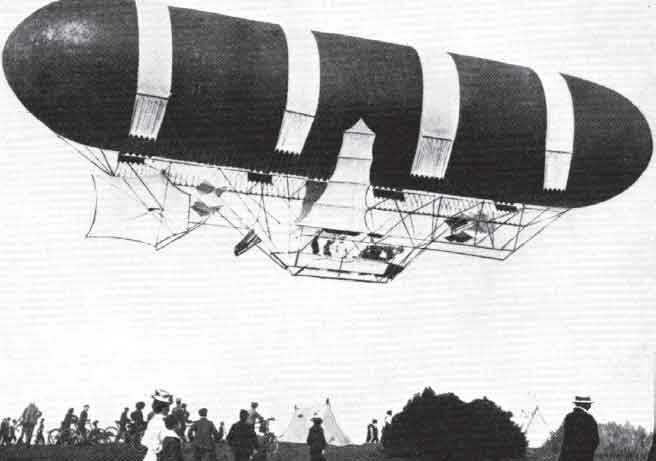
Nulli Secundus I takes to the air on 10 September 1907.

Nulli Secundus I over St Paul’s on 5 October 1907.
[Author’s note: Nulli Secundus took off from Farnborough at 10.40 am and followed the course Frimley – Bagshot – Sunningdale – Staines – Hounslow – Brentford, at a height of between 750 and 1300 feet (230–430 metres) and an average speed, with a following wind, of 24mph (40kph). She passed over Kensington Palace, Hyde Park, Buckingham Palace, Whitehall, Trafalgar Square, The Strand and Fleet Street, circling St Paul’s at about 12.20 pm. From there a course was taken over Blackfriars, Kennington and Clapham Common before alighting at Crystal Palace at 2 pm.]
Capper was pleased with the way the airship had answered the controls and had steered well, both with and into the wind, overcoming the resistance of the strong breeze to make headway.18 They were driven back to Farnborough in Cody’s large touring car, in which Lieutenant Clive Waterlow had followed the airship, along with petrol, tools and the ground crew, an event which Waterlow described with some glee in a letter to his mother.19 (Waterlow had joined the Balloon School as a 2nd Lieutenant on 18 October 1906; he would spend the rest of his life on airships until his untimely and tragic death in an accident at RNAS Cranwell in 1917, at the age of thirty-one.)20 Three days later, owing to heavy winds and rain which had damaged and thoroughly soaked the envelope, as well as lowering the temperature of the hydrogen, so degrading its buoyancy and lift and, despite the innovative use of slipstream from the propellers to assist in drying out the envelope, the airship had to be deflated, and was taken back to Farnborough by means of horse and cart.21
Capper was interviewed after the flight and said that he was very happy with it; the airship had performed well and could have stayed aloft for longer. He decided to terminate the flight because of the deteriorating weather and didn’t want to take risks at a stage when airship development was in its infancy.22
La Patrie was lost on 29 November 1907, blown unmanned from her moorings at Verdun across Northern France, Cornwall and the Irish Sea. Numerous sightings were reported in the Belfast Telegraph, ‘to the consternation of the inhabitants’ of country towns and villages who, ‘gathered in large numbers’ to view the great yellow dirigible pass overhead.23 She struck a hillside on the south side of Belfast Lough at Ballydavey, Holywood, Co Down, losing a propeller in the process, but ascended once more and was last seen off the Isle of Islay speeding into oblivion.24
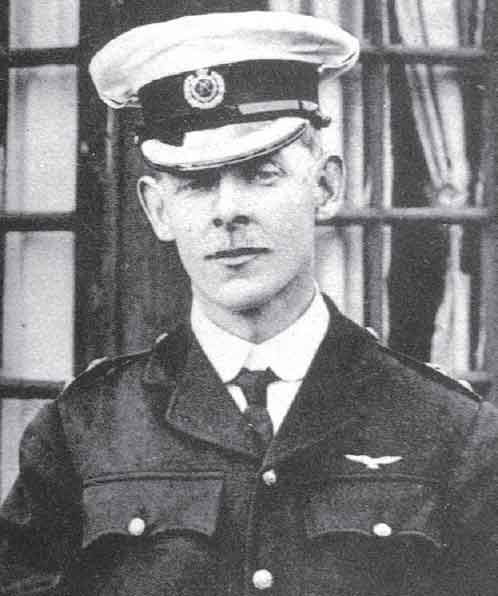
Lieutenant Clive Waterlow RE.
During the winter of 1907/08 work began on redesigning and rebuilding Nulli Secundus; modifications included the replacement of the covering net by a varnished silk ‘chemise’, a new understructure, the addition of a reserve gasbag, a new car for the crew and engine mounting, alterations to the control and stabilizing surfaces, and a new bow elevator.
In April 1908, Colonel Templer’s contract was not renewed. No longer would his stocky form be seen in the environs of the balloon shed with a snuff-box in one hand and a large coloured handkerchief in the other. A terse file note is all that has survived by way of an official tribute, ‘Colonel Templer’s services were dispensed with from the 1st inst – 27.4.08.’25 He faded away and has never really been given the recognition he deserves as a great pioneer of military aviation.
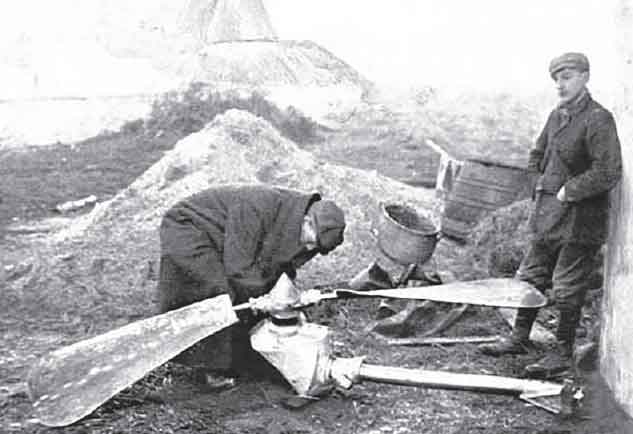
In November 1907 parts of the Lebaudy airship La Patrie were left on a hillside in Co Down.
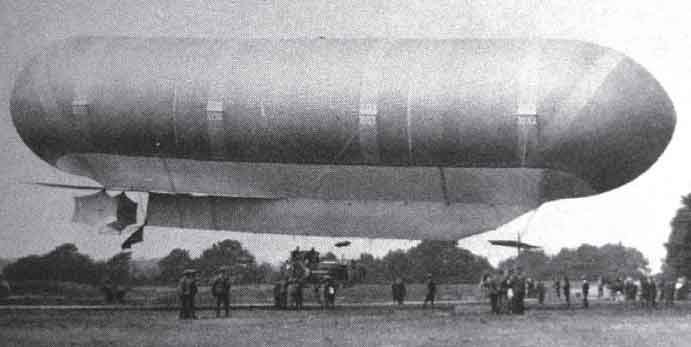
Nulli Secundus II.
Nulli Secundus II first flew on the evening of 24 July 1908, and proved to be somewhat unstable and difficult to trim. Two more short flights were made in August, during which a top speed of 22mph (35kph) was reached, but she was of little value and was broken up. At some stage over the summer a party of naval personnel visited Farnborough and received some instruction in airship handling. Colonel Capper later remarked that as far as the airship’s name went it actually came a bad second to the Willows 1A.26
The Times was much more willing to sing the praises of the team, in particular Cody, Capper and Templer, which had reconstructed Nulli Secundus:
‘As is now known there are many airships which have been completed and are under construction. Every new vessel proves more conclusively to the unbiased mind that it is merely a question of time, practice, experiment and general development – especially regarding the construction of a light yet powerful engine – before airships will be sufficiently navigable, even in strong winds and unfavourable weather, to prove of enormous value to every civilised portion of the world. The first trial of the rebuilt Nulli Secundus, which took place on Cove Common last week, should certainly give every Englishman satisfaction that our experiments, though somewhat tardy, are coming to a more successful path and should encourage all who possess either foresight or patriotism or both.’27
The use of new technology also extended to communications, experiments in wireless telegraphy being conducted. The first wireless company of the Royal Engineers was formed in 1907 at Farnborough. Its primary task was to investigate the possibilities of military communication by means of airborne wireless sets and was, therefore, attached to the Balloon School. In May 1908, Capper, and Lieutenant C.J. Ashton RE, ascended in the free balloon Pegasus to a height of 8000 feet and, when aloft over Petersfield, received signals from a wireless station at Aldershot some 20 miles (32 kilometres) away and also from the battleship HMS King Edward VII, which was lying off Portsmouth. The British and Irish press reported in July 1908 that successful experiments had taken place near Berlin, conducted by the German army, concerning the dispatch of wireless telegrams from a dirigible.28 As this technology involved sparks on electrical contacts it was regarded as rather hazardous when in close association with a gasbag full of hydrogen, however the Germans persevered, and within a few months were using airships equipped with wireless sets on army manoeuvres.
Also in 1908, Lieutenant E.M. Maitland – ‘a brilliant, brave and gallant officer, whose personal influence on the officers and men of the Airship Service became legendary, even in his lifetime’29 – made his first parachute jump from a trapeze suspended below a hot-air balloon at Crystal Palace, landing on the roof of a public house, from which encounter he emerged unscathed – but not so the roof.
Contemporary Media Comment
It is interesting to note that in January 1908, Pall Mall magazine featured the first part of a new serial story by H.G. Wells, The War in the Air, which included a highly coloured description of a devastating attack on a fleet of American dreadnought battleships, followed by a ruinous air raid on New York by an armada of German airships:
‘As the airships sailed along they smashed up the city as a child will shatter its cities of brick and card. Below, they left ruins and blazing conflagrations, and heaped and scattered dead; men, women and children mixed together.’30
Authors in France and Germany during this period, such as Emile Driant and Rudolf Martin, also wrote of airships transporting vast armies to attack Russia or Britain and bring death and destruction on a huge scale. Others believed – employing what could only be wishful thinking – that warfare from the air would be so destructive that it would make conflict between the major powers less likely.31
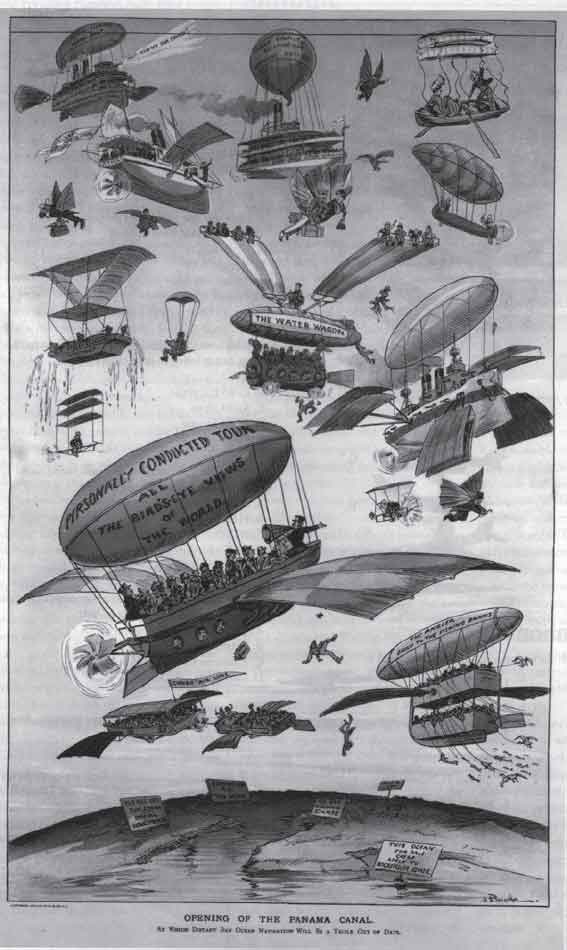
A cartoon from the US magazine Puck of January 1906.
There was a growing sense of public unease that Britain was no longer so securely insulated by the Royal Navy from the threat of invasion. A popular contemporary success in the London theatre was the play, An Englishman’s Home by Guy du Maurier, which showed in dramatic form what might happen if England were subject to a German invasion.
Developments in Government Policy
The potential threat from the air began to shake the populace from its Victorian stance of complacent insularity.32 Indeed, the Chancellor of the Exchequer, David Lloyd George, made Parliament aware of H.G. Wells’ latest story when participating in the Aerial Navigation Sub-committee of the Committee of Imperial Defence, which had been established in October 1908 with the following terms of reference:
‘Several of the great powers are turning their attention to the question and are spending large sums of money in the development of dirigible balloons and aeroplanes. It is probable that for countries with land frontiers immediately across which lie potential enemies, the development of airships has hitherto been more important than it is for Great Britain, and that we have been justified for this reason in spending less money than some of our neighbours. The success that has attended recent experiments in France, Germany and America has, however, created a new situation which appears to render it advisable that the subject of aerial navigation should be investigated.’33
The Chairman of this sub-committee was Lord Esher, who was not only a distinguished military strategist, but also had the ear and confidence of the King, Edward VII. The other members were the Chancellor of the Exchequer, David Lloyd George; the Secretary of State for War, R.B. Haldane; the First Lord of the Admiralty, Reginald McKenna; the Director of Naval Ordnance, Captain R.H.S. Bacon, RN; the Chief of the Imperial General Staff, General Sir W. Nicholson; the Director of Military Operations, Major General J.S. Ewart and the Master General of the Ordnance, Major General C. Hadden. Its aim was to deliberate what should be done about assessing future dangers from the air, how to counter them and how much money to spend on this. Written evidence principally concerning balloons and dirigibles was submitted by Sir Hiram Maxim, Charles Rolls, Lieutenant Colonel John Capper, RE, and Major B.F.S. Baden-Powell. It was decided that airships might well have some utility in the roles of reconnaissance over land and sea, as well as artillery spotting, and that hostile airships might become capable of carrying out bombing raids on the British Isles. From the minutes of the meeting which Colonel Capper attended, it would appear that he lost not only the support of General Nicholson, who strongly disapproved of aircraft of any sort, but also of R.B. Haldane, which did not bode well for the security of his tenure at Farnborough.34 Haldane had been educated in Germany and much admired the inhabitants’ efficiency and technological prowess, being particularly interested in Count Zeppelin’s experiments and progress.35 He was in favour of creating an aerial service, but he wanted progress towards this aim to be structured, measured, organised and systematic, with a scientific research and development programme directed and controlled by the government. Others disagreed and felt that in order not to fall further behind the continental powers, Britain should purchase immediately the latest available technology.36
Figures were released by the War Office in response to a question from Lord Montagu of Beaulieu showing a comparison of the sums spent on aviation in 1908 by several European governments. Leading the field was Germany with £135,000 from public funds, to which was added £265,000 collected by private subscription by the National Zeppelin Airship Fund. Next was France with £47,000, then Austria-Hungary with £5500 and trailing in fourth was Great Britain with £5270, £1980 of which was allocated to the army for dirigible balloons and £3290 on aeroplanes.37 As well as being a distinguished motoring authority, Lord Montagu was very interested in aeronautics and was a founder member of the Aerial League of the British Empire, founded in January 1909. Its aim was to convince the country of the vital importance to the British Empire of aerial supremacy, much in the way that the Royal Navy had assured domination of the seas in the century following Trafalgar. He was particularly exercised by the thought of a fleet of airships striking pre-emptively at the strategic targets concentrated in London, effectively winning a future war before the army or the Royal Navy could get to grips with enemy forces.38
‘It would be possible for dirigibles to leave the frontier stations of at least five Continental powers, all within 500 miles distance from where we are now seated, and do much damage at Aldershot, Portsmouth, Dover, Chatham, Sheerness, and other military and naval stations, without taking into account that an attempt would certainly be made to paralyse the heart of the nation by attacking certain nerve centres in London, the destruction of which would impede or entirely destroy the means of communication by telephone, telegraph, rail and road.
‘Germany’s plans in airships, as in other directions, are not fully known to us; nor would this be the occasion to state how such information can be obtained. But it is beyond doubt that she has, at the present moment, the best and the only fully equipped aerial fleet in the world, and one which is more than a match for all the other dirigibles in existence.
‘The day is not far distant when England will have to be something besides nominal mistress of the seas. She will have to be at least equal to her neighbours in the matter of aerial defence and offence, and it is our business and the duty of the nation at large to see that the authorities are awakened in time to their responsibilities in this direction.’39
Moreover, a very trenchant article in The Times of February 1909 was highly critical of the British efforts so far in the field of aeronautics and argued forcibly for the airship:
‘The war of the future is likely to be decided in no small measure by the use of scientific instruments of destruction controlled by highly trained men. That the airship in its various forms promises to become such an instrument is every day becoming more and more apparent. Progress may be astonishingly rapid, but without well-equipped laboratories, testing grounds and factories, our authorities are utterly unable to discover the merits of new ideas. We are laboriously going over the same preliminary ground which the French and Germans traversed years ago. A most important task is to bring the adult Briton to understand that there is an immediate need for an aerial defence scheme. With this end in view I would favour the holding of public meetings and lectures throughout the important centres and, better still, practical demonstrations by airships, even if we have to go abroad for the machines and the men. It is painful to report that no successful dirigible or aeroplane has yet been flown in the British Isles and that the vast majority of the people have never seen one in any form.’40
A subsequent article in March of the same year contended:
‘In 1912 the Germans will have at least twenty-four mammoth Zeppelin airships, each capable of overseas excursions and probably speedier than any naval vessel. Our rate of production is one vessel per annum and by 1912, at most, we may have some five small-sized, slow, non-rigid airships, which compared to Zeppelins will be as antiquated cruisers to Dreadnoughts. A Zeppelin of the present-day type could reach this country in ten hours and do enormous damage in a brief space of time.’41
Whilst the critique of the British lack of organisation was reasonable enough, the correspondent’s estimate of the German capability was over-egging the pudding somewhat. The somewhat febrile atmosphere was heightened by a rash of reports received in police stations and newspaper offices across the country – in the first few months of 1909 – claiming the sighting of mysterious flying objects, widely believed to be airships of unknown but suspicious origin. This became known as the Phantom Airship Scare and was part of a developing national phobia concerning Germans and their hostile intentions, such as the rumour that there were 80,000 soldiers of the Kaiser embedded in the country, disguised as waiters, barbers, businessmen and shop assistants.42 It was, to a certain extent, a by-product of the Anglo-German naval rivalry and the German desire to have colonies to match those of the British Empire. The paranoia might have been better directed to an appreciation of the portents of firstly, the remarkable feat of Louis Blériot in the early hours of 25 June 1909 when he completed his crossing of the English Channel in his frail monoplane in a time of thirty-seven minutes, and secondly, the International Flying Meeting at Reims a month later, of which it was written:
‘Reims marked the true acceptance of the aeroplane as a practical vehicle and as such was a major milestone in the world’s history.’43
Yet the fixed-wing aeroplane was still in its infancy. David Lloyd George attended the Reims meeting and was impressed by what he witnessed, causing the Morning Post to comment:
‘If Mr Lloyd George’s words help to rouse the minds of his followers to the importance of the question, they will do more for the interests of the country than his stupid abuse of landlords. The Chancellor of the Exchequer says that Englishmen would soon grow enthusiastic if they saw airships in flight. In this he is quite right. As Mr Lloyd George no doubt realizes, it is the dirigible balloon that at present is the best adapted for practical uses. The terrible damage which such a vessel could work, and the tremendous moral effect its operations would produce, render it a most formidable engine of war. An attack could only be effectively met by other airships, and the English people cannot realize too soon the urgent necessity of organizing an aerial fleet. Until this is done the position of the country is one of grave and increasing danger.’44
There was, however, official and military awareness in 1909 of the potential threat posed by German dirigibles. The British Military Attaché in Berlin, Colonel Frederick Trench, had paid particular attention to airship development in the country; questioning his contacts, travelling around the country to view airships, visiting the factories in which they were being constructed, and keeping abreast of reports in the national, regional and technical press. He sent detailed reports to the War Office in London, noting, amongst other events, that a school for aeronauts had been established at Friedrichshafen; secret contracts had been let for the increased manufacture of hydrogen, which would be taken over by the military on the ‘outbreak of hostilities’ and that airship manoeuvres, including wireless telegraphy, bomb dropping and ‘airship chasing’, had taken place in the Rhine Valley near Cologne; which was regarded as being of particular significance as that city was, ‘almost the nearest point to England’.45 Not only did he produce these official reports, but he also wrote privately to Colonel Capper, whom he knew well. He attempted to arrange for Capper to visit Germany to have a look at the dirigibles, but encountered reluctance on the part of previously friendly contacts, which made him even more suspicious of Germany’s ultimate intentions.
Back at Farnborough
Over the winter of 1908, Colonel Capper and the team at Farnborough had built another non-rigid airship, Dirigible No 2, which made its first appearance in the late spring of 1909 and was unofficially christened Baby. The envelope was fish-shaped, or pisiform,46 to lessen wind resistance as compared to Dirigible No 1 and was made of goldbeater’s skin; she was 84 feet (25 metres) in length and had a diameter of 24 feet (7 metres), with a volume of 21,000 cubic feet (5943 cubic metres). Capper had liaised with the National Physical Laboratory at Teddington with the testing of ebony models of possible envelope shapes in the air channel or wind-tunnel located there, having been told by the Wright brothers of the utility of such a device. One ballonet was contained inside the envelope which, to begin with, had three inflated fins to act as stabilizers. These proved unsatisfactory as they were lacking in rigidity, and were replaced after the first inflation by the ordinary, non-inflatable fixed planes. Two 10 hp (7.4 kW), 3-cylinder Buchet engines were mounted in a long car driving a single propeller, and, at a later date, these were replaced by a 25 hp (18.5 kW) REP radial engine, which was not a great improvement. Finally, a 35 hp engine (25 kW) designed by Gustavus Green was installed. Green (1865–1964) was the first successful aero-engine designer in Great Britain. Over a period of seven months, from 11 May to 10 December 1908, Baby made thirteen fairly short flights with this variety of engines and control surface configurations. This could charitably be described as a development programme based on the trial and error method. She proved to be very unstable and rather slow, barely reaching 20mph (32kph); a complete redesign was required. During the autumn, permission was obtained to enlarge the envelope and fit a more powerful engine.
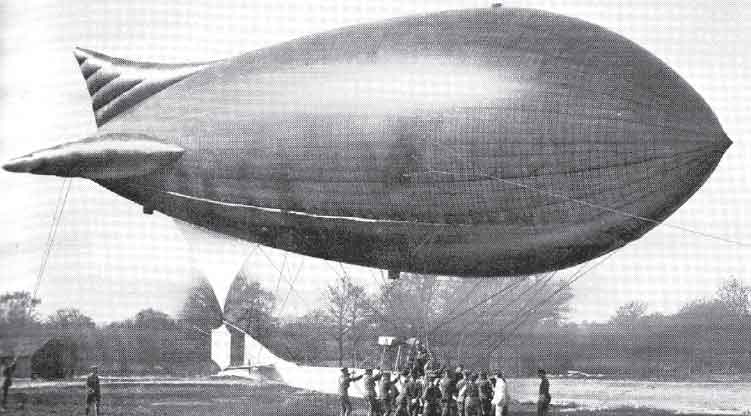
Baby in May 1909.
Further Official Interest
The establishment of the Advisory Committee on Aeronautics in 1909 was a major step forward, though it had taken all of three years to come to fruition. Early in 1906 a proposal had been made by Colonel J.D. Fullerton, RE, supported by Colonel Templer, for the appointment of a committee consisting of military officers, aeronauts, mechanical engineers and naval representatives to harness the available expertise to investigate all technical matters aeronautical in a structured and scientific fashion. A modified form of this idea was put forward some three years later by R.B. Haldane, the Secretary of State for War. He was particularly keen to involve the National Physical Laboratory at Teddington and thereby, hopefully, bring the best scientific talent to bear upon the study of flight, and give the government direct control of aeronautical research and experiment. (The laboratory was founded in 1900 to carry out scientific tests for theoretical purposes and also for the benefit of British industry, in imitation of, and in somewhat belated response to, the Physikalisch Technichse Reichsanstalt, which had been established in Berlin since 1887. It represented a significant move away from the Victorian laissez faire attitude, which held that industrial activities should be the exclusive pursuit of private enterprise.) A conference was held in the room of the First Lord of the Admiralty and its deliberations were approved by the Prime Minister, Herbert Henry Asquith. The Advisory Committee for Aeronautics was set up with ten members, seven of whom were Fellows of the Royal Society. The President was Lord Rayleigh, OM, FRS and the Chairman, Dr R.T. Glazebrook, FRS, the Director of the National Physical Laboratory. [Lord Rayleigh (1842–1919) was a Nobel Laureate in 1904 and had a worldwide reputation as one of the foremost mathematical and experimental physicists of his day.] The army was represented by Major General Sir Charles Hadden, the navy by Captain R.H.S. Bacon, and the Meteorological Office by Dr W.N. Shaw. Soon, two others were added, Mervyn O’Gorman, when he took over the charge of the Balloon Factory, and ‘the brilliant but unorthodox’,47 ‘difficult and temperamental’,48 Captain Murray Sueter, RN.
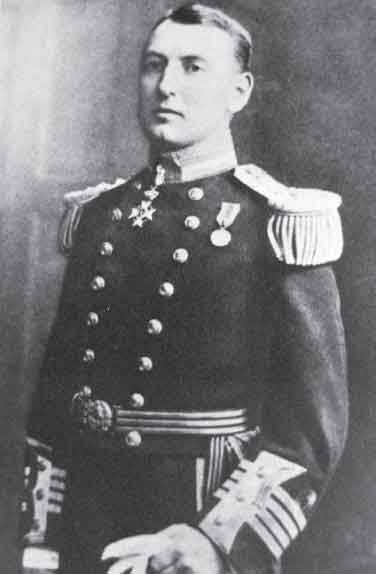
Captain Murray Sueter in 1915. (Via Peter Wright)
[Author’s note: Sueter was born in 1872 and, as a junior officer, showed indications of an original mind, and a considerable inventive genius in the new fields of torpedoes, submarines and wireless telegraphy. As the first Director of the Admiralty’s Air Department from 1912 to 1916, he was a tireless advocate of air power and succeeded in annoying many influential senior officers. He was effectively exiled to command in Southern Italy and, following an ill-advised letter to the King in 1917, his active naval career was cut short. After the war, when neither the Admiralty nor the Air Department was prepared to offer a position to this talented maverick, he became a Member of Parliament and a thorn in the side of the establishment. He was, however, knighted in 1934 and lived to a ripe old age, dying in 1960.]
From that time on the National Physical Laboratory worked in very close cooperation with the Balloon Factory. Some of the topics considered, investigated and experimented upon included – air resistance, stresses and strains on materials, means of protecting airships from electrical discharges, the best shape for the wing of an aeroplane and the best fabric for the envelope of an airship. Colonel Capper was a significant omission; despite his obvious knowledge and enthusiasm, he was too outspoken and irascible, and had not impressed Haldane, who considered that he was a clever empiricist but was not the man to build up an Air Service as he envisaged it, on a foundation of science.49
The government’s view of the role of the committee was expressed in the House of Commons. On 20 May 1909, Arthur Balfour asked the Prime Minister about the new committee. Mr Asquith replied:
‘It is not part of the general duty of the Advisory Committee for Aeronautics either to construct or invent. Its function is not to initiate but to consider what is initiated elsewhere, and is referred to it by the executive officers of the navy and army construction departments. The problems which are likely to arise… for solutions are numerous, and it will be the work of the committee to advise on these problems, and to seek their solution by the application of both theoretical and experimental methods of research.’50
The Advisory Committee visited Farnborough on 5 July 1909. No records of what was discussed have survived, but at least early contact was made. It may be considered a weakness that the Advisory Committee was heavily biased towards theoretical knowledge. Where were the industrialists, the engineers, the aviators, who could have assisted with the application of the theory to reality, perhaps by using some of the empiricism so disregarded by Haldane? Writing after the First World War, the official historian approved of Haldane’s methods:
‘These and scores of other problems were systematically and patiently attacked. There were no theatrically quick results, but the work done laid a firm and broad base for all subsequent success. Hasty popular criticism is apt to measure the value of scientific advice by the tale of things done, and to overlook the credit that belongs to it for things prevented. The science of aeronautics in the year 1909 was in a very difficult and uncertain stage of its early development; any mistakes in laying the foundations of a national air force would not only have involved the nation in much useless expense, but would have imperilled the whole structure.’51
In October 1909, the Balloon Factory and Balloon School at South Farnborough, which had been under one control, were separated, with Capper as commandant of the school. The superintendent of the factory appointed, on a salary of £950 a year, was Mervyn Joseph Pius O’Gorman, who became universally known as O’G:
‘A witty Irishman of flamboyant courage and imagination who had already attained eminence as an authority on suction gas engines, and was consultant engineer in the firm of Swinburne, O’Gorman, and Baillie. Sporting a goldrimmed monocle, fiercely brushed-up moustache, long cigarette holder, and immaculate dress, he was, at thirty-eight, a man of brilliant and strong character, he made warm friends as readily as bitter enemies; a thruster with a penetrating outlook founded on degrees in Classics and Science at University College, Dublin, and a post-graduate honours course in electrical engineering at the City and Guilds Institute of London University – yet withal, an artist.’52
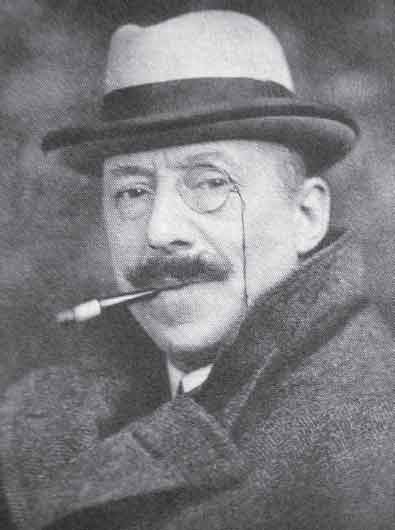
Mervyn O’Gorman.
The selection of O’Gorman fitted perfectly with the desire of R.B. Haldane, as expressed in Parliament, to appoint a, ‘practical man, a civilian and an engineer’53 and had been made on the recommendation of Lord Rayleigh. It was believed that he was better suited than Capper to work closely with the scientists serving on the Advisory Committee for Aeronautics and also at the National Physical Laboratory. It was also thought that as a civil servant he would be free of the malign influence which senior military and naval officers, opposed to aviation in any shape or form, could (and did) exert on colonels and captains. Flight Magazine welcomed the appointment:
‘Important changes have, as our readers are aware, taken place in connection with the control of the various departments associated with military aeronautics, the outstanding departure having been the appointment of a civilian, Mr Mervyn O’Gorman – a well-known consulting engineer and automobile expert – to the post of superintendent of the Military Balloon Factory. Hitherto, Colonel Capper succeeded, out of his indomitable energy, in looking after this large and important work in addition to his proper duties as commandant of the Military Balloon School, which in wartime provides the balloon companies that are attached to the fighting forces. How one man could ever be expected to run a factory, design dirigibles, aeroplanes, and other such machines, in addition to instructing soldiers in the art of aerial warfare, is somewhat of a mystery, but Colonel Capper made an attempt that has gone a long way towards laying the foundation of what we hope will in time develop into the finest military equipment in the world. Now that the two departments have been separated, each should progress apace; it is, as we have mentioned, only necessary to look from the roadside to see that developments have already taken place since Mr Mervyn O’Gorman’s accession to the office of superintendent of the factory.’54
There is no doubt that ‘O’G’ was one of the most important figures in the development of aviation in Britain, and set it on a path of sound science and engineering. Not only was he talented himself and filled with an abounding energy, he had the gift for choosing good subordinates and gaining their loyalty. One of the most successful of his recruitments was F.M. Green, who became chief engineer in January 1910.
The Royal Navy’s First Airship
Meanwhile, in February 1909, the Committee of Imperial Defence had recommended that £35,000 should be spent on a rigid airship project for the Royal Navy in order to ascertain what its full potential might be; as had been done a few years before in respect of experimental submarines, while the army should concentrate on non-rigid airships for which £10,000 was allocated, and that the development of aeroplanes should be left in the hands of private enterprise.55 This was a triumph for Captain Bacon, who had been under the direct instructions of the First Sea Lord, Admiral Sir John Fisher, whose aim had been to secure this funding. It also represented a degree of success for General Nicholson, as some of the impetus for army aviation was kicked into the long grass. Haldane would bide his time. The naval airship order was announced in parliament by Reginald McKenna, the First Lord of the Admiralty, in March 1909:
‘The question of the use of dirigible airships for naval purposes has been under consideration for some time and it has been decided to carry out experiments and construct an aerial vessel.’56
It was noted in the report of the Committee of Imperial Defence that captive balloons and, to a lesser extent, kites, had for many years formed a part of the regular equipment of all modern armies. Great progress with regard to dirigible balloons, particularly in France and Germany in recent years, was remarked upon. With regard to the future use of dirigibles in naval warfare, reliability; ease of mooring; endurance; speed relative to surface vessels; sufficient crew accommodation to allow relief personnel to be carried; a wireless telegraphy set and navigational facilities, were considered as essential. It was added that accurate sights had been obtained by officers at Barrow, using a German bubble artificial horizon device fitted to an aeronautical sextant. The principal use was advocated as scouting and fleet protection at a much lower unit cost than a 3rd Class cruiser or a destroyer. The utility of an airship for dropping explosive devices was considered as unproven. The future use of fixed-wing aeroplanes was also thought to be unproven, particularly with regard to mechanical reliability, carrying capacity, the ability to operate at height and to fly in unfavourable weather. It was also thought that the endurance of aeroplanes would be affected by the physical strain on the ‘driver’. Future combat between airships and aeroplanes was also considered, it being decided that there was no concrete proof at this point as to which would prevail.57
On 7 May a tender from Vickers was accepted.
A construction shed was built at Cavendish Dock, Barrow-in-Furness, and it was agreed that the design would be by a consortium of naval officers and Vickers engineers. It must have seemed a very promising career path to Neville Usborne, being taken out of the midst of his generation of officers to take part in a project supported by the First Sea Lord. As well as Murray Sueter, who was in command, and Usborne, the third member of the naval team in the early days was Chief Artificer Engineer A. Sharpe, RN. They were joined later by Commander Oliver Schwann, RN, as Assistant Inspecting Captain of Airships, Lieutenant C.P. Talbot, RN, and Engineer-Lieutenant C.R.J. Randall, RN. The Vickers technical team was controlled by Charles G. Robertson, the Marine Manager at Barrow, who had no prior, ‘experience of aeronautics, nor of the light structural work involved’.58 One of his senior assistants was the mathematician, H.B. Pratt, who calculated the airship in its final configuration was not strong enough to bear the load that would be imposed on it; his advice was ignored. There was little technical knowledge available; therefore construction was very much on trial and error lines. It was a highly ambitious project, with a length of 512 feet (155 metres) and a beam of 48 feet (15 metres); it was as large as any of the Zeppelins constructed so far. Its frame was made of forty transverse twelvesided rings, each connected by twelve longitudinals. Beneath the frame was a triangular keel with an amidships cabin. Inside the framework were seventeen gasbags filled with hydrogen and which had a total gas capacity of 700,000 cubic feet (19,810 cubic metres), each had two valves (of Parseval design) at the top, one automatic, the other manual. They were manufactured by Short Brothers of rubberised fabric imported from Germany. The framework was to be fabricated from an entirely new and untried aluminium alloy, Duralumin, which offered the strength of steel at one third of the weight, and which had been developed in Germany and introduced only very recently. Vickers had considerable difficulty in working it. Originally, the internal bracing wires were also made from Duralumin, but repeated breakages during construction meant they had to be replaced with steel. The silk outer skin, which was waterproofed using an aluminium-based dope, was silver grey on the upper half and yellow below; in order to make the topside as far as possible a non-conductor of heat and so minimise the effect of the sun’s rays on the expansion of the gas, while encouraging the conduction of heat underneath to facilitate the equalisation of temperature between the gas and the surrounding atmosphere. Streamlining was employed with the main body being cylindrical, tapering towards the somewhat blunter nose and tail. Four stabilising fins (two vertical and two horizontal), two sets of quadruplane rudders and two sets of triplane elevators were mounted at the stern. The control surfaces were not hinged, but used Short’s Reversible Patent Aerocurve, which flexed. There was a further elevator under the bows and another rudder to the rear of the aftermost of the two underslung cars, made from mahogany sewn with copper wire and which were connected by a gangway. The original idea was for a long-range scouting and gunnery direction platform to assist the main battle fleet, equipped with wireless telegraphy (WT) which was as much in its infancy as aviation. There was some discussion concerning the possibility of arming the airship with ‘locomotive torpedoes.’59 From an early date, officers of the Royal Navy had been interested in the possibility of using aircraft to deliver torpedoes. This was recorded in Air Publication 1344, History of the Development of Torpedo Aircraft:
‘In the early part of 1911 many discussions concerning the use of torpedo aircraft took place amongst our Naval Officers, Captain Murray Sueter, RN, Lieutenant N.F. Usborne, RN, Lieutenant Hyde-Thomson, and Lieutenant L’Estrange Malone, RN, were amongst those who were particularly interested in this subject. It will be remembered that at that time aircraft were entirely in their infancy; they could hardly carry a passenger, and the idea of carrying a large weight was almost incomprehensible; their use as a weapon was only vaguely discernible. The rigid airship Mayfly was at this time being constructed at Barrow, and the naval officers under Captain Sueter, RN, employed on this work, frequently discussed the prospects of torpedo aircraft. The possibilities were vividly represented by the late Commander N.F. Usborne, RN.’60
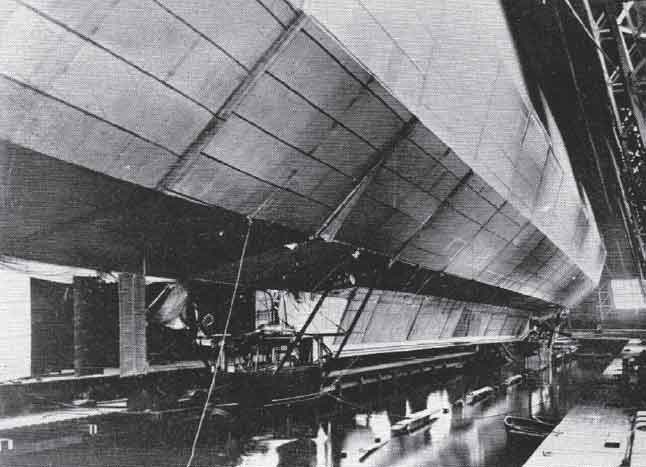
HMA No 1 under construction at Barrow.
Captain Murray Sueter, who was described subsequently as, ‘a brave new warrior of the machine age who had gone, with enthusiasm, from working on submarines and torpedoes, to flying machines and motor vehicles,’61 was appointed Inspecting Captain of Airships, to oversee the design and production of the airship, and so assembled a team of technically minded and promising officers.
The aviation press reported on 30 July 1910:
‘Secrecy at Barrow. EXTRAORDINARY care is being taken at Barrow-in-Furness to ensure that no details with regard to the big naval dirigible under construction there shall leak out. The shed is closely guarded by Marines and only those employed on the work are allowed to enter. It is said that recently a man was found inside the barricade, and, on being taken to the police court, was sentenced to two months imprisonment, although it was not suggested that he was a spy.’62
A report has survived covering the period from 26 September 1910 to January 1912, when Lieutenant Usborne served under Sueter. He was appointed to HMS Hermione for Naval Airship No 1. Hermione was a small 2nd Class cruiser which was intended to act as a sea going depot ship for the airship, which was going to be named Hermione, but is better remembered now by the nickname bestowed upon it – Mayfly. HMS Hermione proceeded from Portsmouth to Barrow in September 1910 under conditions of great secrecy – as indeed was all work in the airship shed. Sueter made a significant entry in the ship’s logbook on 25 October:
‘Airship Officer of the Day is to keep herein a careful record of all work carried out in connection with the airship. Lt Usborne is to generally supervise what is entered to ensure that the record is accurate.’63
Sueter’s later report stated:
‘He has conducted himself with sobriety and to my entire satisfaction. A very zealous and capable officer, he has worked hard in making himself an expert in aeronautical work and has considerable knowledge in this line. I have strongly recommended Lieutenant Usborne for promotion. He was selected as captain of Naval Airship No 1.’64
According to a contemporary and more senior officer, Usborne made many useful technical contributions. Indeed, he applied for Aeronautical Patent 6150 ‘Dirigible Airships’ in 1910, which concerned a system to conserve, as a buoyancy aid, the water vapour given off in the process of the combustion of petrol and air.65 Commander E.A.D. Masterman went on to write:
‘He would then have been about twenty-seven years of age, close on his half-stripe as Lieutenant Commander RN. It is no exaggeration to say that of that collection of officers, many of whom were brother torpedo men, his was the outstanding personality. Nothing was decided without his advice and few things undertaken of which he disapproved. His was the knowledge, slight though it now appears, for undertaking the construction of a rigid airship larger then any existing, his the brain and the ingenuity in overcoming unforeseen obstacles and his the drive which he continually brought to bear on Messrs Vickers when the firm demanded time to set matters going and on anyone else connected with the progress of the great experiment. He was the expert and revelled in so being.’66
What was he like? Masterman stated:
‘In appearance he was rather below normal size, a slightly prominent nose, blue eyes, sandy coloured hair and very forcible expression. He hardly ever spoke without emphasis. He had a dominating personality with a vital spark, most difficult to withstand in argument. Not sparing of others, but himself prepared to do as much, or more, than he demanded of them. He was interested in spiritualism, socialism and new thought, music and motor bikes. He was abstemious in his pleasures, very self-disciplined, lived for work, talked, thought and dreamt airships, kept himself very fit. He indulged in ‘height training’, climbing to high parts of the shed or scaffolding and making perilous walks.’67

Lt Cdr N.F. Usborne about 1913 or 1914.
Developments elsewhere while Naval Airship No 1 was under construction
In April 1909 the Parliamentary Aerial Defence Committee was formed to exert pressure upon the government to improve the measures and resources provided for the aerial defence of the nation. An early result of its effectiveness, but not necessarily its sound judgement, was announced in June 1909:
‘AIRSHIPS FOR THE NATION.
‘In connection with the combined efforts of the Morning Post, Daily Mail, and the Parliamentary Aerial Defence Committee to provide the nation with the beginning, at least, of a fleet of airships, we summarise the chief items of the information which has been made public regarding the projects in hand. The new Clément-Bayard airship, on which the Parliamentary Committee has secured a month’s option, is to be about twice the size of its predecessor. According to Mr Arthur Du Cros, MP, the Secretary of the Committee, the length of the envelope will be 300 feet, and the cubic capacity about 227,500 cubic feet. This should provide for the carrying of twenty-five passengers, but during the trip which it is proposed to make from Paris to London, probably only six will be on board, consisting of M Clément, Mr Arthur Du Cros, and the crew of four. This, however, is not definitely settled, except so far as relates to the crew, which will include the pilot, two helmsmen – one for the elevating planes and one for the rudder – and the engineer. Instead of a single engine and propeller, as in Clément-Bayard No I, the new vessel will have two propellers, one on each side of the hull, and each will be driven by a motor of 220 hp. Sufficient petrol can be carried to enable the airship to travel 700 miles, and it is capable of ascending to a height of 6,000 feet. The vessel is still only in sections, but the work of completing her is being pushed on as fast as possible and it is hoped that she will be ready to make the trip to London at the end of August. Since he made his first trip in the original airship last October, it has been a cherished wish of M Clément to be the first man to visit London from abroad by airship. Although he had not contemplated remaining with his vessel in Great Britain for more than a few days, in view of the offer from the proprietors of the Daily Mail to provide a shed for the accommodation of the airship, he has readily acquiesced in the suggestion that he should remain for a month, so as to give as great an opportunity as possible for Members of Parliament and government officials to make themselves thoroughly acquainted with its possibilities. On one day, too, the general public will be enabled to see the airship, for the Aerial League have arranged with Mr Arthur Du Cros to have it on exhibition for that period. With regard to the shed for the airship, towards the cost of which the Daily Mail have so generously supplied £5,000, Mr Herbert Ellis has been entrusted with the work of designing it, and he has visited France in order to make himself acquainted with the sheds already erected there. M. Clément’s own shed is constructed of galvanized iron lined with cork, so as to keep the temperature fairly even both in summer and winter. He suggests that the dimensions of the building should be 300 feet long, 90 feet high and 75 feet wide. With regard to a site for the shed, the War Office have had under consideration the question of providing this, and both Farnborough and Salisbury Plain have been suggested as possible locations, but it is hoped that a suitable piece of land may be obtained nearer London.’68
The Daily Mail in fact raised £6000 for the construction of an airship shed at Wormwood Scrubs, on land provided by the War Office and a private donation of £5000, in what might be described as a fit of misguided, patriotic enthusiasm, had enabled the ordering and purchase of an airship from the French Clément-Bayard Airship Co.
On 19 February 1910, in the House of Commons, the Secretary of State for War, R.B. Haldane, made the customary speech introducing the army estimates for the forthcoming year. He took the opportunity to clarify the government’s policy with regard to aviation:
‘I want now to say a word about dirigibles and aeronautics. The aeronautical department at the National Physical Laboratory got to work almost at once after it was set up last year, and since then it has been found necessary to increase its staff, and the work at Teddington is in full swing. We have also reorganised the construction department at Aldershot, which used to be under the care of Colonel Capper, who did remarkably good work. We want Colonel Capper’s great abilities, however, for the training of officers and men at the Balloon School, and for the work which he has hitherto done we have got hold of a man of great capacity and high eminence, Mr O’Gorman, who is very well known in connection with the construction, not only of motor engines, but other subjects connected with motoring. Mr O’Gorman has now organised a construction department at Aldershot. The next step we propose to take – and we have already decided on its lines – is to substitute for the present corps a regular aeronautical corps, such as exists in Germany, separate from any other corps in the army, devoted to aeronautics. The Balloon School will become the training school for that corps. I am convinced that until we get everything perfectly clear we shall only make very slow progress. The results of the investigations of the committee presided over by Lord Rayleigh are now being used for the designs we are now engaged upon. At present we have one small dirigible at Aldershot, designed by Colonel Capper, (Baby/Beta) which so far has been doing well, and two more are coming from France. There is the Clément-Bayard, the negotiations for which have been undertaken by the Aeronautical Committee of the House, and, if they are satisfactory, it is not impossible that the War Office may purchase it. There is also the Lebaudy, which, through the patriotism of the Morning Post, has been offered to us. It is coming over before long. We are also working on designs of a large dirigible of our own (Gamma) which I hope will be completed, certainly commenced, in the course of the financial year. Then, of course, there is the great naval dirigible, which is rapidly approaching completion at Barrow, and which, I believe, will be launched in the summer. As soon as we have made ourselves masters of the lessons which these teach, we shall go on working at the construction of other dirigibles and shall be in a position of having a fleet. The whole subject is in its infancy. I am never alarmed by reading about the progress of other nations in this respect. Already much of the material possessed by foreign nations is being found to be unsatisfactory, and I have not very much fear that if we put our backs to it we shall find ourselves ahead.’69
It was reported in The Times of 7 April 1910, that Lieutenant Neville Usborne, ‘who had been superintending the construction of the naval dirigible,’ had travelled from Barrow to Paris and would return in the Clément-Bayard airship, taking charge of navigation as soon as the vessel was over British soil. In May it was noted that he was still in France attending the trials.70 Furthermore, Captain Bacon warned him that when crossing the Channel on no account should any mock attacks be made on any of His Majesty’s ships they might fly over.71 Sadly, delays to the programme foiled this plan, no doubt to Usborne’s great disappointment, as he had first been given the Admiralty’s permission to travel to France in connection with the airship project as early as September 1909.72
On 16 October 1910, the first airship flight from France to the UK was made by Baudry’s Clément-Bayard II from La Motte-Breuil to Wormwood Scrubs, some 246 miles (398 km) at an average speed of 41mph (64kph). The craft had a length of 251 feet (76 metres), a diameter of 43 feet (13 metres) and a capacity of 247,200 cubic feet (7000 cubic metres), being powered by two 120 hp (90 kW) Clément-Bayard engines. A photograph of the airship’s arrival graced the front cover of Flight Magazine of 22 October 1910 with the caption:
‘PARIS TO LONDON BY AIRSHIP.—The arrival of the Clément-Bayard airship at Wormwood Scrubs on Sunday last. Note the sand ballast being thrown out in order to check too rapid a descent in landing. The military helpers are seen in the distance in readiness to receive the airship immediately it arrives within reach.’
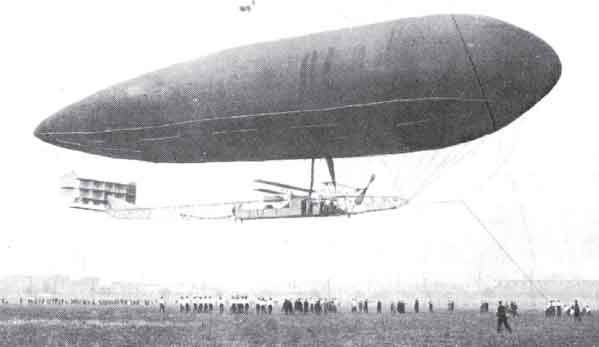
The Clément-Bayard II lands at Wormwood Scrubs.
The airship thereafter was a complete disaster; it had already made more than forty ascents in France, the envelope leaked badly and an argument over payment with the manufacturers ensued. Eventually, half of the originally agreed price of £25,000 was paid. She was dismantled and taken to Farnborough, never to fly again. Had she done so she would have been re-named Zeta.73 The War Office had announced to the House of Commons certain requirements which it desired Clément-Bayard II to meet. These throw light on what was then considered to be the ideal airship for military purposes and are reproduced in Appendix 4.
Not to be outdone, a rival newspaper, the august Morning Post, organised in its columns a National Fund which raised £18,000 to acquire a second French airship, from Lebaudy-Frères of Soissons, announcing the success of this venture on 21 July 1909 and described as, ‘a real war-type of dirigible, than which no more up-to-date model exists throughout the world.’74 (Paul and Pierre Lebaudy, together with the engineer Henri Julliot, had been building airships since 1902, including the first dirigible supplied to the French Army in 1906, to which three more had been added by 1909, including République, which was the first to be used by the French Army on manoeuvres.)
The Morning Post Lebaudy first flew in France in August, at which time Colonel Capper and a Daily Mail journalist, Hamilton Fyfe, were up in her.75 When she arrived on 26 October 1910, she was the largest airship to have been seen in Britain to that date; being 337 feet (102 metres) long, with a diameter of 39 feet (12 metres), a capacity of 353,000 cubic feet (9990 cubic metres) and was powered by twin 135 hp (100 kW) Panard engines, which gave a top speed of 34mph (55kph). In fact helpful winds on its Channel crossing, with a crew of seven, enabled it to average 36mph (58kph). One of those on board was Major Sir Alexander Bannerman, RE, ‘a stout, moustached, dyed-in-the-wool officer’76 who had succeeded Capper at the Balloon School a fortnight earlier, despite knowing little about airships or aeroplanes, but possessing, ‘a certain amount of practical experience in ordinary gasbag ballooning,’77 and an absolute belief that attack from the air would be a hit and miss affair, with the likelihood that not one bomb in 10,000, from a height of 5000 feet (1524 metres), would hit a battleship.78 In the opinion of one aviation historian:
‘The War Office attitude was demonstrated still further in its treatment of the purely military Balloon School. Colonel Capper retained his post until he became due to promotion from brevet to substantive rank on 7 October 1910. The War Office refused to let him continue as commandant at this higher rank, but instead downgraded the post to that of major, and appointed Major Sir Alexander Bannerman as his successor.’79

The Lebaudy airship arrives at Farnborough on 26 October 1910. (Via Ces Mowthorpe)
Colonel John Capper (1861–1955) became the Commandant of the Royal School of Military Engineering at Chatham, so removing an air expert with a worldwide reputation from direct involvement in military aviation. He served throughout the First World War as a Corps Chief Engineer, Divisional Commander and Director General Tank Corps, attaining the rank of major general and a knighthood.
The Lebaudy was no more successful than the Clément-Bayard II. Unbeknown to the authorities at Farnborough, the designers had increased the height of the airship, with the result that as it was being walked into its specially built shed, the envelope caught on the roof and suffered a serious tear. (This is described in full in Appendix 5.) Repairs (and alterations to the shed) took several months. When it flew again in May of the following year, with a French test crew in control and Major Bannerman in attendance, all went well at first, with Cody and Geoffrey de Havilland circling around the airship in their aeroplanes. But after about an hour in the air it proved to be unmanageable, and it descended and crashed out of control, tearing down telegraph poles and uprooting railings in its path, and in front of a large crowd which had come to watch the spectacle, luckily without killing or badly injuring anyone.80 After another Franco-British argument the airship was scrapped. So ended: ‘A sad and ridiculous chapter in British aeronautical history.’81 R.B. Haldane may well have been tempted to say, ‘I told you so’ as the two debacles certainly vindicated his view of a measured scientific approach as opposed to buying something foreign off the shelf just because it was there.
A purely civilian enterprise had much greater success, as on 4 November 1910, E.T. Willows and Frank Gooden made the first crossing of the English Channel by a British aircraft in the Willows No 3 City of Cardiff, which was 120 feet (36 metres) long, 23 feet (7 metres) in diameter and with a capacity of 32,000 cubic feet (905 cubic metres). Departing from Wormwood Scrubs they crossed to Douai, where they force-landed. The airship was deflated and repaired at the Clément-Bayard works and then flew to Paris on 7 January 1911, where it undertook a number of passenger-carrying flights:
‘The Willows Trip to France.
‘In view of the way in which foreign aviators are treated when they happen to land on British soil, it is instructive to note the treatment meted out by our neighbours across the Channel when a Britisher happens to land there. On Mr Willows coming down at Corbehem, near Douai, in order to discover his whereabouts, he was rather surprised when three gendarmes mounted guard over his ship, and an officer demanded the payment of about £30 Customs duty. Matters were eventually smoothed out by the Aero Club of France, who explained that the incident arose simply owing to the fact that notice had not been given to the Customs authorities, who were bound to act as they did. The airship was brought out from the Daily Mail garage at Wormwood Scrubs on Friday afternoon, and, with Mr E.T. Willows piloting her, assisted by Mr W. Gooden in charge of the engines, a start was made at 3.25 pm. Steering straight across London, the aeronaut then made for Bexhill, and at 6.35 the English coast was left behind. Two hours later the French coast was in sight. At 10 o’clock the vessel was taken to a height of 5,500 feet, in order to enable Mr Willows to steer by the stars, as the clouds prevented him picking out the places passed over. Later, the weather became very foggy, and at 2 o’clock in the morning Mr Willows decided to bring his craft down. Mr Willows had no idea where he was, but when the two aeronauts had got the machine on the ground safely anchored they found a peasant and sent him off to the village to get help. The framework of the car was somewhat damaged in the landing. M Breguet, whose flying ground at La Brayelle is not far off, motored over to render what aid he could to Mr Willows, and afterwards, when making a second visit, he flew over in his aeroplane. Mr Willows had intended, after repairing his machine, to complete the journey to Issy, and a large crowd gathered there on Sunday afternoon to welcome him. The weather conditions, however, changed in the meantime, so that Mr Willows deemed it advisable not to go on. He therefore had his balloon deflated, packed up and sent to Issy by rail, where it found a temporary home in M Clément’s dirigible shed.’82
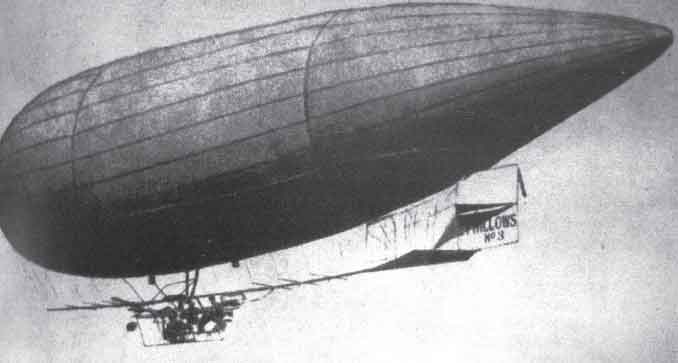
Willows No 3. (Via Patrick Abbott)
Willows himself was hopeful that the government would support his efforts by ordering an airship from him. The venture had at least raised his public profile and increased his expertise in airship handling. He was reported in the press as commenting, ‘Of course, I have obtained experience which would be of great value in training men in the handling of small dirigibles and by this means the best results are obtained afterwards in the handling of the larger class. This, I think, is the lesson to be learned from the numerous disasters to the Zeppelins.’83
Meanwhile, the army’s airship men had been making some progress. The unsuccessful Baby had been transformed into the Dirigible IIa, soon renamed Beta, which had been completed in February 1910. It is worth noting that in this month a survey noted that there were twenty-six airworthy airships in the world, fourteen in Germany, five in France, two in Italy, and one each in Great Britain, Austria-Hungary, Belgium, Russia and the USA.84 Beta’s envelope was that of the Baby increased in length by 20 feet (6 metres) and it now had a volume of 35,000 cubic feet (990 cubic metres). The car was composed of a long frame, having a centre compartment for the crew and engine. The 35 hp (26 kW) Green engine was retained in an improved form, driving two wooden two-bladed propellers by chains. Beta was fitted with an unbalanced rudder, while the elevators were in the front of the frame. A contemporary account described it as being many times larger than its predecessor, having the appearance of a fish and being coloured dead chrome-yellow from end to end. The reporter judged that it appeared to be thoroughly under control from the moment of its ascent, throughout an hour-long flight in the vicinity of Farnborough until it returned to its shed, which no doubt would have gratified the aeronaut in charge, Colonel Capper, assisted by Captain King, Mr Green and Mr McQuade, the Works Manager.85 Further test flights were made in March by Captain Carden and Lieutenant Waterlow, which encouraged thoughts of a longer voyage.86 In this they were successful. On 3–4 June 1910, they flew to London and back during the hours of darkness, with a crew consisting of Colonel Capper, Lieutenant Waterlow and Mr T.J. Ridge of the Balloon Factory, taking about three and a half hours for the round trip; the first night flight:
‘The ascent was made at 11.40 pm and the course was set by the stars. When the main London and South-Western railway line was reached, the airship followed the metals until the Brooklands motor track at Weybridge was reached. Then a straight line to St Paul’s was taken, the Thames being crossed three times in its windings. The first crossing at Thames Ditton, the second near Hurlingham and the third near Battersea Park. The dome of St Paul’s was circled and the return journey, with a following wind, was made at top speed, between 25 and 30 miles an hour. The main London to Portsmouth road was struck at Hounslow and proved a splendid guide to the aeronauts, who followed it through Staines and Sunninghill to Farnborough.’87
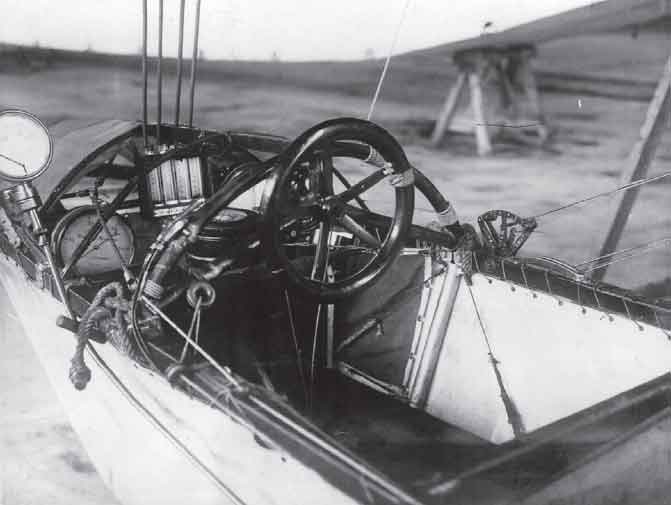
Beta – the pilot’s seat and controls. (Via Nigel Caley)
The flight was followed on the ground by the Balloon Factory’s Chief Draughtsman and Chief Mechanical Engineer in a motor car – but so rapid was the progress made by Beta that they lost sight of the airship not long after it departed from Farnborough Common. Harry Harper was offered a flight in Beta one afternoon:
‘Clad in a suit of overalls which had been lent me, I was given the task of keeping the log of the trip, being provided with an official logbook for the purpose, and a stub of pencil.
‘The engineer crouched in a tiny seat just behind his noisy motor. We other two, the skipper and myself, were poised perilously on a little railed platform, which had two or three boards stretched across a metal frame to form its floor. There was no support of any kind to grip at save a couple of flimsy handrails which, as soon as the engine began running fast, vibrated so much that one could scarcely hold them. The platform too shook violently, and the whole affair was distinctly intimidating.’88
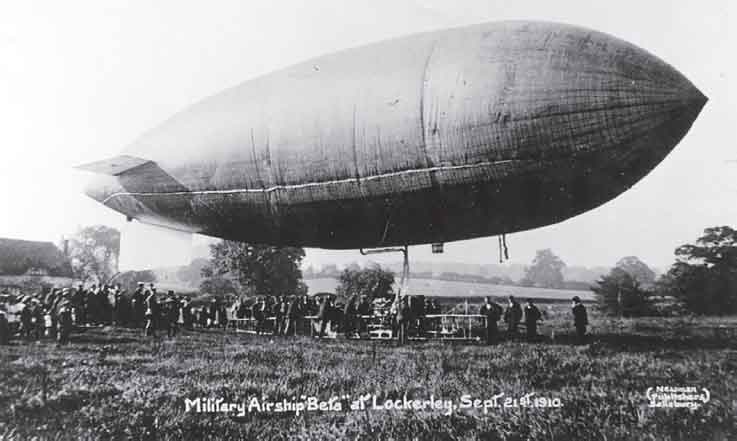
Beta I in 1910. (Museum of Army Flying)
As Harper tried to keep his mind on the task of entering engine data, height and course, his hands, face and the pages of the logbook became covered in a thin film of oil blown back from the engine. Worse was to follow:
‘We began to encounter a gusty, bumpy wind. The little airship began to make bad weather of it, like a small yacht in a rough sea. Up she went at the bow and then down again with a sickening lurch. Then she would roll and give a sort of uneasy wobble. All the time I was clinging for dear life to that bleak exposed platform, trying to prevent myself looking down apprehensively through the cracks in the floorboards.’89
He noted that he was very glad to return to earth, that he had managed to complete all the log entries required and that Beta made a good landing despite the bumpy conditions.
Gamma – the control position. (Via Nigel Caley)
Beta was followed by Gamma, which first took to the air for a 50 minute flight on 2 February 1910 in the capable hands of Capper and Waterlow. Her rubber-proofed fabric envelope had a capacity of 75,000 cubic feet (2122 cubic metres), with an 80 hp (59 kW) Green engine in the extended car driving swivelling propellers, the gears and shafts of which were made by Rolls-Royce. The engine drove the propeller shafts direct, one from each end of the crankshaft, allowing a top speed of 30mph (48kph). The engine gave some teething problems to begin with, but in March, Captain Carden and Lieutenant Waterlow carried out a series of successful test flights.90 Gamma was badly damaged in a spring gale while moored out at Farnborough, but she was fully repaired, so leading to the following report in June 1910:
‘Gamma Out Again. Having had the damage sustained during the recent gale repaired, the army airship Gamma was out for a trial run on Saturday afternoon. Piloted by Lieutenant Broke-Smith, RE, with Lieutenants Cammell and Reynolds, and Mr Green, as crew, the dirigible manoeuvred successfully over Farnborough Common for forty minutes. The only incident was the stampeding of some horses belonging to the Oxford University Territorials, which were apparently frightened by the whirr of the motor as it passed over them.’91
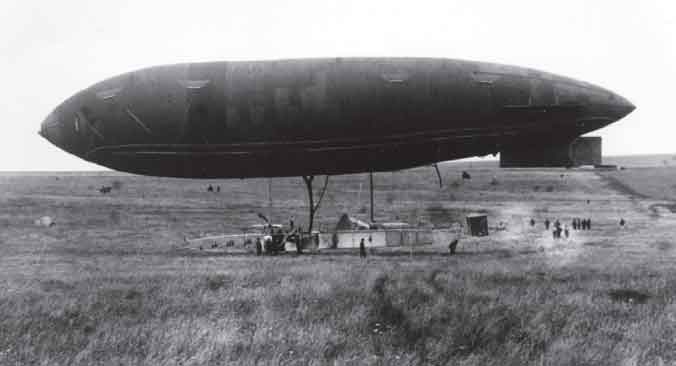
Gamma or The Yellow Peril in 1910. (Museum of Army Flying)
Not long afterwards, the airships received a visit from King George V and Queen Mary, which was described as follows:
‘Army Airships Inspected by the King and Queen. On Monday afternoon, during the time HM the King was at Aldershot, the two army airships, Beta and Gamma were taken out and cruised over from Farnborough. The former then returned to her shed, where she was closely examined by His Majesty, who rode over from the camp. The Queen, who had motored over to Farnborough to see the dirigibles, also had the mechanism of Beta explained. Gamma had some little engine trouble, and descended at Crookham, but later returned to the balloon factory. On Wednesday afternoon both airships were out, Gamma cruising over the vicinity of Guildford, while Beta started off from Farnborough in the direction of Bournemouth.’92
Beta made another visit to London in July, this time in daylight, crewed by Lieutenant Broke-Smith, Lieutenant T.J. Ridge of the London Balloon Company, RE (Territorials), and Sergeant Ramsey, RE. (This was the first Territorial Force air unit and was in existence for five years from 1908 until 1913. Ridge was also the assistant superintendent of the Balloon Factory.) This time navigation was by map and compass, and slow progress was made against a stiff headwind. An average height of 1500 feet (457 metres) was maintained and the conditions were smooth, apart from cross currents encountered over the Thames valley. Once over the city, large crowds stared upwards at the graceful sight as Beta passed over the City of London, the Strand and the Houses of Parliament. The return trip was accomplished at a speed of 35mph (56kph) and, as there was petrol to spare, a detour was made to fly a circuit over the Royal Pavilion at Aldershot, being watched from the windows by King George and Queen Mary. On landing back at Farnborough, the airship’s crew were greeted by cheers from the crowd assembled on the common.93 Later, Beta had a minor mishap, making a forced landing near Andover due to a broken crankshaft. The inherent safety of the airship was demonstrated, as a safe descent was made into a field near a farmyard. Farnborough was speedily advised of the difficulty, and spare parts and mechanics were dispatched by motor car. Soldiers were summoned from nearby Tidworth and Beta was transported to a local foundry, where repairs were effected during the night, so allowing Beta to proceed to Bournemouth the next day.94 Not long afterwards permission was given, with some reluctance, in case that it would frighten the troop horses, for both aeroplanes95 and airships to take part in the army manoeuvres of September 1910, to be held on Salisbury Plain. Instructions were issued:
‘As this is the first occasion on which aeroplanes and dirigible balloons have been employed in this country for military work, their employment is largely a matter of experiment; and as the science of aerial navigation is still in its infancy, unreal conditions, which would not obtain in war, must be observed for the safety of the aeronauts and their machines.’ 96
Given the propensity of troops of the BEF in August 1914 to fire off volleys of musketry at any passing aircraft without waiting to ascertain if it was friend or foe, this was probably timely advice. Beta’s contribution to the manoeuvres was recorded thus:
‘Beta at the Manoeuvres. On Saturday afternoon the army airship Beta returned to Farnborough after a week’s scouting in connection with the manoeuvres at Salisbury. On the previous Monday she sailed over to Salisbury, commanded by Colonel J.E. Capper, RE, and scouted for the “enemy” during the afternoon. A slight mishap with the engines kept her “confined to barracks” on Tuesday, but on Wednesday, Thursday, and Friday, practically the whole of Somerset, Dorset and Wiltshire were covered during reconnoitring operations, going as far west as the Bristol Channel, in all about 1000 miles, and the observations taken are reported to be most accurate.’97
Though Beta was officially neutral, not being part of either the East Land or West Land forces, Capper and his crew were able to watch the troops of both the divisions, to bring despatches, and to communicate with Lieutenant General Sir Horace Smith-Dorrien, KCB, KCMG, DSO, the C-in-C of Aldershot Command. [Smith-Dorrien was more open-minded than many senior officers; he was sure that ‘aerial machines’ would play an important part in future wars and stated at a meeting of the Aldershot Military Society, on 22 February 1910, that, ‘we soldiers must take every opportunity of studying all there is to be learned on the subject’.] The airship passed over the headquarters’ staff, where the officers were able to exchange information and convey from the car of the dirigible a sketch-map of the position of the forces as seen from the airship. Beta spent several nights moored out in the open, under the shelter of trees or in quarries. Mobile support was provided by one of the old ballooning gas trains drawn by a traction engine. On one occasion she was in the air for seven and three-quarter hours without landing, carrying a crew of three. She has been described as; ‘The first truly efficient British service airship.’98 Some senior officers were impressed, General Sir John French, ‘spoke of the keen practical attention with which all far-seeing military authorities had taken up aviation’.99 Others were much less so, the Chief of the Imperial General Staff, General Sir W.G. Nicholson, GCB, ADC, RE, who although a talented administrator and a sapper himself, ‘was of the opinion that aviation was a useless and expensive fad, advocated by a few cranks whose ideas were unworthy of attention’.100 [By 1911 it should be noted that Nicholson had changed his opinion and acknowledged that aircraft would play a part in the next war, ‘whenever it may come’.] A national Sunday newspaper did not mince its words:
‘The trouble at the War Office with regard to aviation is not Major Sir Alexander Bannerman, it is essentially due to the presence at the War Office of an engineer officer of exalted rank, who is not merely frigid towards aviation, but is even violently opposed to the idea that it has any military value. It is unfortunate that a man with such ideas should happen to be in a position in which he is able to place obstacles in the way of every suggested forward step.’101
General Nicholson’s was a voice and personality of great influence in Whitehall, and was singularly intolerant of anyone whose views opposed his. Nor were some of the naval hierarchy any more keen on establishing command of the air, as an anonymous admiral commented; ‘I do not say we do not wish to do so, but I think we will be forced to do so.’102
They would be even less enthusiastic about sharing any co-operation on matters of aviation with the army.
Meanwhile, the French army had also staged its annual manoeuvres in the autumn of 1910, making use of eight fixed-wing aircraft of various types and four airships, Liberté, Clément-Bayard, Colonel Renard and Zodiac. One of the airship pilots of those halcyon days before the war recalled:
‘There were many adventures in the days of the early army airships, but there were no serious accidents and there was no loss of life. Engine breakdowns were not unusual and other failures occurred, such as the propeller chains snapping, the elevators jamming, valves sticking, or fittings coming adrift owing to vibration. Very frequently defects were remedied in the air, whilst the airship drifted free; this sometimes necessitated one of the crew crawling out along the frame, or onto an outrigger, to effect adjustments.’103
Sometimes the drifting plan could be a little dangerous, as on one foggy day when Beta, having just regained the use of her engine, very narrowly avoided coming into collision with the spire of Salisbury Cathedral. On another occasion, as they passed noiselessly over a cricket match, the batsman stared upwards at the airship and lost his middle stump to the bowler who was concentrating on the matter in hand. Broke-Smith also reflected on the methods adopted when a forced-landing was required; the airship would alight in a sheltered spot, protected from the wind and weather, the grapnel being hooked onto a handy hedge or tree, and assistance would then be summoned from Farnborough. The technique of emergency landings became regarded as a matter of routine.
On 4 October, Colonel Capper addressed a meeting of the Women’s Aerial League with an illustrated lecture on airships and aeroplanes. He expressed considerable dismay regarding what he saw as the apathy of Britain as regards the conquest of the air, when compared to the drive and enthusiasm shown on the Continent and in America. He believed that aerial expertise was vital to national interests and urged the women of Britain to wake their men up to, ‘the realities of the matter, as men would do anything for the women.’ He predicted that in future, aerial navigation would be common and that all wars would begin with the conquest of the air, which might result in making war so terrible a proposition for the population that peace would be the outcome.104
Also in October, the War Office announced that the air branch of the army would be expanded and that the Balloon School would be reconstituted. Flying in heavier-than-air machines would be included and officers from all arms would be encouraged. In November the Secretary of State for War, R.B. Haldane, visited Farnborough and was taken for a flight in Beta by Captain Broke-Smith. The minister arrived dressed as for Parliament in his top hat and had to be persuaded that this was not really appropriate flying gear and put on a borrowed flat cap instead.
Later in the year it was decided to purchase a new 110,000 cubic feet (3113 cubic metre) envelope for Gamma, as the one in use was proving to be rather leaky. It was ordered from the Astra Airship Company in Paris. Flying began early in the New Year of 1911 and it was reported that:
‘The army airship Beta made her reappearance on Tuesday last and carried out the first of a series of instructional trips in the neighbourhood of Farnborough. Captain Broke-Smith was in command, and he was accompanied by Major Sir Alexander Bannerman, Commandant of the Army Balloon Factory. A trip of some twenty-two miles was made, during which the little airship behaved splendidly. These trips will be continued at every available opportunity during the coming spring and summer for the purpose of instructing various officers in the science of aerial navigation.
‘On Monday Mr Cody was out, and made several trips with passengers, including Major Sir Alexander Bannerman and Lieutenant Cammell. In one of these trips he chased after the Beta and succeeded in getting past her.
‘On Tuesday the airship was under the control of a non-commissioned officer, whose work was supervised by Lieutenant Waterlow.’105
The report the following week contained an item of greater significance for the future use of airships, Beta, on the night of 27–28 January, was flown by Clive Waterlow, with Captain H.P.T. Lefroy, RE, manning the wireless apparatus:106
‘Beta and Wireless Telegraphy. During the instructional cruise made by Beta on Saturday last, communication was kept up with headquarters at Farnborough by means of wireless telegraphy. The trip lasted for over an hour, and, taking a southerly course, the airship was steered to within a few miles of Portsmouth before turning and making a wide westerly detour via Andover on the return journey to Farnborough.’107
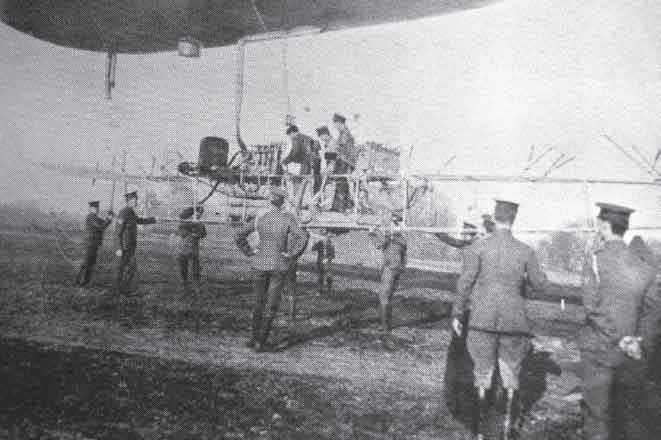
Beta was fitted with a wireless apparatus in 1911.
Lefroy and Lieutenant R.A. Cammell had already undertaken wireless experiments while free ballooning in the Andes from Cove Common to Leatherhead in August 1910.
The success was slightly tempered by the fact that owing to the noise and interference, the engine had to be stopped to enable signals to be received. Lefroy recorded his thoughts on the experiment in his logbook:
‘Petrol pipe on engine burst when half a mile from the Balloon Factory. I at once informed ASX (Aldershot wireless telegraphic station) of this and told him to try and let me know when the engine was not running. He at once started up, and I got very loud signals and read: All your signals good but … and then the engine was off again and I lost the rest. Quite impossible to hear signals (when engine running so close) without any special device, such as soundproof helmet – could not even hear the test buzzer and barely hear the spark-gap; returned to factory and landed safely about 5.10 pm.’108
By February messages were being transmitted and received from Beta up to a range of 30 miles (48 kilometres). Not long afterwards the first Airship Pilot’s Certificates were issued on 14 February 1911 by the Royal Aero Club. The holder of No 1 was Lieutenant Colonel Capper, No 2 was Captain P.W.L. Broke-Smith, No 3 was Lieutenant Clive Waterlow, No 4 was E.T. Willows and No 8 was Captain E.M. Maitland.
HM Airship No 1 Makes Her Debut
On 9 May 1911, Neville Usborne was elected a member of the Royal Aero Club of the United Kingdom (which had been founded in 1901 with the aim of ‘encouraging aeronautics’, and of which Flight magazine was the official organ, supplied weekly to members). Two weeks later Airship No 1 was taken from its shed by a ground party of 300 sailors in the early hours of 22 May, for handling and mooring trials. The logbook noted:
‘At 4.18 am, airship clear of shed. Warped out to mooring post using capstan; capstan seized after a few minutes, hauled out the remainder of the way by hand, with assistance of propellers and of Hermione’s steam cutter. Secured to head of mooring post by bow wire, nose of ship close up to head of post. Wind light and variable. Ship riding lightly, but slewing through about sixty degrees relative to pontoon. Attempted to check this by securing the forward hauling down ropes. During one yaw of airship heard the flange of the channel bar (round which the port hauling down rope was secured) crack cast off hauling down ropes.’109
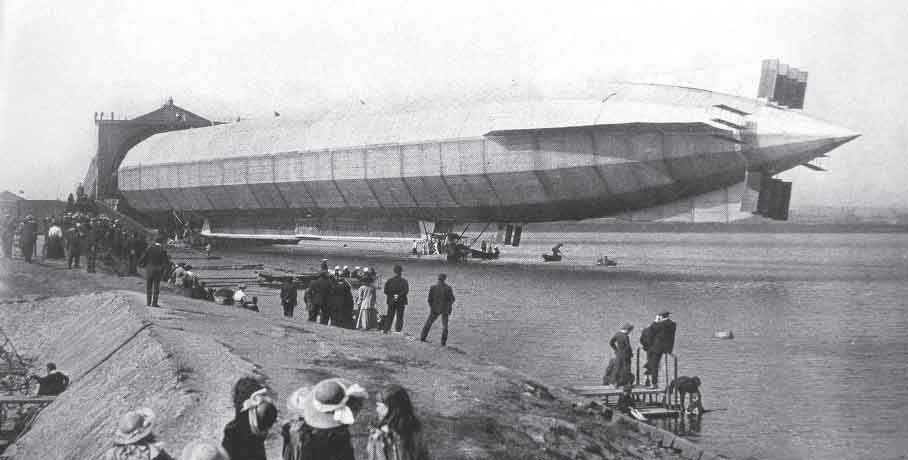
HMA No 1 brought out for first time on 22 May 1911. (Huston Collection)
Extracting the airship from her exceedingly narrow shed was no easy matter and was described as being like drawing a cork from a bottle.110 She was moored to a 38 foot (11.54 m) mast erected on a pontoon in Cavendish Dock. This was the first time a rigid airship had ever been made fast to a mast. By 10.00 am the wind had freshened and the slewing motion had become more intense:
‘Started forward motor and used it intermittently to check the surge forward by running propellers astern. Used twenty feet on bow mooring wire to keep ship clear of yardarms, swinging increased greatly in violence, heavy jerks being experienced, but seeing no damage beyond slight straining of the bow framing. The forward motor overheating, the steam boat was used to keep the ship astern by a long grass line to the after gondola. The use of the motor was reserved for especially bad yaws.’111
Further measures were taken at 1.30 pm:
‘Removed windscreen on mooring post, effect apparently very beneficial. Hung a boat’s anchor, shackle of cable and 12 x 6 in projectiles from stern of pontoon to check it slewing, effect very good. Bossed airship close up to mooring post, yawing much reduced. Removed yards from mooring post.’112

A diagram illustrating the procedure required to manoeuvre HMA No 1 back into its shed.
The onlookers included Flight Magazine which announced; ‘At last our leviathan of the air has emerged from its hiding place into the full light of day.’ The author was in awe of the airship’s size:
‘Think of it! It would almost exactly fill St Martin’s Lane from end to end and from side to side. It can carry twenty-two persons and has cost to date the sum of £41,000. More than an acre and a half of continental fabric was employed in the construction of the envelope, and the hydrogen, compressed in cylinders, was brought from the Knowles Oxygen Co’s works at Wolverhampton by the train load at a time. Its constructors are the great firm of Vickers Ltd. The outer covers and gas ballonets were made by Messrs Short Bros, and the airship is fitted with their patent valves and rudders.’
The sailors’ performance was also appreciated:
‘One of the most striking sights in connection with the launch was the sudden appearance of sailors on the very top of the envelope, where there is a prepared gangway and access to which is obtained by means of a rope ladder through the centre of the envelope itself.’113
Vigilance during the hours of darkness was maintained with the aid of a searchlight which played upon the massive hull. The logbook noted on 23 May:
‘Ship riding easily with very little yawing. Ran each engine thirty minutes, changing air tanks. Took in sixteen gallons of fresh water. Forward girder of transverse frame 14 slightly buckled; partly deflated bags 6 and 8 to bring them to same degree of fullness as bag 7, and to relieve above girder.’114
Further comments made the next day included:
‘Ship riding easily, yawing very slight. Wind gradually decreased to Force 3. Took in 8000 cubic feet of hydrogen from bottles placed in cutter. Crew cleaning ship and undergoing instruction in starting up motors, trimming system, etc. Cast off steadying boats, the wind freshening and the boats causing much bumping of the gondolas and straining of hull.’115
The trials were successful in that the airship withstood winds of up to 45mph (72kph). Moreover, engine tests were conducted, and a considerable amount of handling experience and data was collected by the nine officers on board, their only complaint being that they had not been allowed to smoke! The Chairman and Directors of Vickers wrote to Captain Sueter on 24 May 1911 to congratulate him on the achievements so far:
‘I am exceedingly pleased to receive your letter of this date, stating that we have established a world’s record in building an airship which has successfully withstood the heavy gale of last night while moored in the open. The Chairman and Directors take this opportunity to heartily congratulate you on the successful launch of the ship, and likewise on the splendid well-thought-out arrangements made by yourself, resulting in her being so safely and satisfactorily moored. At the same time, it was felt that the heavy breeze during the first night after the launch must have given you a somewhat anxious time. I thank you on behalf of myself and our experts for your very kind observations which are, you can rest assured, greatly appreciated. Will you kindly permit me to place on record how very much we esteem the hearty collaboration of your good self and your staff in the building of the first airship for the British Navy, and to state how confident we are that a considerable amount of the success which has been achieved is due to the invaluable assistance so readily rendered at all times by yourself, your officers and your men.’
Yours sincerely,
J. McKechnie116
For obvious reasons the company was very keen to develop the best possible relationship with the Royal Navy in general and with Murray Sueter in particular; it was just as anxious as Sueter that the airship being constructed at Barrow would merely be the first in a lucrative line of repeat contracts. Sueter made repeated attempts to convince the First Lord of the Admiralty, Reginald McKenna, that this should be the case, but was advised that the First Sea Lord, Sir Arthur Wilson,117 was very much against airships, believing that they could easily be destroyed by a ‘squib’ fired by pistol from an aeroplane at close range, or by means of a fishing line and hooks raked along the gasbag.118 Indeed, somewhat dishearteningly, he received more than one letter from Rear Admiral Sir John Jellicoe, the Controller of the Navy and Third Sea Lord, during this period, alerting him to the fact that others in high authority at the Admiralty did not believe in airships.119
[Author’s note: Wilson (1842–1921) won the VC at the battle of El Teb in 1884, but was not by nature inclined to favour technical progress, for example, describing the early submarines as, ‘underhand, unfair and damned un-English’.
Sueter praised Fisher and Jellicoe highly for their support, but had little time for most of the other Sea Lords. He also felt that three First Lords of the Admiralty had been particularly ‘air-minded’, the competent McKenna (1908–1911), the mercurial Churchill (1911–1915) and the philosophical Arthur Balfour (1915–16). On the other hand, Churchill, though a supporter of Sueter and his dynamism, was not blind to his faults, writing to the First Sea Lord, Prince Louis of Battenberg on 12 December 1912, ‘Captain Sueter requires supervision.’]120
On 25 May, preparations were made to return the airship to its shed; the first attempt at 5 am had to be abandoned due to the wind picking up. The crew tried again in the afternoon, when the wind had abated:
‘Airship slipped from mooring post; drifting towards northern bank of dock. Steamboat made fast a line to starboard bow of airship to haul her to northward, but could make very little impression. By using warp, forward propellers and the steamboat hauled airship clear. Airship then hauled over towards shed, using warp and propellers, rudders amidships. The airship’s bows were hauled close in to the entrance of the shed, but with the wind being from her port bow to her port beam, considerable difficulty was experienced in getting the airship in line with the shed. The thwarts, specially strengthened, of the steadying boats, to which the shore hawsers were secured, started to pull out; spars were improvised from the shore hawsers to the heels of gondola struts, which averted the collapse of the boats and letting go of the hawsers. The force of the wind on her port side caused the ship to heel fifteen to twenty degrees to starboard. The stern of the ship was eventually, with much difficulty, hauled in line, and the ship secured to the jackstay, guys from the top of the ship got hold of, and the ship righted. The ship was then hauled along the jackstay into the shed, slight difficulty being caused by one or two jackstay outriggers being carried away. Airship housed in shed 3 pm, total damage, a hole in the forward gondola by wooden distance pieces of steadying boat.’121
But it soon became clear that HMA No 1 was overweight and incapable of static flight, even with the power provided by a pair of 200 hp (148kW) 8-cylinder Wolseley engines driving a pair of four-bladed propellers to port and starboard, and a twin-bladed propeller to the rear. Gross lift was estimated to be 19.665 long tons (44,048lbs/19,980kg), with the weight being 19.589 tons (43,876lbs/19,902kg), not including fuel or crew. The resulting disposable lift of 0.076 tons (77.22kg/170.24lbs) was utterly negligible. The options were to insert another bay and increase the lifting capability, or to lighten ship. The latter was chosen, the external keel and many other items were removed – including the water recovery apparatus, the mooring chain and the anchor! The disposable lift was thereby increased to 3.21 tons (3,261kg/7,190lbs), which would be enough for trial flights and training.

Mayfly at Cavendish Dock. (VSEL; now part of BAE Systems)
Murray Sueter paid tribute to Usborne’s work in this connection: ‘The late Commander Neville Usborne also schemed out a very efficient water-recovering apparatus by cooling the exhaust gases of a petrol engine. I believe he was the first in this country to experiment in a practical manner in this direction. In this way we regained in water a very high percentage of the petrol consumed by cooling – over a large surface – the high-temperature exhaust gases from the petrol motor.’122
Sueter reported to the Admiralty on 20 August that he had refused to accept the airship from Vickers, stating:
‘On Thursday I balanced the airship when floating freely in air in the shed and suggested some alterations. On Saturday evening I again balanced the airship in the shed and found that we could reach 500 feet altitude with the airship, but would only have some 150lbs of ballast for discharge in fore gondola. This I considered inadequate and refused to accept the airship. The framework, as altered, supports the gondolas in the air without any sign of the girders buckling. At a conference with Messrs Vickers representatives this morning, I stated that the Admiralty requirements by specification were one ton petrol and one ton ballast with the ship trimmed properly. Messrs Vickers are now considering what to do. It is not proposed to accept the airship until the lift by specification is obtained.’123
Another problem as a result of the delays and alterations was that the airship now needed to be inflated with ‘new hydrogen’. Sueter concluded his report by asking if the Admiralty would pay for this, or should the extra cost of some £150 be charged to Vickers, who was now making it quite plain to him that the company was, ‘considerably out of pocket’.
The aviation press reported as follows:
‘Our Poor Naval Airship. In spite of hopes that the naval airship might have been given another airing, she is still kept most religiously inside the shed at Barrow, and rumour has it that, as a result of a visit of the Advisory Committee on Aeronautics, the great envelope of the airship will be cut in half and considerably lengthened in order that she may carry more weight. Apparently she is not quite capable of lifting the twenty tons for which she was designed, and either the buoyancy will have to be increased, or the weight will have to be cut down.’124
On 24 September 1911, she was taken out of the giant shed again, tail first. Just as the nose was clearing the hangar doors, a strong gust of wind caught the massive airship and rolled Mayfly virtually on her beam-ends. Shortly after righting herself, the hull of the airship abruptly tore apart forward of the rear car. Her back was broken – overstressed without the stiffening and support of the keel. HMA No 1 was a wreck, and became the subject of much negative publicity about being a waste of an eventual total of £100,000 of taxpayers’ money:
‘It scarcely needed the lesson of the collapse of Naval Dirigible No 1 to demonstrate the elementary fact that the big dirigible is a failure. We had learnt that from the experience gained with the Morning Post Lebaudy and the almost equally unfortunate Clément-Bayard, so that we can scarcely feel surprised at this latest catastrophe. On this side of the Channel the dirigible has been, not to put too fine a point upon it, an utter failure; and on the Continent it has been very little better in spite of the long voyages under favourable conditions which have been accomplished. Before the aeroplane became the highly efficient organism it is today, it was natural that the lighter-than-air type of flying machine should have attracted a great deal of attention from those who were seeking dominion over the air. The type of craft evolved was admittedly crude and cumbrous, but it was the best we could do, and at any rate it was capable of making ascents, and in good weather, of being navigated to a set course instead of being at the absolute mercy of the lightest air that blew. The school which believed in the gasbag as the airship of the future held, and rightly, that experiment and research might quite possibly lead to the evolution of a type which should be capable of safe navigation in all but the worst of weather conditions. But they had not reckoned with the rapid rise of the heavier-than-air type – a rise which has resulted in the complete overshadowing of the airship by the aeroplane. So completely has the one outbid the other for supremacy, that we might almost say that the dirigible of anything like the dimensions of the unfortunate naval craft which was wrecked on Sunday, is discredited and obsolete. We do not blame the naval authorities for building this vessel. It must be remembered that she was laid down two years ago, when it was impossible to say wherein lay the future of flying. Continental powers were experimenting with airships of similar type, and to have held our hands while possible rivals were attempting to build up aerial navies would have been folly of the worst description. But things have progressed apace in the period that has elapsed since the navy embarked upon airship construction, and no amount of prescience could have foretold that aerial science would stand where it is today. Now that the lesson has been so drastically driven home, it may be hoped that our authorities will keep in mind the excellent maxim of the card-player relative to the cutting of losses. They have been generous in their allocation of money for the building of this experimental craft. It has proved a failure and the money has been wasted, albeit through no fault of anyone. It is just as necessary today, as it was when it was decided to build the Vickers craft, that we should keep up with the rest of the nations. They have practically abandoned the gasbag, and are concentrating all their energies upon the development of the military aeroplane. Therefore, we trust that our own authorities will rise to the needs of the situation, and alter the direction of their experimental work.’

HMA No 1 lies with its back broken at Barrow in September 1911. (Ces Mowthorpe Collection)
The writer went on to add:
‘We have been careful to confine our condemnatory remarks to large craft, because we are not convinced that the lighter-than-air type is altogether without possibilities, but if it has any future at all, we believe that it lies in craft of less ambitious dimensions than those of the unwieldy Zeppelins and Lebaudys. Certainly, while the latter have been leaving their bones dotted over the face of Germany and France, the smaller vessels of the Beta and Gamma type have achieved some small measure of success. It may, therefore, be advisable to go on experimenting with them for a time, though we confess to being more than a little sceptical even with regard to that.’125
Fortunately there were no fatalities, most of the crew had managed to dive overboard as the airship reared and plunged. The report of the Court of Inquiry into the accident, which was presided over by Vice Admiral Sir Doveton Sturdee, CMG, CVO, no longer exists. It has been noted that Sturdee had no previous experience of aeronautics and that his first remark on seeing the wreck of the airship was, ‘Ah! The work of a lunatic!’ But then, which reasonably senior officer had any relevant knowledge at that time apart from Templer or Capper? It could not be expected that the navy would have welcomed the army delving into its affairs, however sensible such an idea might have been. In fact two years before, on 2 August 1909, R.B. Haldane replied in the House of Commons to a request for greater inter-service aeronautical co-operation by saying that he could not, ‘see what the distinguished soldier who is at the head of the balloon school of construction has to do with the work of the Admiralty in constructing a rigid dirigible. The Admiralty will only be too glad to see him if he has anything to say to them, and he will be only too glad to give the Admiralty any information he can; but I do not see any material connexion between the two different pieces of work at the present moment’.126 A statement which is quite breathtaking in its complacency and imbecility, given that the Balloon School was the only other governmental repository of knowledge and experience of the operation of lighter-than-air craft over the previous thirty years. Nor was the Advisory Committee for Aeronautics, established in 1909, ever asked by the Admiralty to examine the details of the design.
The First Lord of the Admiralty, Winston Churchill, censored publication of Sturdee’s findings at the time and all known copies of the report have been lost or destroyed, so the precise findings are never likely to be discovered. It is known, however, that the court found structural weakness to be the cause of the accident, which was hardly a revelation. A recommendation was made to the First Sea Lord, Admiral of the Fleet Sir Arthur Wilson, VC, Bart, that no more rigid airships should be constructed for the Royal Navy. On a more positive note, Usborne was praised for his conduct in showing good judgement at a critical moment and in trying to minimise the danger of the situation by deflating some of the gasbags.127 Lieutenant Talbot was also commended for his gallantry in rescuing some of the crew from the aft gondola. Usborne remained in Barrow with the care and maintenance party until the great airship frame was broken up. He was less successful when he made an application to the Admiralty for the time spent at Barrow prior to his formal appointment to HMS Hermione from 26 September 1910, being considered as time served in a ship of war at sea (which would have enhanced the period of service reckoned for pay and promotion purposes). This was refused by their Lordships.128 The Admiralty having lost interest in rigids for the time being, in January 1912 the Airships Section disbanded. Sueter was placed on the half-pay list and his brother officers were ordered to report for general service. HMA No 1 was certainly not a success, but the story is not one of total failure, as valuable knowledge had been gained. The facts of this are spelt out in some detail by Sueter, who, not surprisingly, also drew some less favourable conclusions with regard to the official response to the Mayfly’s mishaps:
‘With this airship we learnt to handle large volumes of hydrogen gas, specialized in outer cover and gasbag fabric work; in carrying out at Barrow, and with the help of the National Physical Laboratory, a long series of tensile tests in warp and woof of a large variety of fabrics. Also a large number of osmosis experiments were carried out to determine the rate of leakage of hydrogen through various gasbag materials, and entry of air. We found slightly more nitrogen leaked in than oxygen. These seam tests and permeability tests were all most instructive. We studied the loss of lift through large variations of temperature. Also, with the good and always ready help of the NPL, when Dr Richard Glazebrook was the able director, the stability of various aluminium alloys, such as Duralumin, vibration tests with this metal etc, were investigated. Nearly all the work with the Mayfly we found of the greatest value in building up the small airship fleet that Admiral Lord Fisher required in the war to assist in countering the German submarine menace. After the wreck of the Mayfly, I begged every Sea Lord to continue airship development, but without success. All airship work was closed down. To wait and profit by the experience gained in developing a new weapon by another nation is always a tempting policy to those in authority. Some said, why not wait, like we did with the submarine? France developed this underwater weapon of warfare – we stayed our hand until we were forced to come in. Then we soon caught the French up. Let Germany waste money in this costly airship business. We could soon catch her! Fortunately, we did not go to war with France whilst we were playing the waiting game with submarines. But with airships, the Sea Lords of the Admiralty permitted a potential enemy country to develop a weapon that we did not possess ourselves. Surely this was an unwise policy, and when war did break out with Germany in 1914, we had no rigid airships for working with the fleet and keeping the North Sea under aerial reconnaissance.’129
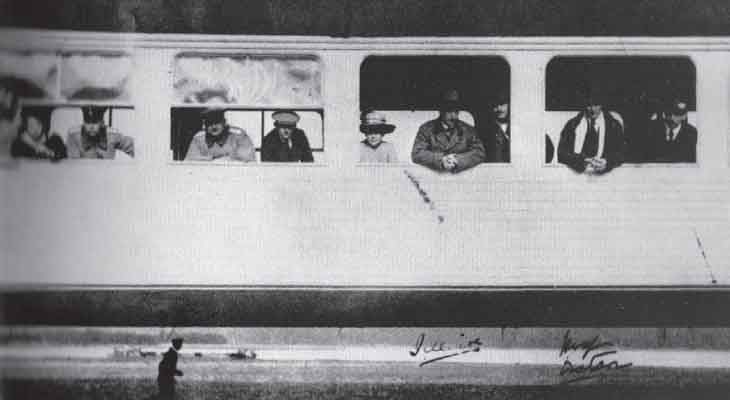
Rear Admiral Jellicoe and Captain Hugh Watson aboard the Zeppelin Schwaben in 1911.
Nor indeed were all senior naval officers totally blind to the potential of airships and aviation. Sir John Jellicoe took it upon himself, in November 1911, to go to Germany and take a flight in the commercial Zeppelin, Schwaben, accompanied by the Naval Attaché in Berlin, Captain Sir Hugh D. Watson, RN. Jellicoe subsequently discussed his findings with the First Sea Lord, but to no immediate effect.130
More Successful Flights by the Army
Once more the army had been using its small airships with some success while the navy struggled. In March 1911, the Secretary of State for War, R.B. Haldane, made a statement to the House of Commons in connection with the recently published army estimates, which included this comment: ‘The balloon factory, really the dirigible factory, has been completely reorganised and has got a very efficient civilian staff of experts under a gentleman well known in aeronautics [Mervyn O’Gorman]. Considerable changes have been made and new machinery introduced, by which three times the output of hydrogen will be obtained.’ He looked forward to the addition of further dirigibles to the army’s present strength of two, Beta and Gamma.131
Of O’Gorman’s time at Farnborough it was later written:
‘The same sort of credit belongs to the conduct of the balloon factory under Mr Mervyn O’Gorman, who had charge of it during that very crucial period from the autumn of 1909 to the summer of 1916. When he took over the factory, he found at Farnborough, one small machine shop, one shed for making balloons, and one airship shed. The workers were about a hundred in number, fifty men and fifty women. Seven years later, when Lieutenant Colonel O’Gorman was appointed to the Air Board as consulting engineer to the Director General of Military Aeronautics, the hundred had swollen to four thousand six hundred, and the buildings situated on the forest land of Farnborough had increased and multiplied out of all recognition. This development was made necessary by the war, but it would have been impossible but for the foresight which directed the operations of the period before the war. The factory, working in close co-operation with the Advisory Committee and the National Physical Laboratory, very early became the chief centre for experimental aviation with full-sized machines.’132
On 1 April 1911, the Air Battalion of the Royal Engineers was formed, to take over from the Balloon School at Farnborough, ‘to which will be entrusted the duty of creating a body of expert airmen. The training and instructing of men in handling kites, balloons and aeroplanes, and other forms of aircraft, will also devolve upon this battalion.’133
An officer, who could be selected from any regular arm or branch of the service, was required, on joining the battalion, to go through a six months’ probationary course (including two months kiting and ballooning) and if, during this period, he showed no aptitude for the work, then he had to return to his unit. On satisfactorily completing the probationary period, he would be appointed to the Air Battalion for a term of four years (inclusive of the time of probation), and would be seconded from his regiment. Certain qualifications were applied. These were fairly demanding: (a) special recommendation by commanding officer; (b) possession of aviator’s certificate; (c) previous experience of aeronautics; (d) rank not above that of captain; (e) medical fitness for air work; (f) good eyesight; (g) good map-reader and field sketcher; (h) unmarried; (i) not less than two years’ service; (j) under thirty years of age; (k) good sailor; (l) knowledge of foreign languages; (m) taste for mechanics and (n) light weight (under 11 stone 7 pounds). The warrant officers, non-commissioned officers, and men, were to be drawn from the Corps of Royal Engineers.134
In command was Major Sir Alexander Bannerman, RE, who owed his appointment to good connections with the general staff. He would not even have described himself as the country’s foremost aviation expert or exponent. It consisted of two companies, No 1 (Airship) at South Farnborough, commanded by Captain E.M. Maitland, Essex Regiment, of whom it was said that he was, ‘as quiet as a Quaker and as considerate as a hospital nurse,’135 and No 2 (Aeroplane) at Larkhill, under the command of Captain J.D.B. Fulton, RFA, which, by the summer, could field five or six flyable aeroplanes. The battalion establishment was for fourteen officers, twenty-three NCOs, 153 men, two buglers, four riding horses and thirty-two draught horses. It can be seen therefore, that by the formation of the two companies, that it was as yet undecided as to whether airships or aeroplanes would develop into the most effective war machines.136 Maitland had under his command the two airships Beta and Gamma, several free balloons and a flight of man-lifting kites. There was quite some debate at this time concerning the status of pilots; it was Maitland’s firm conviction that the pilot should always be in charge of the airship or aeroplane and not have a system, as advocated by some, of non-commissioned pilots under the command of commissioned observers – thus creating a subservient relationship much like that of chauffeur to master. In the Imperial German Air Service the latter method prevailed.
A general aeronautical policy also had to be decided upon and set out. The War Office was faced with something of a dilemma in this respect. Both Germany and France were at a greater stage of advancement in military aviation; France favoured the fixed-wing aircraft as the way ahead, whereas Germany showed a greater inclination to the airship. Which was correct? Neither the politicians, civil servants, nor military men, had sufficient knowledge or experience to be certain as to the best way forward. In comparison to the Air Battalion, France had upwards of 170 aeroplanes and several airships, while Germany had twenty to thirty military aeroplanes and about twenty airships.
In May 1911, Beta suffered a slight but embarrassing accident; Clive Waterlow was in command and had been instructed to investigate a report from other pilots that Beta was difficult to land:
‘Beta Bags a Telegraph Pole. At the conclusion of some practice flights at Farnborough on the 18th inst., the army airship Beta had a trying experience, although fortunately came through with “flying” colours. The airship was not quite low enough for the soldiers to grab the tow rope, and in consequence it dragged across the ground for some distance. In crossing the Farnborough Road the rope got entangled round a telegraph post, which it succeeded in pulling out of the ground. No other damage was done however, the airship landing safely shortly after.’137
Waterlow very sensibly recommended that to rectify this problem, more engine power should be maintained on approach to increase the airflow and thereby give greater effectiveness to the elevator.
Not very long afterwards the Army Council issued provisional regulations for the guidance of the Air Battalion. It was to be regarded as supplementary to the cavalry:
‘The new unit is regarded by the Army Council as one of the most valuable means of obtaining information at the disposal of the commander of an army. It will not, however, replace other means of acquiring information, such as cavalry and agents, but will be used in conjunction with such services. The Air Battalion is to be so distributed that the units may not only be placed in the best positions to obtain information, but to cooperate with the other arms, and especially with the cavalry, in this all-important service.’138
Airship crews were given specific advice:
‘The presence of troops, if in the open, can be observed in clear weather at an altitude of 5000–6000 feet, within a radius of four to six miles from the aeroplane or dirigible. When nearer the earth objects will be rather more easily distinguished, but are a shorter time in view, and the area is restricted. Dirigibles will be exposed to considerable danger from artillery fire when lower than 4,500 feet or within a range of 5000 yards, and from rifle or machine-gun fire when at a height of less than 3500 feet, or at ranges under 2000 yards. For transmission of intelligence from dirigibles, wireless telegraphy, signalling, or carrier pigeons can be used.’139
Very sensible advice was also given to troops on the ground:
‘In deciding whether it is advisable to open fire on airships the probability of escaping observation if fire is reserved is to be considered. Special observation parties of men skilled in distinguishing between friendly and hostile craft might be detailed to watch for the enemy’s machines and give warning to the artillery and machine-gun commanders, who will be prepared to fire much in the same manner as against moving targets on land.’140
Some very interesting information for the airmen was contained at the foot of the same report:
‘On Tuesday, Colonel Seely, in the House of Commons, informed Mr Ashley that the whole question of extra pay to be granted to officers of the Air Battalion was receiving consideration.’141
Gamma had been fitted with her new French envelope. In the summer she was reported as making a number of flights in support of the London Balloon Company and RE Territorials, including some as early as 3 am (to take advantage of the light air often to be found in the pre-dawn hours), adding:
‘At many of the journeys, the London Balloon Company have assisted the Regular Air Battalion in the handling of the airship, some useful airship experience being thus gained for the first time.’142
Then a few days later:
‘Very early in the morning of Wednesday last week the army dirigible, Gamma, was brought out of its shed, and with Lieutenant C.M. Waterlow in charge, and Captain E.M. Maitland, Lieutenant T.J. Ridge, and a mechanic on board, it cruised for some considerable time over Aldershot Camp and district at heights ranging up to 1000 feet. The alterations which have been carried out during the process of overhauling appear to be giving every satisfaction.’143
It was noted in September:
‘Gamma Visits Guildford. The army airship, Gamma, with a crew of six, including Captain Broke-Smith, Captain Maitland, and Mr Mervyn O’Gorman, made a prolonged flight on Tuesday morning last, circling Guildford and returning to Farnborough by way of Farnham, Crondall, and the Long Valley. The flight lasted one and a half hours, and the distance covered was forty miles.’144
‘Gamma Has a Night Out. Lubrication troubles putting both her engines out of action led to the army airship Gamma having an exciting time on the 14th inst. She was caught by a heavy wind just at twilight and driven across the Hog’s Back, but was safely brought down in a clearing not far from Farnham. She was undamaged, and, being moored under the lee of some trees, she remained out in the open all night while the Engineers of the Air Battalion put the engines right. Although a strong wind was blowing on the following morning, Lieutenants Waterlow and Fox took charge of the airship and succeeded in getting it back safely to headquarters at Farnborough.’145
In the same issue another correspondent wrote with some foresight:
‘Shortly afterwards, we observed a huge sausage-like shape above us, and identified it as Gamma from Farnborough. It sailed round the ground at about 700 or 800ft, and then went straight off in the direction of home. One could not help thinking what an easy mark it would make for a gunner, even if two or three times the distance away. It seemed very steady, but rather slow.’146
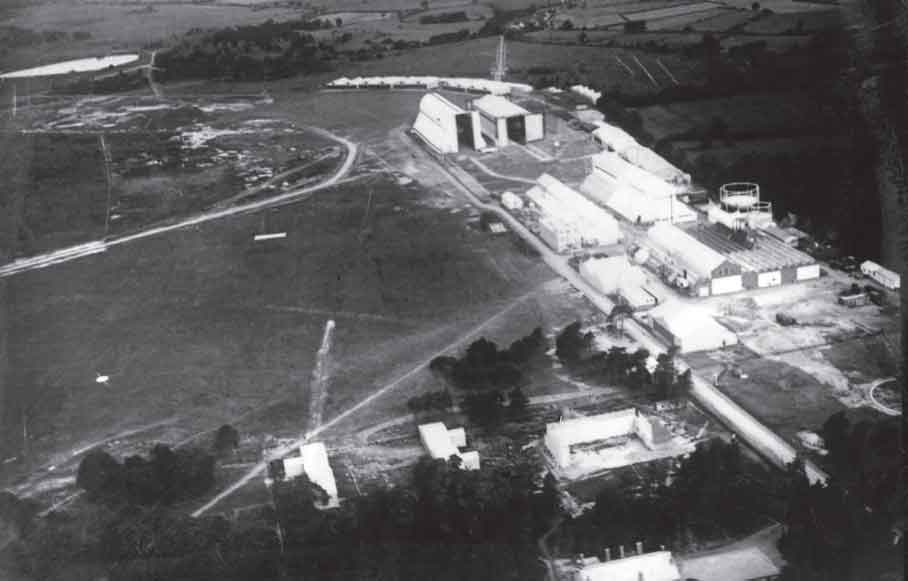
The airship sheds at Farnborough, with the Royal Aircraft Factory in the foreground. (Via Nigel Caley)
And finally:
‘Gamma at Salisbury. On 22 September last, the army airship Gamma made a successful flight from Farnborough to Salisbury Plain, via Basingstoke and Andover. Piloted by Captain Broke-Smith and Captain Maitland, with a crew of six, including Mr Mervyn O’Gorman, a halt was made in front of the hangars on Larkhill, Salisbury Plain, for lunch. Starting again at two o’clock, the return journey was made in one and a half hours, the outward journey having taken fifteen minutes longer. The total distance covered during the flight was 110 miles.’147
Meanwhile, in France, airships and aeroplanes had taken part in the annual army manoeuvres for the second year running, and aviators gained recognition as the ‘fourth arm’ alongside the artillery, cavalry and infantry.148
As the year drew to a close a further successful experiment was made:
‘Ripping the Army Airship. In the envelopes of dirigibles, as of balloons, there is a panel of fabric so cemented to the main body of the material as to enable it to be ripped off by pulling a cord. In ballooning, the ripping panel is used during the last stage of descent in order to destroy the buoyancy, and to prevent the rebound after the car first touches the earth. In the use of dirigibles this practice is of course not followed as a rule, but as it might be necessary, in emergency, to rip before touching earth, it was determined at the Army Airship Factory to see if the proceeding was feasible, and likely to result in much or little damage to the machine. The airship Gamma was employed for the experiment, and the conditions were such as to have enabled the crew to leave the ship by sliding down the trail ropes. The envelope immediately collapsed when ripped, and the airship fell to the ground, but subsequent inspection showed that only stays and wires that could be easily replaced had been damaged by this somewhat drastic trial.’149
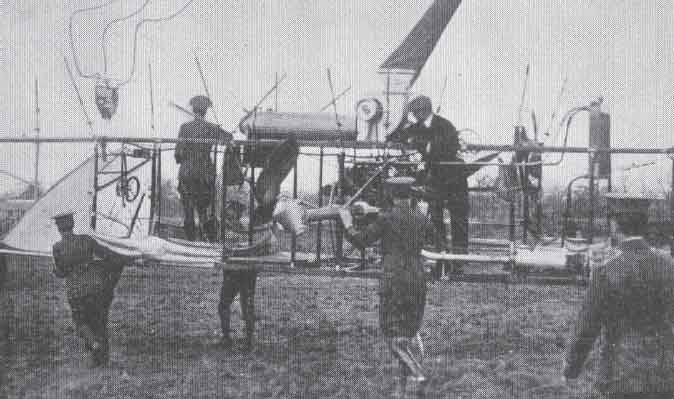
A view of Gamma’s car which shows the engine and swivel propellers.
The Committee of Imperial Defence Deliberates
In the middle of November the Prime Minister, H.H. Asquith, requested that the Committee of Imperial Defence:
‘Should consider the future development of aerial navigation for naval and military purposes, and the measures which might be taken to secure to this country an efficient aerial service.’150
He had been influenced to some extent by general public disquiet with the government’s aeronautical policy when compared to the efforts of France and Germany. The Mayfly’s costly mishap had not improved the position.
During 1911, a feeling of dissatisfaction, ‘had been growing concerning the inferiority in aerial strength of the country as compared with our continental neighbours’. The criticism grew in volume and weight until the cabinet felt that some steps should be taken to see whether or not the existing system could be improved.151
As ordered by the Prime Minister, the membership of the sub-committee was particularly strong. The chairman was the newly ennobled Viscount Haldane, the Secretary of State for War. Other members included Winston Churchill, First Lord of the Admiralty; Lord Esher, a permanent member of the Committee of Imperial Defence; and Colonel Seely, the Under-Secretary of State. Included among the service members were Vice Admiral Prince Louis of Battenberg, the Second Sea Lord; Lieutenant C.R. Samson,152 despite his junior rank, for his technical expertise; Major General C.F. Hadden, Master-General of the Ordnance; and Brigadier General David Henderson of the General Staff. Mervyn O’Gorman represented the Army Aircraft Factory, while Sir R. Chalmers, Permanent Secretary to the Treasury, completed the membership. (Henderson153 (1862–1921), would become the Director General of Military Aeronautics in 1913 when the War Office at last came to recognise the importance of aviation, and of whom Lord Trenchard said, ‘he was the founder and father of the Air Force.’) There was debate and uncertainty within the sub-committee concerning the utility of airships in future military and naval operations, which was mirrored in the changes of mind in the fertile brain of Winston Churchill. In December 1911, he stated to the subcommittee that he would require a good deal of converting before he could acquiesce to a policy of building dirigibles.154 By April 1912, he had become convinced that airships seemed likely to become, ‘an indispensable adjunct of the fleet’.155 Early in the following year he engaged in a lively correspondence and debate with the First Sea Lord, Sir Arthur Wilson, which concluded, somewhat waspishly, as follows:
‘In these notes I have endeavoured to merely supply you with the facts and arguments as they are at presently known to us, and I do not wish to be taken as expressing a decided opinion in favour of airships compared to aeroplanes. In thanking you again for your paper, may I remark that it will give my colleagues and myself much pleasure to receive at any time helpful criticisms and any information or suggestions on these difficult air problems that we are now faced with.’156
In some quarters of the Royal Navy it was believed that the First Lord’s enthusiasm for air power was actually of positive benefit:
‘It was common gossip amongst junior officers, no doubt with very little foundation, that the Sea Lords had gladly given the forceful young First Lord a free hand over air matters in order to divert him from interfering with the Grand Fleet.’157
It was decided that a technical sub-committee, chaired by Seely, should examine the whole question of airships, and would result in the commissioning of a fascinating investigative mission for Sueter and O’Gorman which will be described later.158 The main recommendation of the full sub-committee’s report would be ready within three months and, as will be seen, would have far-reaching consequences for both Army and Royal Navy aviators.
Not everyone agreed with the stately progress with regard to aeronautics as favoured by Haldane; an alternative view was expressed by Viscount St Aldwyn, who, as Sir Michael Hicks-Beach, had served as Lord Salisbury’s Chancellor of the Exchequer at the end of the nineteenth century:
‘My Lords, all my official experience as ex-Chancellor of the Exchequer would induce me to refrain from pressing the War Department in regard to anything that would involve unnecessary expenditure. But I do think that in this matter there has been very slow progress indeed. The noble viscount appeared to me to be waiting for some design of perfection in this matter. Now that has never been the policy of the Navy, and quite rightly too. I remember ships built on designs which were considered reasonably good in order that we might be provided with what at any rate was the best that could be obtained at that time. I would venture to tell the noble viscount opposite that I am afraid under present circumstances, if we should unfortunately be involved in war, we should be quite unprepared with regard to appliances of the kind which have been the subject of discussion. I do hope, therefore, that the War Office will take care that there is some provision in respect of aviation without waiting for some possible design in the future which may not be attained until it is too late.’159
The policy of the government up to this time was well summarised in a report of the Technical Sub-Committee of the Standing Sub-Committee of the Committee of Imperial Defence, dated 30 July 1912, which boasted of assuming the position of the ostrich:
‘Up to the end of the year 1911 the policy of the government with regard to all branches of aerial navigation was based on a desire to keep in touch with the movement rather than to hasten its development. It was felt that we stood to gain nothing by forcing a means of warfare which tended to reduce the value of our insular position and the protection of our sea power.’160
Neville Usborne’s Flying Career Resumes
It would appear that Usborne’s career did not suffer because of his close association with HMA No 1. In February 1912 he was elected as one of the first Associate Fellows of the Aeronautical Society along with Captain Murray Sueter and fellow airship pilot, Lieutenant Clive Waterlow, RE. They were in august company as others elected by the same ballot included Frederick Handley Page, Horace Short and E.T. Willows. The Aeronautical Society had been created in 1866 for the purpose of increasing knowledge of aeronautics, and marked the beginning of the establishment of a systematic record of aeronautical study and achievement in Britain. It obtained a Royal Charter and so added Royal to its title in 1918.
From his naval record of service it would seem that Usborne was posted to HMS Victory for the first three months of 1912. This may have been a holding appointment, or perhaps a short course at the School of Navigation.
On the evening of 4 March 1912, the Aeronautical Society held a meeting at the Royal United Service Institution at which Lieutenant Waterlow of the Air Battalion, Royal Engineers, read a paper entitled Military Airships, in which he surveyed the current position of airships in the British Army. The audience included his superior officers Major Bannerman and Captain Broke-Smith. He deprecated the fact that the Royal Aero Club had so far issued only eight airship pilot certificates, with seven of these having been gained by soldiers. He argued that support from the air of military formations was not a question of either aeroplanes or airships, but that both could be developed. He examined the difficulties faced by airships which he listed as weather, transport and hostile aircraft. He regarded flying in strong winds as being quite safe; saw rain, snow, hail and mist as problems which could be overcome by carrying an adequate supply of ballast, which could be jettisoned if excess precipitation increased the weight of the airship; but recommended the avoidance of thunder and lightning. He discussed the development of a portable mooring mast, to which the airship Beta had been attached in successful trials earlier that month and which could be transported on a single lorry. (This was a tall pole fitted with a revolving cone, into which the nose of the airship was placed, allowing it to be moored into the wind, from whichever direction it blew.) Other stores, cylinders of compressed hydrogen, a portable ladder (to access the car when the airship was moored at its mast), repairing materials, wire, hemp cordage, leak detecting instruments, spares for the engine and tools; he estimated could be accommodated in a further two motor lorries, along with a ground crew of ten to twenty. As regards hostile aircraft, he suggested that the prudent airship captain should either run away or seek security at a greater height. As defensive armament he proposed a light gun capable of firing shrapnel shell (reminiscent of the swivel guns mounted on a wooden warship). He noted that an aeroplane could attack an airship by three methods: by getting above and dropping something on it, by firing from the same level, or by ramming it – which would be a fairly desperate last resort, one would hope. As regards artillery fire from the ground, he felt that at 1000 feet or below, the airship was vulnerable and that climbing to 4000 feet with the prevailing wind would promote reasonable safety. He emphasised that the proper role of the airship when confronted by a hostile aeroplane was defensive, and whilst it should have some means of defending itself, running away was really the best option. The ideal crew should consist of a pilot, steersman, engineer, wireless operator, gunner and observer, while the optimum role was reconnaissance, with bomb dropping as an additional possibility.161
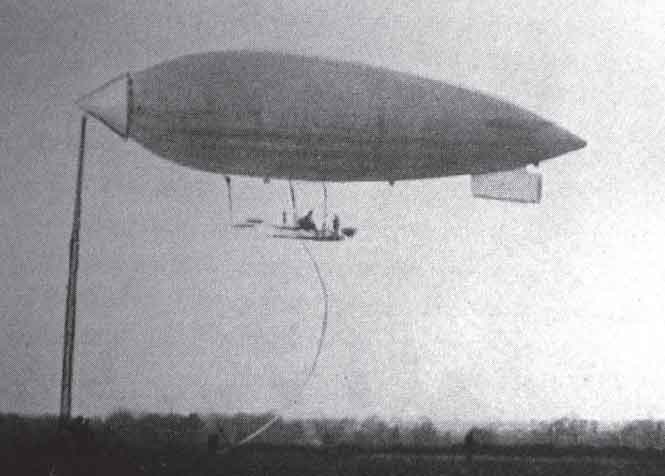
Beta attached to a portable mooring mast.
The Naval Airships Branch was reformed and a group of officers and men was attached to the Military Airship Branch. This for once, seems to have been a sensible decision, inter-service rivalry was set aside, the navy would learn from the army’s airshipmen, becoming:
‘Part of a small band of enthusiasts to whom disaster and disappointment were the salt of endeavour, and it was on the technical knowledge and experience of these pioneers that the country had to rely, when the need came, for the rapid building up under duress, of what was to prove an essential part of the defence against the submarine, one of the most subtle and powerful weapons that the country was called upon to meet.’162
The aim, according to the Aerial Sub-Committee of the CID was to:
‘Train the Naval Wing of the Royal Flying Corps to handle the largest airships and to provide a sufficient number of these, together with the necessary sheds, hydrogen plant and accessories as soon as the personnel to take charge of them are ready. At the present time, however, the Military Wing has far more practical experience in handling airships than the Naval Wing. Therefore the function of the Military Wing in the new development of airships should be to train and assist the Naval Wing.’163
The same report noted that the airship was superior to the aeroplane for prolonged operations across the sea, as it could be steered accurately by compass and its position fixed by astronomical observation, for both of which it gave a much better platform. It also stated that the airship had a greater radius of action, was superior for the purpose of communication by wireless telegraphy, could carry a greater weight of explosives and could aim them with greater accuracy by hovering over the target, which quality would also allow for better photography and observation. Nor were airships believed to be especially vulnerable to artillery fire, as recent experiments made by the Ordnance Board had shown that no existing British gun could be relied upon to hit an airship. Moreover, great difficulty had been experienced in constructing a fuse which would cause a shell to burst on impact with an airship’s gasbag, or in manufacturing an incendiary shell. The fairly small speed differential between airships and aeroplanes, and the greater ability of the airship to ascend rapidly, did not inspire great confidence in an aeroplane’s capability to ensure an airship’s destruction. It was considered that the answer might lie in the creation of a force of armed interceptor airships. Consideration was also give to the future provision of airships, it being decided that the best way ahead was to build gradually on the very limited number of small airships currently in military service by acquiring larger vessels over a period of time, as the personnel involved gained in experience. To this end the purchase of the Willows craft, an Astra-Torres type from France, a Parseval from Germany and the construction of an improved Gamma type was recommended, all of which were non-rigids; while the development of a rigid type should be kept, ‘under close observation’.164
On 1 April 1912, Usborne was sent to Arnold House, Farnborough, as Squadron Commander, Naval Airship Section, Royal Flying Corps Airship Wing, with Commander Masterman also posted as the CO of the Naval Section, together with the future airship pilots, Lieutenants RN, F.L.M. Boothby and H.L. Woodcock, for the Airship Course, and a party of ratings.165 (Sadly, only ten days before, his birthplace of Queenstown was the scene of the RMS Titanic’s last landfall before proceeding across the North Atlantic on her doomed maiden voyage.) This was only a month after the first military use of airships, the Italian Army’s small non-rigids P1 and P3 making reconnaissance flights over the Turkish lines near Tripoli taking still and motion pictures, dropping grenades and spotting for the artillery. The Times was; ‘Profoundly impressed by the skill and coolness of their pilots, and firmly convinced of the practical value of aviation in war’ and added; ‘We are probably at the beginning of a long struggle between the advocates of the aeroplane and those of the airship. Both types of aircraft must be provided by a nation which has to consider the prospect of war.’ Useful additional information included the fact that the Italians had three classes of airship – P for piccolo, M for medio and G for grande.166
Usborne was joining a group of experienced and capable army airshipmen. He would have to work hard and learn quickly in order to make his mark in their company. The knowledge that he would gain in flying the RFC’s dirigibles would be of enormous benefit to him when it came to designing one of the most successful classes of dirigible ever built just a few short years in the future. Not long after he arrived at Farnborough he was given a task by the Admiralty, being directed to call on Messrs Barr and Stroud, the Glasgow-based firm of optical instrument manufacturers, to give them information concerning balloons and airships to assist in designing a rangefinder for use in anti-balloon firing.167
As has been described, Beta had been giving useful service since 1910 and had been the subject of a series of modifications, including being fitted with wireless. The portable mast experiment mentioned by Clive Waterlow had included leaving Beta out in a 33mph snowstorm (53kph) in which she had suffered no harm. It was reported by Flight Magazine on 1 June that Usborne had been taken up as a passenger in both the airships Beta and Gamma. In the same issue it noted that Gamma had undergone a programme of alterations which had improved its flying characteristics when taken out by Lieutenant Waterlow as pilot-in-charge, Captain Maitland steering, an NCO mechanic in charge of the engines and Captain Lefroy (the commander of the Wireless Experimental Section RE) handling the wireless apparatus. A flight of about twenty minutes was made, of which two minutes was occupied by the return journey with the wind. During the flight the steadiness and stability of the ship was most remarkable, an excellent straight course was maintained and a uniform elevation which appeared to be something under 500 feet.168
It was further noted that it was now becoming quite common to see the airships flying about in weather conditions when the aeroplane sheds remained firmly closed. Gamma had in fact been virtually rebuilt, with a new envelope of 101,000 cubic feet (2858 cubic metres), manufactured by Willows, a box elevator at the stern of the car replacing the previous fore and aft pair and two new 45 hp (33 kW) Iris engines, giving her a top speed of about 30mph (48kph). In April she had visited London:
‘On the early morning of Monday, the reconstructed army airship Gamma paid another visit to the metropolis and circled round St. Paul’s. Captain Maitland was in charge, assisted by Lieutenant Waterlow, while in the engine room were Mr Irving and Corporal Scovell, with Captain Allen and Lieutenant Carfrey as passengers. Farnborough was left at 6.15 and, pushing her way through a headwind, the airship reached St. Paul’s about 8.30. Turning above the cathedral, she then started back on her return journey and, with the wind behind, was soon out of sight, Farnborough being reached again in fifty-seven minutes. On the 19th inst., with seven passengers on board, she was up to a height of a mile. Beta was also out with a full crew, while the three army aeroplanes made several tests. On Saturday morning Gamma, with Captain Broke Smith in command, was up to a height of 1,000 feet and flew to Haywards Heath and back’.169
An event of considerable note took place in May following the recommendations of the sub-committee of the Committee of Imperial Defence, now under the chairmanship of Colonel J.E.B. Seely. (Later Baron Mottistone, (1868–1947) he would succeed Haldane as the Secretary of State for War in June 1912 when Haldane became Lord Chancellor. During the First World War he commanded the Canadian Cavalry Brigade.) The Air Battalion RE was replaced on 13 May 1912 by the formation of the Royal Flying Corps (RFC), ‘an aeronautical service for naval and military purposes’170 which consisted initially of a Military Wing of one airship and man-carrying kite squadron, and two aeroplane squadrons, a Naval Wing, the Royal Aircraft Factory at Farnborough (which was directly descended from the old Balloon Factory, having been renamed the Army Aircraft Factory in April 1911) and the Central Flying School (CFS) at Upavon in Wiltshire. One of the first officers to take the CFS aeroplane course, Lieutenant Charles Longcroft, later wrote that he was surprised to find that the instruction began with a series of ascents in spherical balloons to learn the arts of aerial sketching and report writing, followed by a flight in Gamma and a number of free ballooning trips which continued for about six weeks, ‘by which time we were all heartily sick of it’. It is possible that a lack of aeroplanes accounted for this seemingly retrograde step.171
It was also recommended that in view of the considerable cost involved it was not considered advisable to build rigid airships. Non-rigid airships were regarded as having military value as they could carry efficient wireless telegraphy apparatus, which the aeroplanes of that period could not. Kites were thought to be of use as they were the only means of aerial observation in really high winds. All were required by the War Office to work in close co-operation.
The King visited Farnborough on 23 May, and, as well as watching some evolutions performed by Beta, he visited the factory to see how work on the new airship, Delta, was progressing. It may well have been that some of Usborne’s first flights with the army were in the dark, as it was reported in June:
‘Army Airship in the Dark. Experiments were carried out last week at Farnborough with the army airships Beta and Gamma in the “wee small” hours. About 11 pm on the 29th, Beta went up and cruised until after midnight, and similar operations were carried out on the following day. On the 31st Gamma ascended, in charge of Captain Maitland, at 10.30 pm and carried out a cruise of an hour and a quarter, while Beta made a similar trip.’172
Following an inspection and air test on 10 June by Lieutenant Waterlow, on 18 July, the Willows No 4 airship and its shed were purchased by the Admiralty for £1050, being named as HMA No 2, despite Waterlow’s positive but less than ringing endorsement:173
‘The feature of the ship (Willows No 4) is its small size and remarkable handiness; everything can be packed up and taken to pieces with the utmost care. For pleasure purposes this ship seems to be ideal. It would also be useful to train NCOs and men on handling on the ground and in the air. While both ships (Willows No 3 and No 4) would afford valuable training to officers and men unacquainted with this class of work, they cannot seriously be considered for war purposes except, conceivably, against a savage enemy.’174
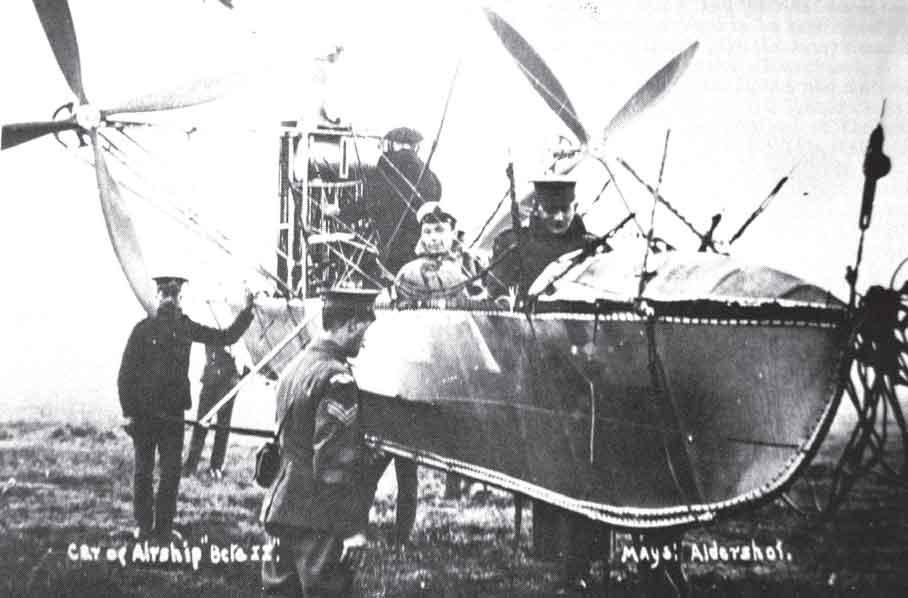
Neville Usborne (in the white covered cap) in the reconstructed Beta II in 1912. (Mays Aldershot via PS Leaman)
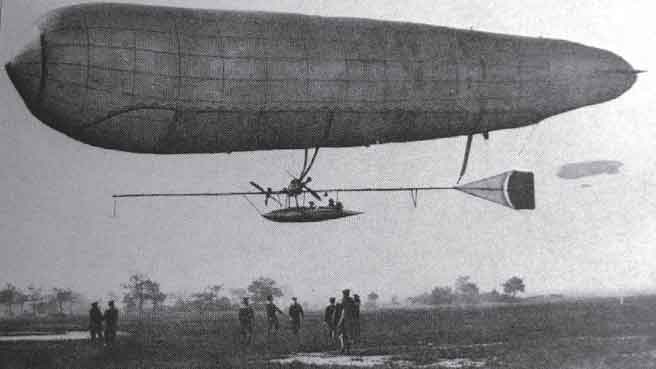
The Willows No 4 was purchased by the Admiralty and renamed HMA No 2.
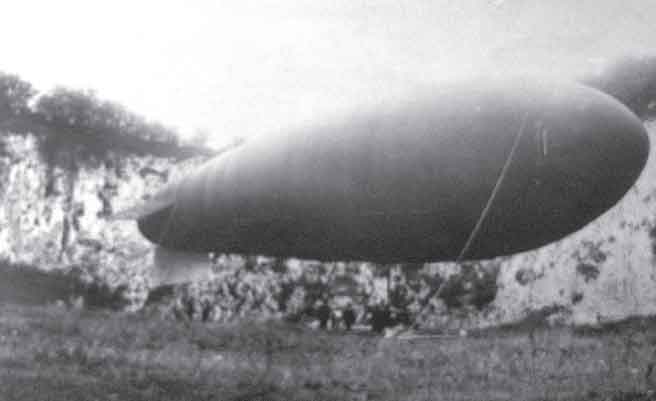
HMA No 2 in a natural shelter near Odiham.
Willows No 4 was a handy little ship with two or three seats, dual control and a 40 hp (30 kW) Renault engine driving a pair of wooden, four-bladed propellers. It had a capacity for sufficient fuel and oil to give an endurance of seven hours flying time. The envelope was made from oiled cotton, which was an experimental material. It had a volume of 20,000 cubic feet (572 cubic metres), was 110 feet (33.5 metres) in length and a diameter of 18 feet 6 inches (5.5 metres), which tapered towards the stern, giving a streamlined appearance. The torpedo-shaped car was constructed of steel tube clad with sheet aluminium. Usborne was appointed to command HMA No 2, ‘and with a few naval ratings was soon intriguing the soldiers with experiments on Cove Pond. The army found him irrepressible.’175 Willows himself had for several years been of the mind that a small dirigible could be useful for naval scouting purposes, housed in the hold of a parent vessel, and being launched and recovered from the deck.
On the afternoon of 12 August 1912, at just after 2 pm, Gamma began a flight back to Farnborough from Larkhill with Usborne as pilot, Lieutenant Fletcher as course keeper, Sergeant McGrane as steersman and Sergeant Collins as mechanic. She also carried 200lbs (91kg) of ballast, and sufficient fuel and oil for six hours, 100lbs (45kg) of petrol being in tins and therefore available, in emergency, as ballast. Rising to 600 feet (182 metres) there was too much wind to make any progress, so they descended to 100 feet (30 metres) and were able to attain 8mph (5kph), against a wind of 22mph (35kph). They climbed to 900 feet to pass over the ridge of Ashdown Copse. The port engine had to be stopped due to a problem causing pre-ignition, with the result that Gamma could only just make headway and descended with great rapidity to only 50 feet (15 metres). Four bags of ballast were thrown out and an emergency landing was made behind the shelter of some trees. Having moored to the tallest tree, Sergeant Collins carried out repairs to the engine and within forty-five minutes they were ready to take to the air again, though Sergeant McGrane had to be left with the ground party to go home by motor tender in order to reduce the weight carried. The wind strengthened again and the depleted crew had a terrific struggle to negotiate a way around the village of Weyhill. Due to fierce upward air currents Gamma’s progress was somewhat erratic, varying in altitude from 150 to 750 feet (45 to 228 metres), and following a zigzagging route across the countryside. It was decided to land again and, with the ground party not having caught up, the grapnel was thrown out, catching in a hedge at the second attempt. However, mooring proved to be too difficult, with the grapnel dragging through the foliage and the airship once more ascended to 800 feet (243 metres). Further attempts were made to land near Longparish in a large field surrounded by trees, but were to little avail. Fortunately, a crowd of villagers had gathered to watch the spectacle, some of whom caught hold of the trail rope which had been thrown towards them, allowing Gamma to be brought to rest over a wooded hollow on the leeward side of the field, venting gas to descend. The grapnel rope had become tangled and had to be cut away by using borrowed ladders to climb up into the trees to effect this operation. By this time it was 6 pm, the wind had died away, but then it started to rain very heavily. The crew turned the airship broadside on in the hollow, pushed her nose hard into the trees, and picketed her down with sacks of earth and crowbars. It was not until 3.45 the next afternoon, after the rain eventually had ceased, that Gamma took off again for a final leg to Farnborough, taking only thirty-eight minutes at a speed of 50mph (80kph).
Illustration from Fletcher’s report. (Via Nigel Caley)
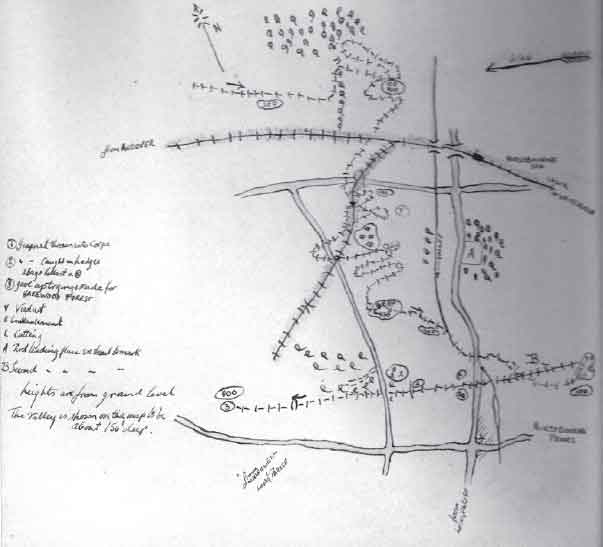
Another illustration from Fletcher’s report. (Via Nigel Caley)
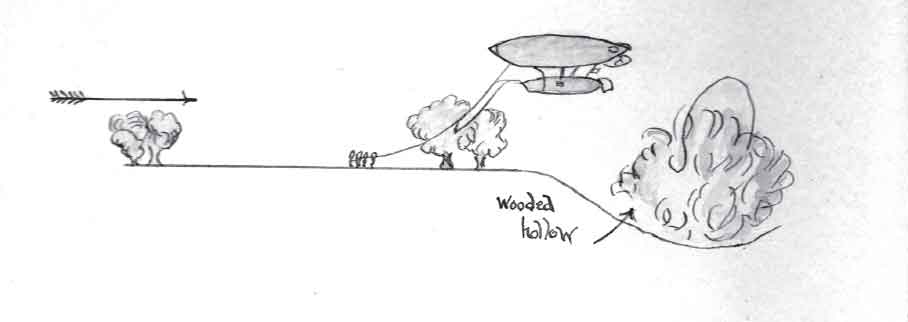
Third illustration from Fletcher’s report. (Via Nigel Caley)
In September 1912 the Admiralty set up an Air Department to administer the Naval Wing. Captain Murray Sueter was tasked with overseeing all aspects of naval aviation. He had visited France, Germany and Austria three months earlier, while still on half pay, in the company of Mervyn O’Gorman, to inspect and report upon airship progress there. While in Austria they flew in a Parseval non-rigid airship from Aspern to Fischamend and inspected a kite-balloon and operating equipment (then regarded as on the secret list). The kite balloon, or drachen, was invented by Major von Parseval of airship fame in 1894. A spherical tethered balloon has the tendency to rotate about its vertical axis, thus making observation difficult and also possibly affecting the observers in the basket with nausea. The drachen overcame this effect by elongating and streamlining the hydrogen-filled balloon envelope, and adding a vertical lobe to the rear, containing air collected by a forward facing scoop. The nose was thereby kept head-on to the wind and the balloon was much more stable; in the same fashion as a weathercock. Despite repeated refusals from the German authorities, they made a voyage of some six hours duration in the Zeppelin airship Viktoria Luise, by the subterfuge of posing as Americans. On board were some twenty passengers, a civilian crew and a naval crew under training. The conditions were reasonably convivial, as apparently the German passengers spent most of the flight eating an enormous quantity of sausages and drinking champagne.176 During the flight over Hamburg, Lubeck and Kiel, they made conversation with a German naval officer, who told them that he was to be the captain of the first German naval airship, then under construction. Sueter also noted the excellent visibility gained from the airship of the shoal water when cruising over the Bay of Lubeck at a height of 3000 feet (910 metres) and overland, of deer running through corn from a height of 2000 feet (609 metres). In the course of their stay they uncovered the existence of thirty-three large airship sheds and half a dozen airship factories, and were particularly impressed by achievements in Germany, stating in their report, which was fully illustrated with photographs and sketches:
‘We were struck with the popular reception given to the airship. On passing over villages, isolated farms, etc, everybody turned out and cheered and waved to us. In many hundreds of miles on our small English ships, including trips to London, Farnham, Guildford, Salisbury, and down south to near Portsmouth, no such interest is evoked.’177
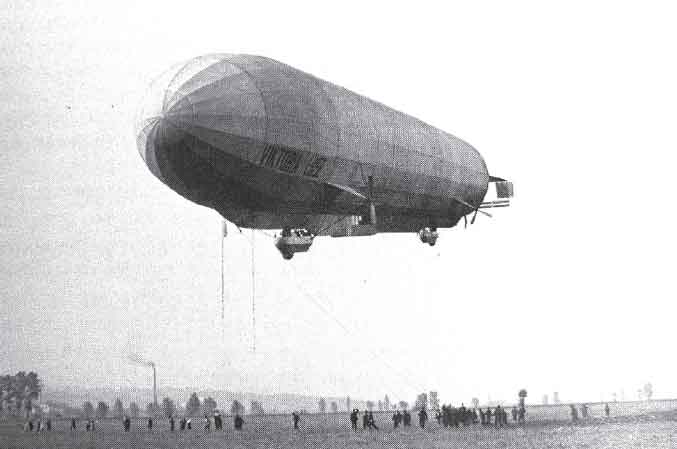
LZ11 Viktoria Luise of DELAG.
The successful results of German endeavours were contrasted unfavourably with the attitude of the British authorities over the previous five years:
‘German airships have, by repeated voyages, proved their ability to reconnoitre the whole of the German coastline on the North Sea. In any future war with Germany, except in foggy or stormy weather, it is possible that no British war vessel or torpedo craft will be able to approach within many miles of the German coast without their presence being discovered and reported. In short, every one of the tactical and strategic advantages which the Committee of Imperial Defence anticipated in 1909 when recommending the construction of a rigid airship for the Royal Navy, has been, or is in a fair way of being, realized by the German airships. These results have only been attained by perseverance under the most discouraging conditions of disaster and loss.’178
They also noted that they had been informed that for experimental purposes, loads of up to 1000lbs (453 kilograms) had been dropped from airships:
‘While on the subject it may be remarked that for any nation to have a ton of explosives dropped above their admiralty, War Office or administrative buildings would, to say the least of it, be inconvenient, unless proper alternative underground offices have been foreseen.’179
The two authors may have resorted to irony and perhaps a certain amount of judicious exaggeration, but they made their case well and it was one of the contributory factors to the revival of the Naval Airships Section. It certainly encouraged Seely’s technical sub-committee to action, as in its report of July 1912 it stated that the government’s policy should move away from merely monitoring and keeping in touch with developments in aerial navigation, to hastening its progress. It was felt that the previous policy, which did not want to encourage a type of warfare which could directly threaten Britain’s insular security, had been overtaken by events and was dangerously out of date. Sticking one’s head in the sand and hoping that it would all turn out for the best would not suffice. The comparative merits of heavier-than-air and lighter-than-air craft had not yet been sufficiently proven to abandon one totally in favour of the other. Whilst it may have been thought that the fixed-wing aircraft had greater future potential, there was no effective anti-aircraft gun in existence which could guarantee the destruction of an enemy airship, nor were aeroplanes capable of so doing.
The army manoeuvres of September 1912 saw the debut of the new airship Delta, which was the largest British non-rigid so far, with a capacity of 175,000 cubic feet (4952 cubic metres). She had a pair of 110 hp White and Poppe engines, driving swivelling propellers, which allowed a top speed of 42mph (67kph). Her gestation period (since 1910) had been long because it had been the intention to construct Delta as a semi-rigid with an envelope made from waterproofed silk – both these ideas proved impractical and were abandoned. The manoeuvres were held in Cambridgeshire, with the opposing Red and Blue Armies commanded by Lieutenant General Sir Douglas Haig, KCVO, CB, KCIE and the ‘portly but gifted’180 Lieutenant General J.M. Grierson, CVO, CB, CMG respectively. The General Staff issued a preliminary memorandum which stated:
‘There can no longer be any doubt as to the value of airships and aeroplanes in locating an enemy on land, and obtaining information which could only otherwise be obtained by force. In this year’s army manoeuvres each force will be provided with a detachment of the Royal Flying Corps, consisting of one aeroplane squadron and one airship detachment. The detachment with each force will be under the immediate orders of the commander, who will employ it in co-operation with the other arms and more particularly with the cavalry, for obtaining information as to the movements of the hostile force. The work of cavalry will undoubtedly be aided greatly by a well-trained aeronautical service, but, except to a certain extent in longdistance reconnaissance, aircraft can in no way replace or revolutionize its action.’181

Beta II & Delta on manoeuvres.

A cache of hydrogen cylinders being stacked for the airships taking part in the Army manoeuvres of 1912. (Via Nigel Caley)
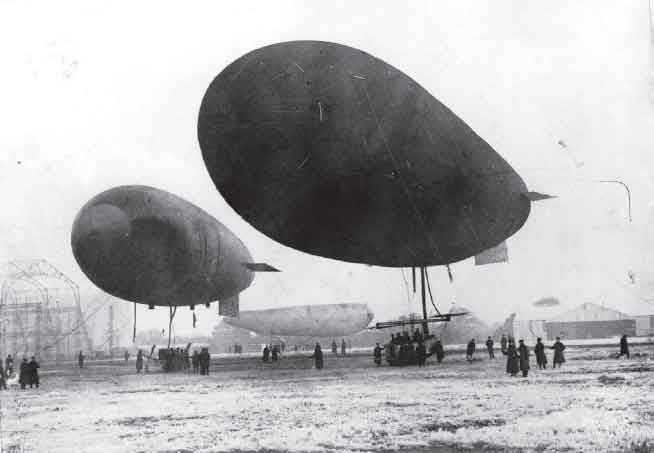
After the army manoeuvres in 1912, Beta, HMA No2 and Delta. (via Nigel Caley)
The Red Army was the theoretical invasion force marching on London, with the Blue Army intent upon halting its progress.
On Friday, 13 September, Gamma (Captain Maitland) and Delta (Captain Waterlow) departed from Farnborough en route for Kneesworth and Thetford. Unfortunately the newer airship, Delta, suffered engine trouble over Hampstead, but was able to use her wireless to send word of her non-arrival – this first aerial distress message was also received as far away as the Royal Navy’s shore establishment in Portsmouth, HMS Vernon, giving further proof of its effectiveness. Accordingly, Beta, flown by Lieutenant Fletcher, was dispatched to take her place. The only difficulty was that Beta was not equipped with a wireless set, so depriving the Red Army of this facility – the fixed-wing aircraft did not have wireless sets. On Monday, the first day of action, the utility of Gamma and her wireless, which was driven by a generator powered by air from the engine’s slipstream, rapidly became evident, with full details of the enemy’s dispositions being supplied very early in the proceedings from a height of 4000 feet (1200 metres) to the ground station several miles away. It was shown during these early experiments that wireless messages could be received up to 35 miles (56 kilometres) away. The Blue Army was adjudged to have won the exercise, somewhat against the odds, as it was something of a scratch force in comparison to the Red Army, with Gamma’s assistance being regarded as being more than helpful to the successful outcome. One night flight was made with the object of gaining experience in reconnaissance and bomb-dropping. The exercise was judged a success and the inherent flexibility of airships was shown when Gamma, being unable to recover to her field base, rather than risk landing at an unknown spot in the dark, simply remained in the air until after dawn. Grierson out manoeuvred Haig and also concealed his troops from aerial observation much more efficiently. Both airships departed back to base at the conclusion of the manoeuvres a few days later. The chief umpire for the manoeuvres was no less a person than the Chief of the Imperial General Staff, General Sir J.D.P. French, GCB, GCVO, KCMG, ADC. It is to be hoped that Douglas Haig was moved to amend his views as previously expressed: ‘Tell Sykes [Major Frederick Sykes, the CO of the Military Wing RFC] he is wasting his time; flying can never be of any use to the Army.’182
Haig was not instinctively opposed to change; it was more a question of being convinced of its practicality and utility. He regarded the reforming Secretary of State for War, R.B. Haldane with some favour, writing in his diary that he was: ‘A big fat man, but with a kind, genial face. One seemed to like the man at once – a most clear-headed and practical man – very ready to listen and weigh carefully all that is said to him.’183
In fairness, it must be noted that Haig did indeed in time take heed of the lessons of one of the most embarrassing episodes of his professional career and in due course came to appreciate the efforts of the RFC in France.
It was not only British generals who doubted the value of military aviation; the future Allied Commander-in-Chief of 1918, Généralissimo Ferdinand Foch, apparently stated in 1913, ‘aviation is fine as sport. I even wish officers would practise the sport, as it accustoms them to risk. But, as an instrument of war, it is worthless (c’est zéro).’184 He changed his mind just two years later:
Groupe des Armées du Nord
PC le 21 Juin, 1915
Etat-Major
Le Général Foch
Commandant le Groupe des Armées du Nord
À Son Excellence le Premier Lord de l’Amirauté,
Whitehall,
London, SW
Depuis les débuts de la campagne, une escadrille d’aviation maritime Anglaise est stationnée a St Pol-sur-Mer. Commandée successivement par le Commandant Samson, puis par le Commandant Longmore, elle a toujours prêté son concours aux aviateurs francais pour l’accomplissement de la tâche commune, sollicitant même les missions les plus périlleuses.
Le General Foch est très heureux d’adresser à tout le personnel de L’escadrille ses remerciements pour cette collaboration; il le félicite chaudement des exploits qu’il a mis à son actif, dûs autant à son initiative qu’à son audace.
Le Général Foch serait très reconnaissant à Son Excellence le Premier Lord de l’Amirauté de bien vouloir transmettre ses felicitations aux intéressés.
(Signed) F. Foch185
There is also the possibly apocryphal story that one of the generals complained that the aircraft had completely spoiled the war, which was rather missing the point. Certainly General Grierson was in no doubt as to Gamma’s contribution to the successful outcome:
‘The impression left on my mind is that their use has revolutionized the art of war. So long as hostile aircraft are hovering over one’s troops, all movements are liable to be seen and reported, and therefore the first step in war will be to get rid of the hostile aircraft. He who does this first, or who keeps the last aeroplane afloat will win, other things being approximately equal. The airship, as long as she remained afloat, was of more use to me for strategical reconnaissance than the aeroplanes, as, being fitted with wireless telegraphy, I received her messages in a continuous stream and immediately after the observations had been made. It is a pity that the airship cannot receive messages by wireless, but doubtless modern science will soon remedy this defect.’186
Gamma had a few adventures on the way back to Farnborough with five officers on board, passing over Cambridge, to which it subjected a fusillade of celebratory Very lights, refuelling in Wiltshire, making a night stop at Chirton Manor and then colliding with a hayrick at Devizes, causing the envelope to heel over. In order to prevent any further damage, Major Maitland, who was in command, decided to deflate the envelope. The airship was then packed up and returned on a lorry to Farnborough for minor repairs.
In a report from the War Office by the Director of Military Operations the following points were made:
‘65. The airships Beta and Gamma, both renovated and considerably improved, were also employed, one on each side, continually cruising over the battle area on Monday and Tuesday, a proportion of the naval crews under training being used. It should be noted that the airships employed have been constructed with a view to the training of personnel, and not for war.
‘69. The following points brought out during the manoeuvres are of interest:-
Night work – No night work was carried out by aeroplanes. The airship Gamma made one night flight with the object of gaining experience in reconnaissance and bomb dropping. After carrying out the exercise successfully she failed to land at her field base on her return, and rather than risk a landing at an unknown spot, she remained in the air until after dawn. Method of Communication – the great advantage of fitting a wireless telegraphy apparatus in aircraft was shown by the work accomplished by the airship Gamma.’187
Another great lesson was the necessity for concealment; ‘No body of troops could be moved under observation from the air without being detected and reported.’188 The airships were active again in October:
‘Several trials have been made with both Beta and Delta at Farnborough during the past few days. On Wednesday week the latter was out and made one or two lengthy voyages with five passengers on board. She was also out on the following day, and on Sunday and Monday. Beta was tested on Saturday, and on Monday she took a crew of naval men from Sheerness for an instructional voyage.’189
And also Usborne’s own command:
‘The baby dirigible built by Messrs E.T. Willows, of Cardiff, for the British Navy, has made a very favourable impression at Farnborough. The little torpedo-shaped car, for the pilot and his assistant, which is slung beneath the main beam running fore and aft, gives the aircraft a very smart and businesslike appearance, and the 35 hp Anzani engine, driving two four-bladed Rapid propellers, has shown itself capable of giving the airship a speed of over 50 miles an hour.’190
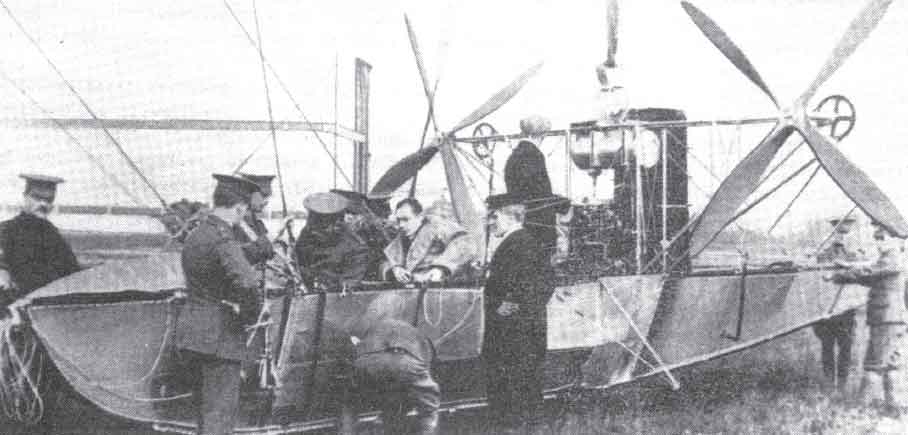
Beta II in September 1912, with Lieutenant J.N. Fletcher, RFC, and Lieutenant Neville Usborne, RN, in the car.
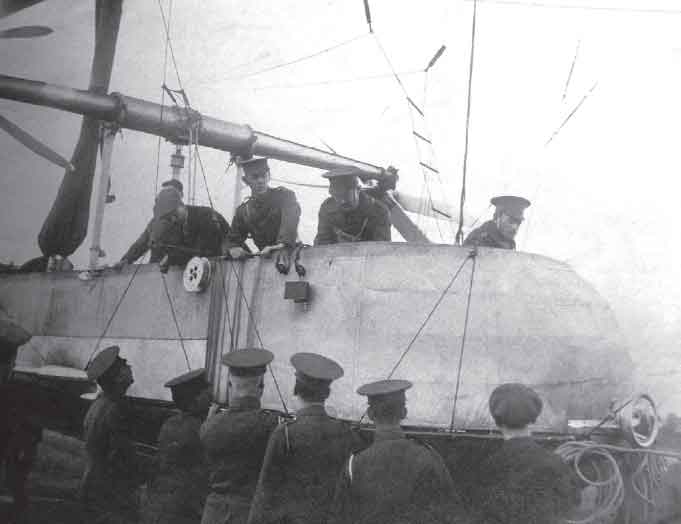
Delta on the ground.
Certainly the airship as designed offered less air resistance, but to reach such a speed it is likely that there was a fairly strong following wind. In November there were a couple of minor mishaps. Firstly, with Willows himself at the helm and, in all probability, Usborne as his passenger, the motor stopped dead as the airship was circling to land at Farnborough. They drifted a little while and, managing to cast the trail rope and grapnel, descended near the Basingstoke Canal, but somewhat too close to a sewage farm for absolute comfort. The watertight nacelle proved its use. It was discovered that they had run out of petrol. A fresh supply was brought by car and a successful ascent was made; no doubt both the crew were glad to be aloft and away from noxious odours. As darkness had fallen, the landing at base was made with the aid of a searchlight. All in all it was thought that this was a pretty good effort for a new ship.191 Then two weeks later; ‘The Willows airship was out on Friday. Unfortunately she came down at Cove, buckling the main boom of the nacelle, but she was safely towed back by bluejackets without further damage.’192
In December, the First Lord of the Admiralty, Winston Churchill, answered questions in the House of Commons on the subject of naval aeronautics. He announced that he was pleased with the progress of the Willows airship and quoted a much more realistic figure for its top speed of 30mph (48kph). He also mentioned the scales of pay applicable at that time:
‘The extra rates of pay for naval and marine officers of the Royal Flying Corps are as follows: Ordinary pay of squadron commander, 25 shillings a day; flight commander, 17 shillings; flying officer, 12 shillings. The flying pay is 8 shillings a day. The commanding officer of the Naval Wing receives £800 a year. Flying pay is paid continuously to aeroplane flyers, but only on days of ascent in the case of airships.’193
A contemporary observer thought that leaving the pay and conditions of airmen who had come to the RFC from the Royal Navy to their Lordships of the Admiralty was not a good idea, and later wrote:
‘This was a snag which was to upset the boat. It seems almost incredible that anyone, even a politician, could have been so obtuse as to fail to realise that a scheme which involved the joint command and administration of a force by the War Office and the Admiralty was doomed to failure. No intelligent person could anticipate for one moment that the arrogant bureaucrats at the Admiralty would be content to take the inferior position demanded of them by this project and to submit to accepting orders from their fellow civil servants at the War Office.’194
Churchill also made reference to the non-rigid Astra-Torres and Parseval airships which had been ordered by the Admiralty in 1912. In 1910–11, the Spaniard, Torres Quevedo, had designed a small non-rigid airship with an innovative, trefoil-shape gasbag (three lobes interconnected internally with porous fabric curtains). It increased the stiffness of the envelope so it retained its shape better and also reduced the external rigging, which decreased air resistance. In 1911 he flew in it to France and subsequently made a deal with the Astra Airship Company to develop the Astra-Torres type airship. As previously mentioned, Major August von Parseval was a German military officer who, as well as inventing kite balloons (which would be used extensively by both sides for observation purposes in the First World War), also developed a flexible non-rigid airship type that was sold to several countries. The pace of events had forced the Committee of Imperial Defence, and the Admiralty, to move away from the Haldane policy and buy off the shelf, hoping that the results would be better than the embarrassing Lebaudy and Clément-Bayard episodes. Churchill commented that the country’s leaders could no longer afford to wait until the relative value of airships and aeroplanes was settled, airships required serious study as soon as possible, and if there were no British types to study, then vessels had to be purchased from abroad with a view to establishing a fleet of dirigibles as soon as possible. Matters requiring urgent attention included the best means of anti-airship countermeasures – aeroplanes, gun defences, or armed airships?195 Churchill’s views were supported by the Second Sea Lord, Vice Admiral Sir John Jellicoe, KCB, KCVO, who favoured airships over aeroplanes because their greater range would make them of more use for scouting purposes.196
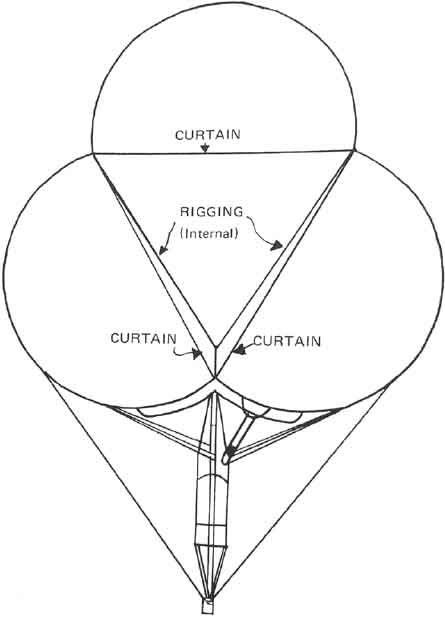
Cross section Astra Torres type.
Meanwhile, Usborne was also flying some of the other airships, including, in December:
‘Some little excitement was reported in Portsmouth on Tuesday last by the appearance overhead of an airship, until it was noticed that the vessel was flying the White Ensign and it was recognised as one of the British craft – in fact it was Beta with Lieutenant Usborne in charge. The dirigible carried a crew of four naval officers and sailed from Aldershot to Portsmouth at a height of 500 feet. Over the harbour the dirigible elevated to 2000 feet, then returned to her station at Aldershot.’197
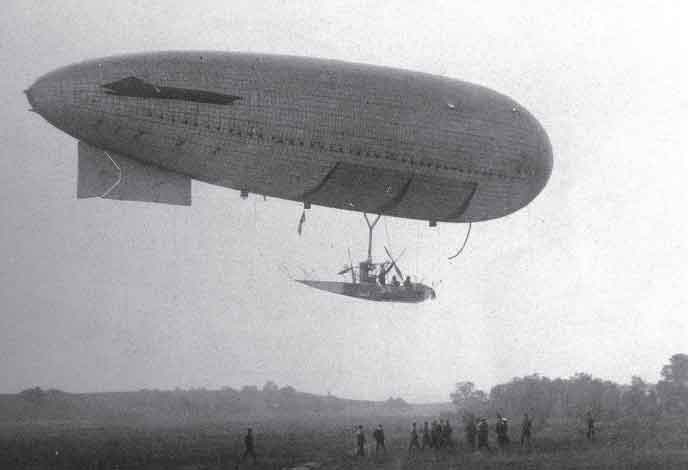
Beta II at Aldershot in 1912.
‘Manned by a naval crew with Commander E.A. Masterman in command and Lieutenant N.F. Usborne as pilot, the army airship Gamma cruised on Wednesday morning from Farnborough to London. The airship turned above the Chelsea football ground and arrived back at Farnborough just in time to avoid a heavy storm of sleet and snow.’198
Another incident which was reported must have been very frightening for the mechanic concerned:
‘One of the mechanics holding down Gamma after her trip to Portsmouth and back on Monday, failed to hear the officer’s order to release when another ascent was made and was carried up to a height of 100 feet. Fortunately, he held on to the rope while the airship descended as quickly as possible, so that he escaped with nothing worse than a shaking.’199
There was also some praise for the small airships generally:
‘Last week in misty weather Gamma was out on Wednesday manoeuvring round the district. She was handled in a skilful manner and gives one the impression of being more useful than the exponents of heavier-than-air-machines care to admit. Some of the disadvantages peculiar to this type of aircraft appear to be, on second thoughts, overweighed by their better qualities, and the construction and equipment of small, handy dirigibles would by no means be a step in the wrong direction.’200
Public and Parliamentary Concern
During the winter months of 1912–13 there was once more a certain degree of agitation in the Press and Parliament concerning aerial defence. The first incident was at Sheerness in October 1912, when it was claimed that, under cover of darkness, an airship had probed the defences of this strategically important location. Much of the concern was due to the alleged sightings of the navigation lights of mystery airships around the south coast of England. It was in fact a mixture of fact and fiction, as well as the release of fire-balloons by practical jokers. It apparently became known to the Admiralty that the German civil Zeppelin Hansa, flown by a naval crew, did make a number of incursions, though this was vigorously denied by German newspapers.201 The First Lord of the Admiralty informed his fellow members of the Committee of Imperial Defence that there was very little doubt that the airship reported to have passed over Sheerness was a German vessel.202 Whatever the truth of the matter the main point at issue was that if an airship or airships had flown over, either on a spying mission or one with more hostile intent, there were no effective means of preventing this. Questions were asked in the House of Commons to which the government was able to give no satisfactory answer.
Commander Masterman nailed his colours to the mast in a trenchant letter to his superiors of January 1913:
‘I consider that, on account of the position that I now hold, I might be held to have been guilty of a grave neglect of duty if I do not officially place, on paper, my firm conviction that the construction of a rigid naval airship should once more be undertaken and that as soon as possible. This is not only my view, but is the firmly expressed view of my officers, experts in the Royal Aircraft Factory, Army Airship Officers, and, in fact, all who have studied the matter.’203
In the House of Lords, Lord Montagu of Beaulieu drew unfavourable comparison on the amounts being spent by other powers and Great Britain on aviation:
‘If we are likely to be in danger of invasion by dirigibles, or aeroplanes, we must have an adequate number of both to meet that danger. Comparison of the aircraft strength of different countries showed that Germany had twenty-four airships, 420 aeroplanes and twenty-five hydro-aeroplanes. France had twenty dirigibles and 585 aeroplanes – the largest of any foreign power; Russia was a difficult country from which to obtain information, but it was believed she had twelve airships and upwards of 200 aeroplanes. Italy had six dirigibles and 135 aeroplanes. Germany proposed to spend, in the coming year, seven millions on dirigibles and aeroplanes; France £1,500,000; Great Britain £501,000; Italy £450,000 and Japan £250,000. In view of these figures it was to be hoped the government would realise what was being done and remember that we were only at the beginning of huge development in this direction.’204
In early 1913 it is doubtful if the RFC could have fielded as many as fifty aircraft, and no more than four airships.205 The Committee of Imperial Defence, chaired by the Prime Minister, Mr Asquith, discussed the question of airships at considerable length on 6 February 1913. It was concluded that steps should be taken to hasten their development in response to the increasing use of airships, with success, by France, Germany and Italy.206
Neville Usborne Gains More Aerial Experience
On 27 February 1913, Usborne was reported in The Times as having flown the army airship Gamma over Aldershot in the course of a two hour instructional flight. He was not content with flying lighter-than-air craft only, as Flight Magazine noted concerning the events at Hendon aerodrome on 1 March 1913:
‘Sunday morning was again fine and the pupils were out at 7.10., Lieutenant Usborne, RN, a new pupil doing straights on the 35 hp Caudron at his first attempt.’
Two weeks later it was noted that he was making good progress in the hands of his instructor, M Baumann, making nice straight flights in the 35 hp Caudron on both the Saturday and the Sunday. By the beginning of April he was flying circuits in ‘an excellent manner’ and progressing to figures of eight on the following day. In order to qualify for the issue of the Royal Aero Club ‘ticket’, a pilot had to satisfy two experienced observers that he could fly two groups of five figures-of-eight, land within 50 yards of a given spot and attain a set height. By the end of that week it could be reported:
‘The event of the day – passing all his tests after only six days practice by Lieutenant Usborne in the 35 hp Caudron. Flying at an altitude of fully 250 feet, he handled the machine in brilliant style and both his landings were almost dead on the mark.’207
Lieutenant C.J. L’Estrange Malone, RN, who in a year’s time would be the best man at Usborne’s wedding, was also aloft that day; ‘Putting up some fine flying in the 80 hp Gnome-Caudron, being in the air some forty-five minutes.’208
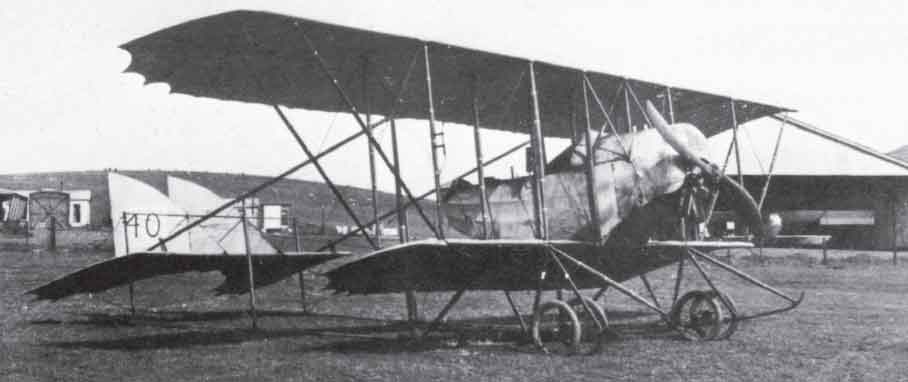
A Caudron G.3. (JM Bruce JS Leslie Collection)
Following distinguished service in the First World War, rising to Commander/Lieutenant Colonel, Malone became a left-wing Member of Parliament; at different times supporting the Liberal, Labour and Communist interests. He died in 1965 at the age of seventy-five.
On another page it was reported that Aviator’s Certificate No 449 had been awarded to Lieutenant Neville Usborne, RFC, flying a Caudron Biplane at the Ewen School, Hendon. His fellow airship pilots, Masterman, Maitland, Boothby, Hicks and Woodcock, also gained Aviator’s Certificates during the course of 1913. Usborne was not alone in impressing the press with his skills:
‘The Naval members of the Royal Flying Corps are to be congratulated on their skilful handling of the airship Gamma. A party who are at present undergoing courses of instruction in the handling of aircraft at the Balloon Sheds, South Farnborough, made a splendid cruise during the middle of the day as far as London and back. After some manoeuvring over the district during the morning, Gamma was headed for London, the voyage occupying about four hours there and back. Commander Masterman, RN, Chief of the Naval Wing, was in command; Lieutenant Husband acted in the capacity of pilot, while Lieutenant Woodcock had charge of the engines. Ascending in a very hazy atmosphere from Farnborough Common she disappeared from sight in a north-easterly direction. Somewhere about 3.15 pm she was again sighted returning from the north and, after being cleverly handled above Farnborough Common, was safely housed in the big dirigible shed, being taken in under cover of the huge sailcloth wind screen which protects the entrance of the shed from the wind. Although the journey to London was made at no great altitude, it was most interesting and successful, and, owing to the hazy atmosphere and low-lying clouds, the courses were set and steered by compass. Crossing the Thames at Hampton Court, on arriving over Fulham and Chelsea, the Gamma was headed back home, as the weather was by this time beginning to look somewhat threatening, and about four o’clock it commenced to snow, by which time, however, Gamma had been successfully grounded and docked. Some fine manoeuvring also took place round the district on Monday and Tuesday this week, particularly on Tuesday, as it was foggy up above, and Gamma could be more often heard than seen, which gave a somewhat weird effect. At times during the morning one could see her slipping along at a low altitude like a grey shadow, only to vanish away quickly in the mist. The conditions up above were such that steering could only be done by map and compass.’209
Delta.
The airship Delta also created a favourable impression early in 1913 when she was taken to the Aero Exhibition at Olympia in London and exhibited over the central aisle for all to see. Those visitors of a technical bent would have been impressed by the colour coding used for the pipework in the car: water – blue, petrol – red, oil – yellow, compressed air – white.210
More Parliamentary Activity
In March, the Secretary of State for War, Colonel Seely, answered questions in the House of Commons regarding the current policy in respect of dirigibles. He stated that the army did not have any large rigid dirigible:
‘Not because it is feared to face the expense in the least degree, but because it was deliberately laid down from the start that the British Army at the present time does not require Zeppelins. Our army is an expeditionary army. To use a Zeppelin for the purpose of, let us say, the reinforcement of Egypt, or the sending of a large body of men to the frontier to India, operations that are not very likely, but against which we are obliged to guard – to use a Zeppelin in these instances is obviously impossible. This gigantic engine could not be taken there, or if it could be it would be with the utmost difficulty, and the provision of hydrogen for it would be an almost impossible problem.’211
He contended that the small, portable, non-rigid airships used by the army were much more practical for its specific needs:
‘We therefore decided that the army should have small dirigibles, which could be packed up in a box, put on motor lorries, or on ships, and sent wherever they are required.’212
[Author’s note: This, of course, never happened in that way, though some of the RN’s small airships were delivered to their war stations by rail.]
He went on to boast in the normal political and unsubstantiated fashion:
‘These dirigibles, I say without hesitation – and all who understand the matter will agree – are superior to any other kind of portable airship. They have various mechanical advantages which I do not wish to dwell upon, because those concerned believe the secret is our own, enabling them to rise more rapidly in the air, and enabling them, above all, to avoid having to part with hydrogen when they rise, and therefore, there is no necessity for re-enforcing that hydrogen when they fall. They have these advantages, which we believe are superior to those of any other nation; but whether that be so or not, the fact remains that the particular balloon which some members of the House saw the other day is an advance upon anything which is known to be in the possession of any foreign power. It goes at a great speed. The speed is 45 miles an hour, and for a small airship that is a remarkable thing.’213
The aviation press did not totally agree with the Secretary of State:
‘The small airships that have been built there are truly quite inadequate from the standpoint of national requirements, but the measure of their size is also the measure of the financial support the government has, at any rate hitherto, been willing to devote to this aspect of aeronautics, and, in consequence, there has been nothing for it but to try and make the best of the funds available. Many of the lessons learned from the construction of these small airships are at any rate likely to be extremely useful in many ways.’214
Colonel Seely then made some very interesting points about the division of responsibilities between the Army and the Royal Navy:
‘The main division between the army and the navy, I think, should be, in this matter of aerial warfare – if warfare there must be – that the navy should take all lighter-than-air and the army should take all heavier-than-air; that is to say, the navy should have the airships and the army the aeroplanes. That is a natural division, because those who know most about it will tell you that the navigation and management of an airship are more like the management of a ship, and the management of an aeroplane is more like the management of a horse. There are exceptions in the case of our small dirigibles that we pack in boxes, and in the case of the hydroaeroplanes in possession of the Royal Navy, which are, of course, heavier-than-air.’215
More Flying
The Parseval airship PL.18, which became HMA No 4, took to the air for the first time on 23 April 1913. She was 312 feet (98 metres) in length, with a diameter of 51 feet (15 metres) and a capacity of 364,000 cubic feet (10,301 cubic metres). Two 180 hp (133 kW) engines gave a top speed of 43mph (69kph). She could carry two officers and a crew of seven men:
‘The Navy’s Parseval over London. The Metropolis has had an early opportunity of seeing the Parseval airship purchased by the British Government for the navy. On Monday afternoon, at about half past four, the airship was brought out, and after circling round Farnborough Common, and getting up to a height of 2000 feet, she was headed for London. Steering a direct course, the airship passed over Brooklands and then across South London, past the Houses of Parliament to St. Paul’s Cathedral, where the airship was turned. With the wind behind, the Parseval made a fast run back to Farnborough, which was reached at a quarter past six. The wind had veered round a little, and so the vessel was moored in the open for some time until the weather conditions were more suitable for getting her into the shed, Nine passengers were on board, including Lieutenant Stelling, of the Parseval Company, in charge; Herr Schaak, in charge of the motors, and a German mechanic; Captain Sueter, RN, Commander Masterman, RN, Commandant of the Naval Wing, Royal Flying Corps; Lieutenants F.L. Boothby and Wilson, RN; Engine Room Artificers Marchant and Cahill; and Mr Ryan, representing Messrs. Vickers.’216
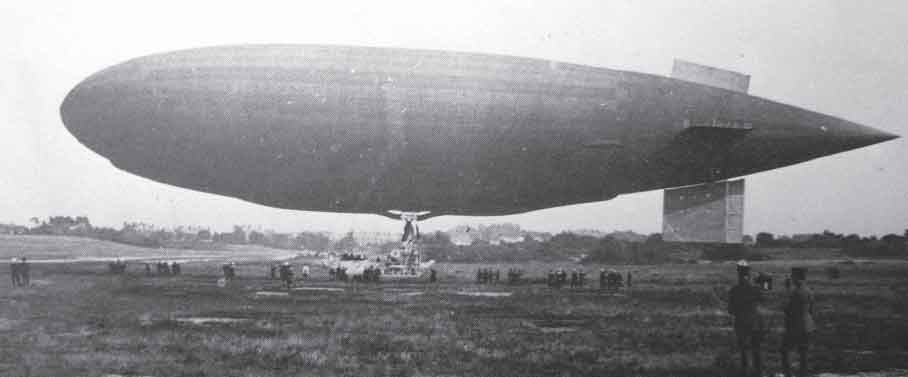
Parseval Airship No 4 at Farnborough. (Via PS Leaman)
Sueter enjoyed the flight and was able to look in through his office window at the Admiralty.217
Three weeks later Flight noted:
‘2½ – Hour Trip by Naval Parseval. With Lieutenant Boothby in command and a crew of nine on board, the new Parseval airship of the Naval Wing of the Royal Flying Corps made a trip from Farnborough to Cowes, Isle of Wight, and back, a distance of about 100 miles in 2 ½ hours on Monday.’218
The airship had a very narrow escape in July when a fire broke out inside its shed at Farnborough, which, not surprisingly, was reported as having created ‘considerable excitement’ before the blaze was brought under control by the airmen with their own fire appliances. It had apparently been started accidentally within a heap of waste on the floor of the shed.219
In Usborne’s opinion:
‘The Parseval made some good flights, but difficulty was found in preventing the envelope stretching during inflation; also the fabric was badly stressed in the wake of the patches that the rigging was secured to. All these stresses made the envelope bad for retaining hydrogen.’220
While the Parseval was carrying out its early flights, the First Annual Report was issued by the Air Committee on the Progress of the Royal Flying Corps. With regard to airships it recommended that a policy of active development should be adopted, but not necessarily of large rigid types – to, ‘allow the progressive education of the members of the Royal Flying Corps in this class of work with the ultimate end in view of being able to evolve an airship in no way inferior to those in the hands of foreign powers.’221 The existing position was summarised thus:
Beta, Gamma, Delta, Eta – Military Wing
Epsilon – Military Wing (not yet constructed)
Willows (HMA No2), Astra-Torres, Parseval – Naval Wing
Two of Neville’s pre First World War Certificates of Service. (Via Sue Killbracken)
It was noted that none of these craft were as large as the big German airships and that it was likely that larger airships would be needed for naval purposes, to which end negotiations had been entered into by the Admiralty with regard to the purchase or construction of these. It was added that no airship in military service had been involved in a major accident leading to loss of life, that both mooring masts and sheds were required, and that the question of the manufacture and storage of hydrogen was in an unsatisfactory state.
On a more personal level, to cover the period May 1913 to December 1913 at Farnborough as Lieutenant and Squadron Commander, Usborne was formally reported on by Commander Masterman (the location is given as HMS Hermes, as this temporarily and rudimentarily converted cruiser was at this time carrying the HQ of the Naval Wing on its books). ‘He is a most capable airship pilot with an excellent knowledge of all aspects of aeronautical work.’222 While awaiting arrival of the Astra-Torres and as a, ‘naval cuckoo in the Farnborough nest’,223 Usborne trained the additional naval officers gradually appointed there in free ballooning, and in flying and handling the smaller military airships. He made a return visit to Portsmouth in Beta in mid-1913, with a mixed naval and military crew. This time signals were made ‘from a considerable height’ asking for permission to land at Whale Island Gunnery School. While the necessary preparations were made to assemble a ground handling party, the airship circled Portsmouth Harbour and Spithead as she gradually descended to land on a lawn in front of the officers’ quarters.224
The King and Queen, along with Princesses Mary and Victoria, visited Aldershot in May and were treated to some aerial displays:
‘On his arrival at Aldershot the King witnessed a cavalry display, and then saw some manoeuvres by Beta. From the airship a photograph was taken of the King and the plate sent down on a parachute, and developed in one of the field dark rooms. They then inspected Gamma and Delta in the shed, and also the car of the new Astra-Torres airship, and subsequently Gamma made an ascent.’225
That evening:
‘Some night flying was indulged in, the airship Beta being up and cruising over the Royal Pavilion. Several aeroplanes were flying in the moonlight, and one machine, owing to a failing engine, brought down some telegraph wires. The King sent a message to his troops, luckily not by telegraph, “I was glad to find a marked development in the work and administration of the Royal Flying Corps, and what courage and esprit de corps animate all ranks of this newly-formed arm.”’226
Early the following month, at the King’s Birthday Parade, Gamma and Beta performed some attractive evolutions during a mass fly-past (including four BE-type biplanes, six Maurice Farmans, two Henri Farmans, and a Blériot) over Laffan’s Plain at Farnborough:
‘The machines flew at an altitude of about 150 feet, and each (including the airships), on passing the saluting point, dipped almost to the ground, the graceful way in which the manoeuvre was carried out being very impressive. The airships in particular showed the ease with which they can be handled, descending as they did, to within a few feet of the earth, and then up again in a gentle sweeping movement.’227
The magazine featured a very attractive photograph of the two airships in flight with the Blériot circling around them. Not long afterwards Gamma was despatched on a six-day reconnaissance tour, making camp at Bracknell in Berkshire with the Irish Guards.
The first flight of the Astra-Torres XIV, HMA No 3, was made at Farnborough on 12 June 1913 with the French pilot, M Rousell in charge and a French crew, but with Usborne and others on board; it was not very successful. Masterman later wrote:
‘During the trial the blower broke down and the ship lost pressure, Usborne displayed great coolness and assisted to avoid disaster in the free balloon landing subsequently carried out.’228
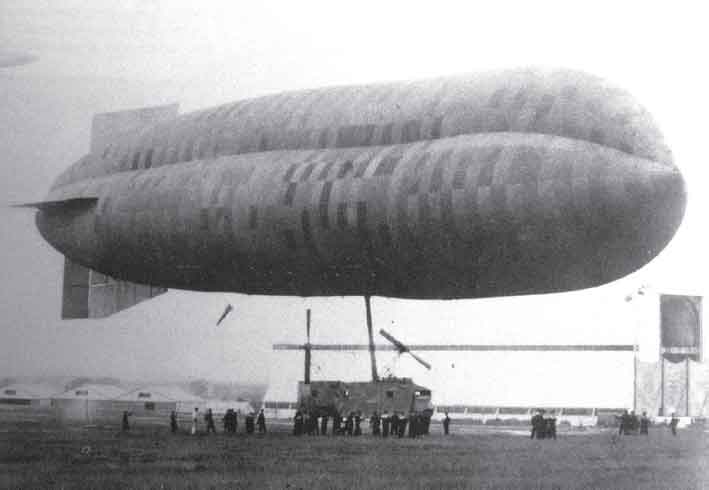
HMA No 3 at Farnborough in 1913.
Onlookers saw the envelope begin to sag in the middle, being almost doubled up before the car touched the ground. It was later reported that the problem had been caused by slippage of the belt that drove the fan to maintain the air pressure inside the envelope.229
It was a much larger craft than the other British non-rigids, having a capacity of 280,000 cubic feet (7924 cubic metres) and was driven by twin Chenu engines of 210 hp (155 kW) each. She carried a crew of six, was equipped with wireless and could be armed with machine guns. The car could be moved fore and aft for trimming purposes, either by power or by hand; this proved unsatisfactory and was abandoned. During the same week as HMA No 3 made her debut, Delta undertook a successful flight of nearly 200 miles (321 kilometres) in a time of some four hours, which indicated a ground speed in the region of 50mph (80kph).230
The most interesting events in July were a visit by the Prince of Wales on the twentieth, when he was taken up for a half-hour cruise in Beta by Major Maitland,231 and a little later in the month some experiments in dropping bombs, Beta having been fitted with a, ‘special mechanism attached to a sighting apparatus.’232
On 19 August 1913, Usborne was in command of HMA No 2 (Willows No 4) when it experienced engine failure due to a broken crankshaft, near Odiham in Hampshire. He managed to return it as a free balloon to its shelter at Odiham and was able to assess his options: (a) Leave her broken down at Odiham, which was undesirable as a large social gathering was due be held there. (b) Deflate the envelope and return to Farnborough by road, which would mean terminating observations of the airship’s new-type fabric. (c) Repair the engine on site, which would take two weeks. (d) To walk her home; which would be both conspicuous and laborious. (e) Seek a tow, an operation which had never before been attempted.233
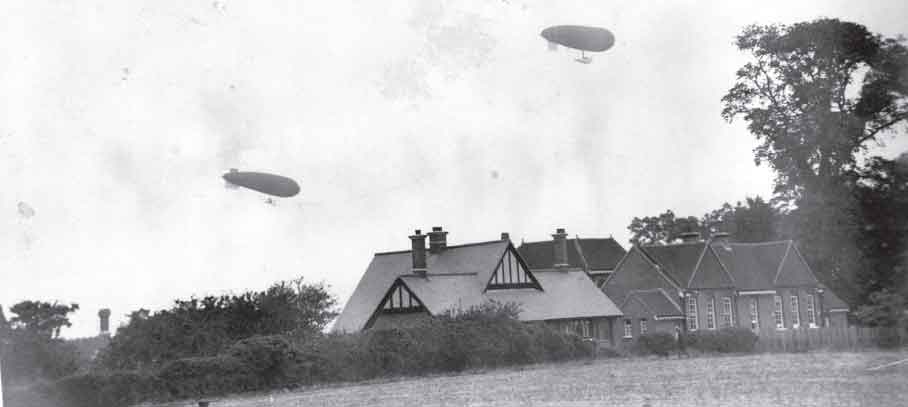
A view from the ground showing No 2 being towed by Eta. (Via Nigel Caley)

The start of the tow, Eta above and HMA No 2 below.
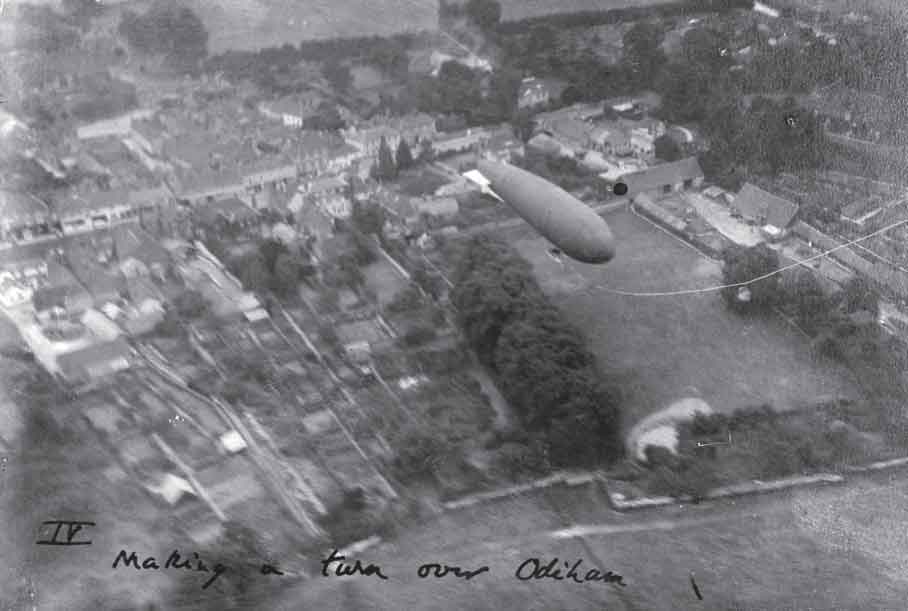
Airship No 2 being towed, as seen from Eta. (Via Nigel Caley)
He opted for this latter course. The airship would be towed back to Farnborough by Captain Waterlow in command of the latest army airship Eta, which was still in the hands of the Royal Aircraft Factory. Therefore, Usborne sought the permission of the assistant superintendent, S. Heckstall-Smith, and also the Officer Commanding No 1 Squadron, Major E.M. Maitland, which was readily granted. Lieutenant Woodcock prepared the ship, while Usborne took charge of laying out the towing cable. Waterlow arrived at 6am on 20 August, by which time Usborne had laid out 600 feet (183 metres) of 1½ inch (4 cms) hemp rope to the leeward of his craft. The front end was secured behind the ballonet tube of Eta and run aft. To prevent the rope fouling the rudder a 15lb (6.81kg) bag of sand was hung from a cable at that point, while the line was attached to the centre of No 2’s car. No 2 was trimmed with negative buoyancy to avoid fouling Eta, the coxswain doing this with the hand pump. The slack was taken up and the tow began gently on one engine. When No 2 was clear of the trees, Waterlow started his second engine. The 8 mile (12.8 km) trip was made at a ground speed of 25mph (40kph) against a 5mph (8kph) headwind and at a height of 200 feet (60.96 m). Also taken on board as a passenger was Denys Corbett Wilson, who was the first man to complete the crossing from Great Britain to Ireland by aeroplane (on 22 April 1912 he flew in a Blériot monoplane from Fishguard to Enniscorthy in one hour and forty minutes).
Over Farnborough the height was increased to 400 feet (121.92 m), the tow line was slipped and the sandbag dropped away. The landing party caught the mooring rope and No 2 came to rest exactly on its alighting mark. So unusual was the incident that it even received the attention of the New York Times:
‘The novel sight of an airship towing her disabled companion was witnessed at Aldershot this afternoon. The British Army airship Eta and a naval airship were manoeuvring when the machinery of the latter became disabled. The Eta attached a hawser to the other dirigible and towed her to the factory for repairs.’234
Waterlow later received a letter of thanks and commendation from the Admiralty. Commander Masterman’s report on the incident stated; ‘This evolution demonstrates once more the great value of swivelling propellers; it confirms views previously held that towing of airships would be practicable and useful and is, I believe, the first experiment of the kind to be carried out anywhere.’235 Captain Sueter noted that; ‘It opens out considerable new possibilities in the employment of airships.’236
Usborne himself summarised the incident and lessons learned as follows:
‘From these experiments I consider: (1) Towing is a safe and useful manoeuvre. (2) That with practice and certain preparations, airships may in due course be relied upon to take in tow in the air. (3) That material use can be made in war, for the execution of a very long voyage, or for the carriage of a very large amount of explosives, of the idea of towing a suitable old envelope (of which there are always a number available) which could carry only additional petrol, or say, five tons of explosives. (4) A great deal of experience is still necessary as regards length of tow line, relative buoyancies of the two ships, etc, before the operation can be regarded as the same straightforward affair it is at sea.’237
Eta had just that month been accepted into service for trials, making her first flight on the evening of 18 August. Her design was the culmination of all the experience gained in the previous six years. Her suspension system was innovative in that it did away with much of the normal bridle and netting by replacing it with six rigging cables. These sub-divided several times until thirty-six attachments were affixed to the envelope by means of adhesive patches, which were also stitched on, thus the load was spread much more evenly.
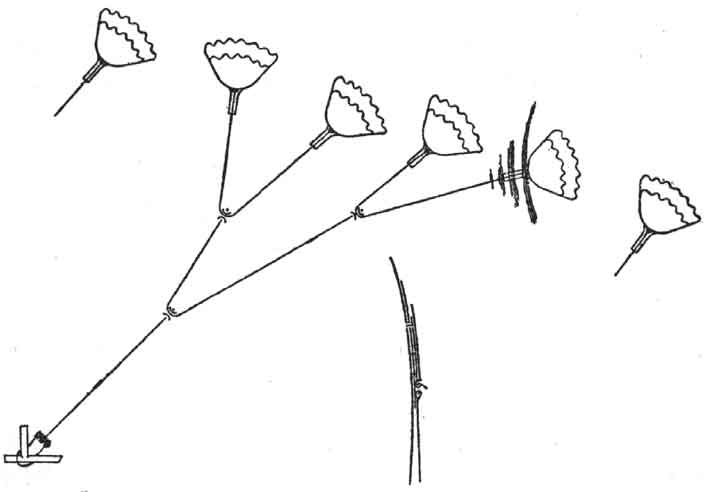
Rigging with Eta patches and bridles.
Eta, which had just entered service, before giving HMA No 2 a tow.
Eta’s capacity was 118,000 cubic feet (3339 cubic metres) with two 80 hp (58 kW) Canton-Ume engines, each chain-driving a swivelling propeller mounted on an outrigger. Their function was described as follows:
‘As the airship ascends, these propellers are swivelled round, so that ultimately their axes are horizontal for full speed ahead. In order to stop the airship they can be turned completely round so as to thrust backwards, and they can similarly be used for lowering the airship for the purposes of descent.’238
Eta successfully completed the trials in September with an eight and a quarter hour cruise from Farnborough to Portsmouth and back, in the very capable hands of Clive Waterlow. Cruising with and against a 14mph (22kph) wind, she maintained a mean speed of 42mph (67kph) at a height of 4200 feet (1280 metres). This was hailed as a duration record for a British airship. Three airships, Beta, Delta and Eta, and three squadrons of fixed-wing aircraft, took part in the army manoeuvres in the area of Daventry and Aylesbury, with the two armies being commanded by Generals Haig and Rawlinson. The Times commented:
‘Failing defeat in the air, or fire from below, modern aircraft will, at all times, except in continuous bad weather, enable a commander to learn with very fair accuracy the position and direction of hostile columns while they are several days’ march away from him.’239
Delta and Eta were both equipped with wireless sets for the manoeuvres and were based at Dunchurch, near Rugby in Warwickshire. In total, Delta sent sixty-six messages in the course of seven flights and, on 24 September, carried out a successful night reconnaissance. Eta, due to engine trouble, played no effective part in the manoeuvres, but during her journey from Farnborough to Dunchurch, she maintained wireless contact with Aldershot until reaching Woodstock in Oxfordshire, then she called up Dunchurch and kept in communication for the remainder of the flight. Captain Lefroy, RE, who was the RFC’s wireless expert, stated in his report:
‘It seems probable that HM Airships Delta and Eta can exchange messages with each other when 100 miles (160 kilometres) apart in the air, which may prove useful for organization purposes, etc. I received clear signals from the North Foreland station (and a ship to which she was talking) when 130 miles (208 kilometres) NW of it, and whilst HMA Eta was cruising northwards at touring speed.’240
The Times noting the good work of the airships, and Delta in particular, sagely and judiciously commented:
‘So far as airships and aeroplanes are concerned, the honours for obtaining information were fairly divided and do not appear to justify the threatened elimination of the airship from our war material. The Delta was usually out first and home last. She brought early, accurate and valuable information. The airship alone can work in the mists and fogs so prevalent in our islands, and she alone can at present travel safely by night and report bivouacs and railway movements. It would not be a good reply to the policy of other great powers were we to put all our money into aeroplanes and to neglect the dirigible, even if we all agree that the aeroplane has the greater future in front of her.’241
During the course of the manoeuvres, Major Maitland expressed his concern about the lack of provision of measures to permit aircrew to escape safely from damaged airships or aeroplanes. Given his successful experiments with parachute descents, he should have been listened to much more carefully, but at this stage he was at odds with the views of senior officers – who were not the ones risking their necks. Murray Sueter had a very high regard for Maitland, whom he described as, ‘a most courageous pioneer airman; his parachute descents were famous. He would drop from an airship perfectly unconcerned. Just before he made one of his perilous descents with a parachute of no great efficiency I asked him in a casual way what he thought of death? He gave me a characteristic reply, ‘“Oh, nobody should mind death. Why should anybody mind it? They should look upon death as a great adventure.”’ Sueter noted that Maitland regularly used a Guardian Angel static-type parachute, invented by a Mr E.R. Calthrop and which saved the lives of many kite balloon crews during the First World War.242
Delta experienced both misfortune and success. On a test flight, she broke down near Faversham in Kent and was forced to land. Wireless messages of distress were sent out, the aerials being fixed to a neighbouring tree, and in response Commander C.R. Samson, RN, and Captain G.V. Wildman-Lushington, RMA, flew over in Short biplanes from the Naval Flying School at Eastchurch to render assistance. Having been repaired and now piloted by Clive Waterlow, Delta next left Farnborough early in the morning and travelled to the Isle of Sheppey before the wind rose. There, several naval pilots turned up and flew round her ‘joyously’. Leaving Sheerness about 11 am, she reached London about midday, assisted by a strong breeze from the south-east, and passed over St Paul’s and St James’s Park. She crossed the Royal Aero Club building with about 50 feet (15 metres) to spare and went up Bond Street, the pilot showing her to be under excellent control. Finally, she reached Farnborough safely, having beaten the Eta’s record as she had been in the air about eight and a half hours.243
The Astra-Torres, HMA No 3, emerged again on 8 September, after some months out of commission for necessary alterations. Its first half hour flight was again in the hands of M Hugon, M Rousell and a French crew, with Usborne, Commander Oliver Schwann and Commander Masterman as passengers. It performed satisfactorily, was formally accepted by the RN and soon began a successful trials programme. This included a six hour flight around Portsmouth, the Isle of Wight, Bournemouth and Portland. She also established a record speed for a British airship of 51mph (82kph) during the course of a one hour flight, with Captain Sueter and Lieutenant L’Estrange Malone as passengers. Usborne was appointed to command in October, with Lieutenant W.C. Hicks as his flying officer,244 and later wrote:
‘The Astra-Torres was of a tri-lobe form, and allowed an internal system of rigging that distributed the load fore and aft the length of the envelope. This Astra-Torres patent for suspension was a good system and the envelopes on the whole kept their shape well.’245
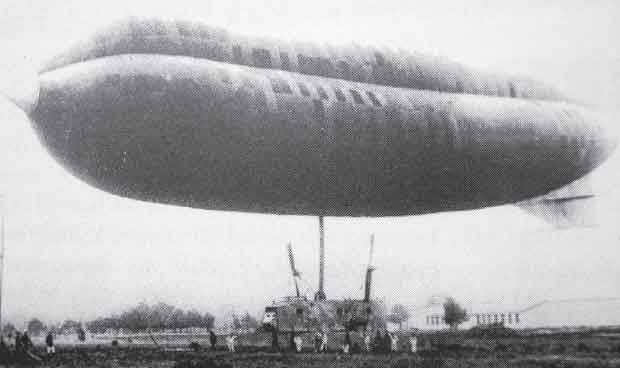
HMA No 3, Astra-Torres, is secured at a portable mooring mast at Farnborough in the spring of 1914. (Ces Mowthorpe Collection)
A newspaper report a few days later stated:
‘The naval airship Astra-Torres, navigated by Lieutenant N.F. Usborne, RN, and a crew of seamen, made an evening flight yesterday. A heavy fog obscured her from view almost from the first moment of her ascent. The aircraft returned after dark and was lighted to her landing by a row of lamps, while a semi-circle of electric lights indicated the door of her shed. Earlier in the day the naval craft was flying with the Eta and displayed a faster turn of speed than the army dirigible balloon.’246
On the twenty-fourth of the month he took Winston Churchill for a flight, of which The Times wrote:
‘In the meantime the Astra-Torres naval airship had arrived at the Isle of Grain from Farnborough, descending on the marshes near the air station at half past twelve. While at the aeroplane station, the ship took Mr Churchill and Sir Ian Hamilton on board, and, under the command of Lieutenant Usborne, RN, made a circuitous flight lasting an hour and a half. After landing her passengers the airship, leaving at 4.20, returned to Farnborough Common, where she arrived at 5.45. On the homeward and outward journey the ship carried, besides Lieutenant Usborne and his crew of sailors, Commander Masterman, RN, Engineer Lieutenant Cave-Browne-Cave, RN, and Lieutenant Hicks, RN.’247
The distinguished passenger enjoyed the flight and availed himself of the opportunity, not long afterwards, to fly in both Beta and Delta. He later wrote of the Astra-Torres:
‘I went in her for a beautiful cruise at about 1000 feet around Chatham and the Medway. She is a very satisfactory vessel and I was allowed to steer her for an hour. She was very easy to steer.’248
Mr Churchill had arrived at the Isle of Grain from Eastchurch for his flight with Usborne in the Short Biplane No 3, flown by Commander C.R. Samson, RN, having been conveyed there in the morning by the Admiralty yacht Enchantress.249 By the end of the year the airship was reported as having made a number of successful flights visiting Portsmouth, Sheerness and Chatham. On 18 October, the intrepid Major Maitland made the world’s first parachute descent from an airship, namely Delta, which was being piloted by Captain Waterlow. He jumped from 1800 feet (548 metres), swaying to and fro in an arc of some 50 feet (15 metres) as he descended under the canopy. The parachute fell into deep water at Cove Reservoir, but Maitland, being just at the end of one of the oscillations, came down in a shallower part. When the jump took place Delta rose sharply with the reduction in payload, but this was swiftly arrested by Waterlow.250
On another flight in the Astra-Torres, Captain Sueter, who was flying as a passenger, made an unusual request. He asked Usborne to bring along three dozen eggs. As the airship circled over Farnborough, the eggs were dropped at regular intervals from a height of 800 feet (243 metres). It was a perfectly still day and the eggs dropped and penetrated the earth like bullets, without smashing. By this means Sueter was able to ascertain the turning circle of the airship and to judge how responsive it was to the action of the rudder.251
Also in October 1913, airships became the sole responsibility of Naval Wing. Beta, Gamma, Delta and Eta were handed over by the army to the navy – apparently as the result of an informal discussion between Winston Churchill, the First Lord of the Admiralty and Colonel Seely, the Secretary of State for War. Major Sefton Brancker, ‘the monocled, deceptively foppish Indian Army officer, whose approachability, drive and enthusiasm belied his image and who was one of the principal motive forces in British aviation for twenty years,’252 who was serving with the Military Wing as the Assistant Director of Military Aeronautics later wrote:
‘This was a bombshell! The General Staff were furious, and the Military Aeronautics Directorate threw up their hands to heaven and called down curses on the heads of all politicians. We soldiers loved our little airships and fought hard to retain them; they were small but they led the world in efficient handling and we felt they were the germ of a great future.’253
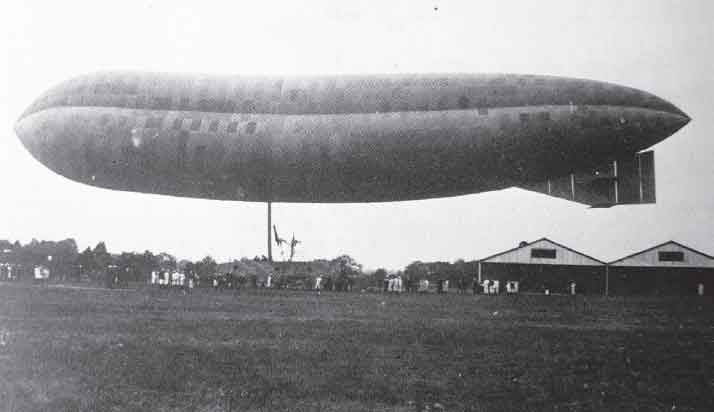
Another view of the Astra-Torres, HMA No 3, at Farnborough. (via PS Leaman)
He added:
‘But Seely was absolutely right. In practice at their then state of development, our airships would have been perfectly useless to the army, whereas they proved invaluable to the Admiralty in the Great War.’254
This division of responsibility had in fact been considered by Seely’s technical sub-committee in 1912, which had recommended the attachment of naval officers to the military wing of the RFC for airship duties (the first of whom was Neville Usborne) to learn the ropes with a view to the naval wing taking the lead in due course.255 The airships, along with their equipment and plant, were valued at £65,000, with the Admiralty agreeing that such an amount should be placed by the Treasury to the credit of the War Office. The officers and men of the former airship squadron of the RFC would henceforth be attached to the naval wing and placed under the command of Commander E.A.D. Masterman, RN, with Neville Usborne as his deputy. He later wrote:
‘These small airships were good for training, but they could only make short flights and their engines were none too reliable.’256
Masterman commented:
‘This period was one of the happiest of his life, he was continually active and quite willing to start again at the beginning in the hope of gradually building up a naval airship service.’257
In the same year, works commenced at Kingsnorth, on the Hoo Peninsula at Medway, not far from Sheerness and Chatham. Two large airship sheds were planned, one made of metal and the other of wood, as well as all the necessary accommodation and services, including hydrogen generating plant, gas tanks, fuel tanks, workshops, wireless station and a light railway, for what would become an important Royal Naval Air Station – the principal airship dockyard, centre of research and development, and major training establishment.258
On 3 December 1913, Captain Clive Waterlow, AFAeS, RE, read a paper before the Aeronautical Society of Great Britain titled: ‘The Coming Airship’. This was followed by a lantern show with slides showing the construction, method of working and the control of the airships Gamma, Beta, Eta, Willows, Parseval and Astra-Torres. In his talk he argued that, until relatively recently, there had been a prejudice in the press against airships and that journalists seemed to regard airships in wartime as being at the mercy of any aeroplane. He countered this by saying:
‘I don’t think it is generally realised that the airship has by no means reached such an advanced stage of development as the aeroplane; the possibilities and probabilities of the future are very rosy and very wonderful.’259
He went on to discuss the differences between the lines of airship development in England and on the Continent. In England the focus had been on producing smaller craft with greater handiness and control, in Europe the aim had been to build the largest ships possible with the longest range. Waterlow then described how, on manoeuvres with the army in September 1913, Delta and Eta had coped well in the field with rain and bad weather, needing only a small handling party. He looked forward to a day soon when airships would go as fast as 55 or 60mph (88 to 95kph). He added:
‘If ever airships achieve 70mph (112kph) it is difficult to see where the aeroplane, as we know it today, will come in at all for war purposes; and this, of course, applies equally to seaplanes.’260
Waterlow was underestimating the potential of the aeroplane in this respect, as the world absolute speed record for a fixed-wing aircraft stood at 111mph (179kph) in 1913 – though it should be noted that the aircraft was unencumbered by any warlike stores or other useful load.
On the question of safety he saw fire as the greatest hazard – from the engines, the wireless apparatus, or other sources, ‘such as defective wiring in the electric lighting circuit, matches and so on’.261 The combustible material which could be set alight he identified as, ‘the gas within the envelope, the petrol for the motors, and such portions of the car and framework as are not made of metal’. He believed that the risk of fire from the engine could be rendered small by guards on the carburettor and the exhaust pipes, as well as silencers which also acted to cool down exhaust gases; rogue sparks from the wireless could be eliminated by careful design, and risk from other sources could be dealt with by good safety procedures. As regards the combustible materials, hydrogen was the only suitable gas available and it was essential to allow some means for it to be vented when required. He looked to the development of a satisfactory automatic valve placed on the top of the envelope, and encouraged chemists to seek a light non-inflammable gas which could be mixed with hydrogen and make it inert, but not materially impair its lift. In 1903, large reserves of the light and inert gas – helium – were found in the natural gas fields of the USA. The world’s first helium-filled airship, the US Navy’s C-7, first flew on 1 December 1921.
Petrol was also necessary, though he hoped that it could eventually be replaced by heavy oils. In the meantime it should be carried on board aft of the engine and as far away from it as possible. As regards non-metal items, they should be fireproofed. He regarded the greatest danger to a non-rigid airship being a propeller blade breaking off and slicing into the envelope. To counteract this he recommended that the envelope should be divided internally with partitions to minimise the damage caused by a foreign body of any sort making a hole in the envelope. He then moved on to examine design; firstly the envelope, which was usually made of a fabric of cotton and rubber, dyed yellow. Other possibilities were goldbeater’s skin or silk. The main aim was to produce an outer skin which could be easily manufactured, would hold gas well, would not deteriorate and would absorb no moisture. Next, he emphasised the desirability of internal partitions and noted that the latest Zeppelin had seventeen separate gas containers. As regards armament, he recommended a gun should be mounted on top of the envelope. Concerning the powerplant, he thought a six cylinder engine (or engines depending upon the size of the airship) driving a four-bladed propeller would be sufficient. Swivelling propellers were very useful in assisting smooth landings at all weights. The control system should be easily within the reach and view of the pilot, or in a larger airship there should be a telegraph instrument. Finally, he considered the use of the airship in military and commercial roles. He recommended for military use a non-rigid type slightly bigger than the Astra-Torres airship HMA No 3, with a speed of 55mph (88kph), a crew of eight or nine, nine hours endurance and two guns mounted in the car and on the top of the envelope, ‘both designed to shoot all around the compass.’262 He saw a great future ahead for the civil airship and wondered why a service from London to Paris was not already in being. Newspaper and mail delivery from the air to rural areas, dropped by parachute to village shops, was also seen as a promising way ahead. Aerial yachts for the rich were also predicted. In conclusion, he described an imaginary voyage from London to Paris in the airship Albatross. The first of the audience to rise and discuss Waterlow’s paper was Neville Usborne. His main point was that he considered the speaker to have been overly pessimistic with regard to the future potential top speed of airships. He thought that the prospects for an airship attaining a speed of 70mph (112kph) in the near future were excellent and went on to say:
‘High speed would enable an airship to face any gale and be largely independent of weather conditions, which are always a factor in aerial navigation.’263
[Author’s note: On 27 October 2004, the American adventurer, the late Steve Fossett, and his co-pilot Hans-Paul Stroehle, in the Zeppelin NT, set an officially verified speed world record for airships over a 1000 metre course of 115kph (71mph). This is below the maximum performances of Zeppelin LZ 129 Hindenburg and LZ130 Graf Zeppelin II, which attained more than 130kph (80.5mph), and the American airship ZRS-5 Macon, which reached 140.3kph (87mph). However, these speeds were never verified by the official body responsible for keeping these records, the Fédération Aéronautique Internationale. [www.records.fai.org]
Others who spoke after Neville Usborne included the man-lifting kite pioneer, Major B.F.S. Baden-Powell, E.T. Willows, the airship manufacturer, Mervyn O’Gorman, the superintendent of His Majesty’s Aircraft Factory at Farnborough and F.M. Green, the factory’s design engineer, who were all generally in agreement with the points made by Waterlow. It was noted that the meeting concluded with a vote of thanks to Captain Waterlow for his excellent paper.264
In January 1914, as had been agreed, the Admiralty took over the airships, work plans and aerodrome at Farnborough from the Military Wing. The airship branch at this time consisted of six officers, thirty-eight men and civilian repair staff under the command of Commander Masterman, RN. Naval and military seniorities were adjusted to a common list, which was a very delicate matter. It is appropriate at this point to consider the rank structure in the RN air branch at this time:
Wing Captain = Captain RN
Wing Commander = Commander RN
Squadron Commander (in command) = Lieutenant Commander RN
Squadron Commander (not in command) = Lieutenant RN of over four years seniority (but senior to all Flight Commanders)
Flight Commander = Lieutenant RN of over four years seniority
Flight Lieutenant = Lieutenant RN
Flight Sub-Lieutenant = Sub-Lieutenant
Warrant Officer 1st Grade = Commissioned Warrant Officer RN
Warrant Officer 2nd Grade = Warrant Officer RN265
The flying rank was not necessarily the career officer’s substantive rank. As an example, a Lieutenant RN could be appointed to flying duties as a Flight Lieutenant, Flight Commander, Squadron Commander, or even Wing Commander. If and when an officer reverted to general service, he could find himself back as a Lieutenant. Ranks in the RNAS were denoted by stars over the sleeve lace (for Flight Lieutenants and Squadron Commanders) and three stripes in the sleeve lacing for Wing Commanders. All pilots wore the RNAS eagle badge above the loop of their left sleeve lace. For an officer transferring in the airship service as it moved from the Royal Engineers to the RFC, RNAS and finally the RAF, the position could become even more complicated, particularly when rapid wartime promotion, temporary and brevet ranks were factored in. For example, E.M. Maitland was a Lieutenant in the Essex Regiment when he was attached to the Balloon School in 1910; by the following year he was a captain in the Air Battalion, Royal Engineers. Within a few months he was a major in the Royal Flying Corps and, at the commencement of the First World War, he was promoted not only to lieutenant colonel, but also wing commander in the RNAS, rising to colonel in the RFC and wing captain in the RNAS. In 1918 he became a brigadier general in the RAF and, when the rank structure for the new service was agreed in 1919, he was firstly a permanent commission as a group captain and then promoted to air commodore. Maitland therefore served as an officer in the infantry, RFC, RNAS and RAF.
Masterman wrote:
‘Usborne’s position in the airship world rose through this move. From being almost a guest of the RFC at Farnborough, he was now a person of importance in the combined service, and his capabilities and knowledge were fully recognised by his former hosts.’266
Usborne was promoted to commander RN – a substantive, not an ‘air duties’ rank – on 1 January 1914267 and the following notice appeared in Flight Magazine of 28 February 1914:
‘Wedding Bells: CONGRATULATIONS to Commander Neville Usborne, RN, of the Naval Wing of the Royal Flying Corps, who was married on Monday at St. Margaret’s Church, Westminster, to Miss Betty Hamilton.’
The Times noted:
‘The bridegroom and the best man, Lieutenant C.J. L’Estrange Malone, RN, Assistant to the Director at the Air Department of the Admiralty, were in full uniform, and there was a guard of honour at the church from the Naval Airship Section and from the bridegroom’s ship, Naval Airship III.’268
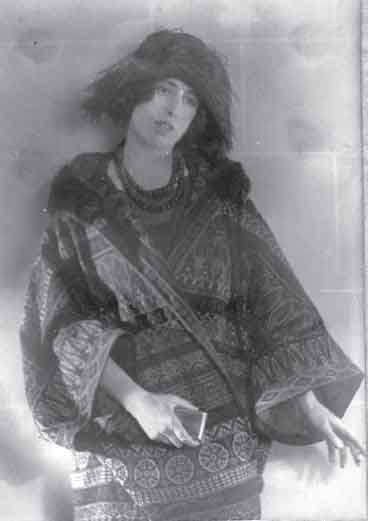
Betty Usborne.
Helen Monteith ‘Betty’ Hamilton, who was 21-years-old, was the daughter of the artist and tea-planter Vereker Hamilton, and was also the niece of General Sir Ian Hamilton, who would command the ill-fated Mediterranean Expeditionary Force during the Battle of Gallipoli.
Almost a Taste of Action
The airship branch almost got a taste of action in the spring of 1914 when two Squadron Commanders, F.L. Boothby and R. Bell Davies, were sent to the British Protectorate, Somaliland, to survey the possibility of airships being used there. The intent was that they should assist the Camel Constabulary in suppressing Sayyīd Muhammad ‘Abd Allāh al-Hasan, ‘the Mad Mullah’, and his dervishes, who were raiding the country from Ethiopia and Italian Somaliland. Airships had been decided upon by the Admiralty because aero engines were at that time so unreliable the inevitable result of mechanical failure for an aeroplane would be a forced landing, which the Mullah could claim as being due to his magical powers.
A paper was circulated by the First Lord of the Admiralty considering the proposal of the Colonial Office to use aircraft, which noted that the whole wealth of the Mullah was in camels and livestock and that very considerable damage could be inflicted upon him, apart from actual offensive operations, by stampeding his stock and keeping them from their wells.
It was considered that three airships would suffice, two of the Parseval type with modified cars for operations, accompanied by Eta, also modified to enable her to carry stores to the advanced base, to assist with a photographic survey of the trade routes and to be available as a spare ship in case of necessity. One portable and two canvas sheds would be needed, a hydrogen plant, armament from the Ordnance Department, spares (including envelopes), petrol, oil and photographic equipment. It was envisaged that eight officers and forty-nine other ranks would be required, supplemented by Indian troops from Berbera should further manpower be required for handling parties. The experience of the Italian airships at Tripoli was cited as proof that airships could operate satisfactorily in the climatic conditions prevailing in the Somalian winter. The total cost was estimated at £75,000.269
In the event the onset of hostilities in Europe concentrated minds elsewhere; the Mad Mullah had to wait until 1919–20, when aircraft of the RAF did the job – one of the first examples of air control beloved by Air Chief Marshal Sir Hugh Trenchard.
A Parting of the Ways
June 1914 brought the final breach between the two wings of the RFC when the Admiralty issued a series of regulations governing the organisation of the Royal Naval Air Service, which thereby became a distinct branch of the Royal Navy in much the same fashion as the Royal Marines. Remarkably, the Admiralty was able to make this move without either being questioned or contradicted by either Parliament or in the Press. It was very much a unilateral declaration of independence. The second (and final) annual report on the RFC to include notes on airships was issued at about this time, and reported that in the previous year a distance of 5,275 miles (9,160 kilometres) had been flown by airships without casualties, with an additional 12,848 miles (20,557 kilometres) by free balloons, much used for training purposes.270
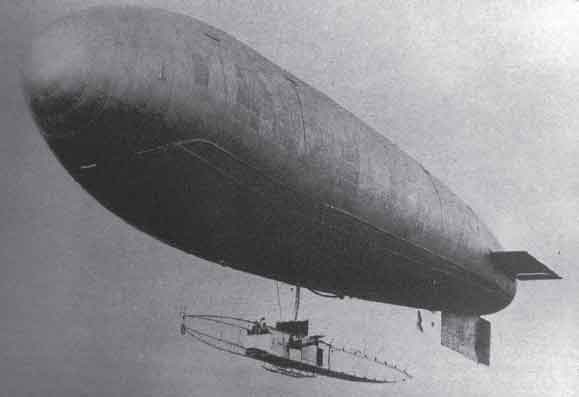
Gamma over Portsmouth in June 1914.
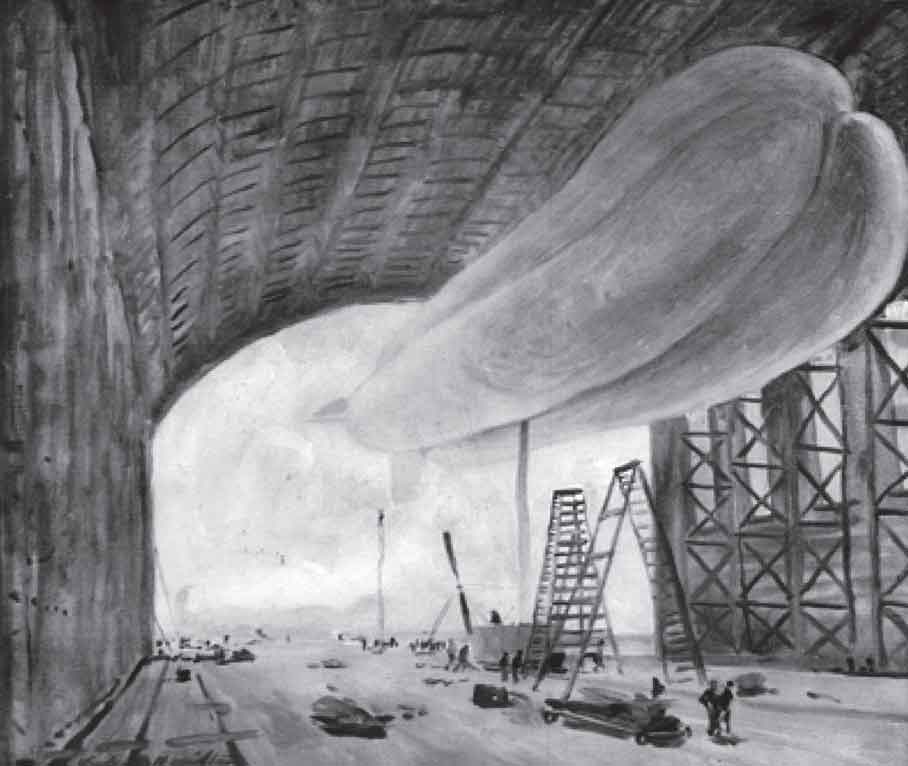
HMA No 3 at Kingsnorth in 1914 by Vereker Hamilton.
In mid-1914, Kingsnorth was commissioned as a constructional, experimental, and class G station, with the stated purpose of protecting Chatham and Sheerness. It was decided that Astra-Torres and Parseval airships would be stationed there. Remarkably, the First Lord of the Admiralty found the time to write to the Director of Air Services about the security arrangements on 7 June:
‘The wooden shed at Kingsnorth would be a fine quarry for the suffragettes and it appears to me that it should be watched. The existing watchman informs me that he watches all night long and on Sundays from 12 noon till 7 o’clock next morning. This means that he probably walks round once or twice and goes to sleep for the rest of the time. The matter should have your attention and a regular watch established pending the time when the men enter.’271
On 1 July 1914, Usborne was appointed as wing commander and confirmed in command of Kingsnorth. He had been there since mid-June and had to deal with a potentially dangerous fire in the metal airship shed on 28 June.
Masterman wrote of this period:
‘The Airship Branch was unprepared for hostilities, but Usborne was full of schemes for the use of such material as was available and specialised in the mooring out of non-rigid airships in the open so that they could be available for patrol work over the sea. Godmersham Park was the scene of some of his activities.’272
Napoleon believed that an army marched on its stomach; from correspondence between Usborne and an applicant for the post of messman at Kingsnorth it would appear that Usborne believed that a well-fed wardroom was a happy and efficient one. It also shows that he paid considerable attention to detail and gives a very good indication of the style of life enjoyed by RN officers of that period.
W.H. Gunner sought a position as messman in a series of letters to Usborne commencing in August 1913. The agreement was written in Usborne’s own hand:
Victualling agreement with W.H. Gunner – messman.
Each Officer, 2/- (10p) per day or £3 per month, guest 3/6d (17½p) per day.
Breakfast – porridge, fish, bacon & eggs or sausages, omelettes or kidneys, boiled eggs, tongue, two jams, and marmalade.
Luncheon – soup, two hot dishes (fish, steak chops or joint), three cold joints, potatoes, second vegetable (in season), sweet (twice weekly), cheese, pickles, celery or salad (in season).
Sunday Supper (in lieu of dinner) – soup, fish, roast meats, galantine or pie, ham, tongue, potatoes, sweet cheese, pickles, celery or salad (in season).
Tea – pot of tea, plate of bread and butter or buttered toast. Extras in rotation: Fullers bake, crumpets, biscuits, rock cakes.
Dinner – soup, fish or entrée, one joint, sweet, savoury and coffee.
Only the best articles of food are to be purchased by the messman and another brand of tea or coffee shall be supplied by him if that provided does not give satisfaction. Best Parisian coffee will be served after lunch at 2d (1p) per cup and gratis after dinner. Special attention should be given to the variety of meals avoiding any monotony. All beers, minerals (including a good brand of ginger beer), cigars, cigarettes and tobaccos to be supplied by messman at lowest current prices.273
He was also concerned about the suitability of neighbouring Hoo and Rochester as places of resort for the men when off duty. He regarded Hoo as, ‘a particularly undesirable village, full of public houses of the low agricultural type.’274 He therefore proposed that a wet canteen, ie, serving alcoholic beverages should be constructed on site, so that social drinking could be monitored and, hopefully, controlled. Further suggestions included the provision of games, indoor pastimes and garden allotments, ‘so there is no reason why the place should not become a happy, self-contained colony.’275
Both airships, No 3, which was a particularly comfortable ship, with an enclosed car and a radio set, and No 4, made a good number of successful flights from Kingsnorth during 1914, including, in April, another circuit of London landmarks, this time by No 4.
In July 1914 the Naval Wing was renamed the Royal Naval Air Service. It comprised the Air Department at the Admiralty; the Central Air Office at Sheerness; the Royal Naval Flying School at Eastchurch; the Royal Naval Air Stations, and all seaplanes, aeroplanes, airships, seaplane ships, balloons and kites employed for naval purposes. The first Director of the Air Department of the Admiralty was Captain Murray Sueter, CB. There were six wing commanders, who were, in order of seniority: O. Schwann, E.A.D. Masterman, F.R. Scarlett, E.M. Maitland, N.F. Usborne and C.R. Samson. Personnel already serving in the RN, RM, RNR and RNVR could apply for transfer. This was shortly before the Royal Fleet Review at Spithead, which was held from 18–22 July 1914. The Astra-Torres HMA No 3 flew over the fleet in July 1914 under the command of Wing Commander Usborne, with Flight Lieutenant W. Hicks as 2nd Officer. It was joined from Farnborough by HMA No 4 (Parseval), Squadron Commander H.L. Woodcock and Flight Commander J.N. Fletcher; HMA No 18, Gamma, Flight Commander J. Boyle and Flight Lieutenant A. Cunningham, and HMA No 19, Delta, Squadron Commander C.M. Waterlow and Flight Commander J.D. Mackworth. No 3 and No 4 escorted the Royal Yacht out of Portsmouth harbour. Seventeen fixed-wing seaplanes from Isle of Grain, Dundee, Yarmouth, Felixstowe and Calshot, as well as twelve fixed-wing, land-based aircraft from Eastchurch also participated. When manoeuvring directly over the assembled fleet, one of the airships took the first ever vertical photograph of a battleship taken from the air.
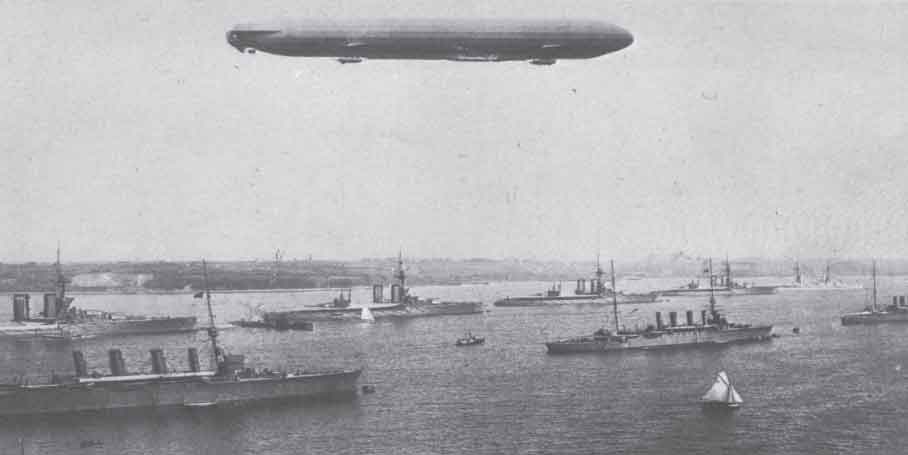
A Zeppelin flies over the visiting warships of the Royal Navy at Kiel in June 1914.
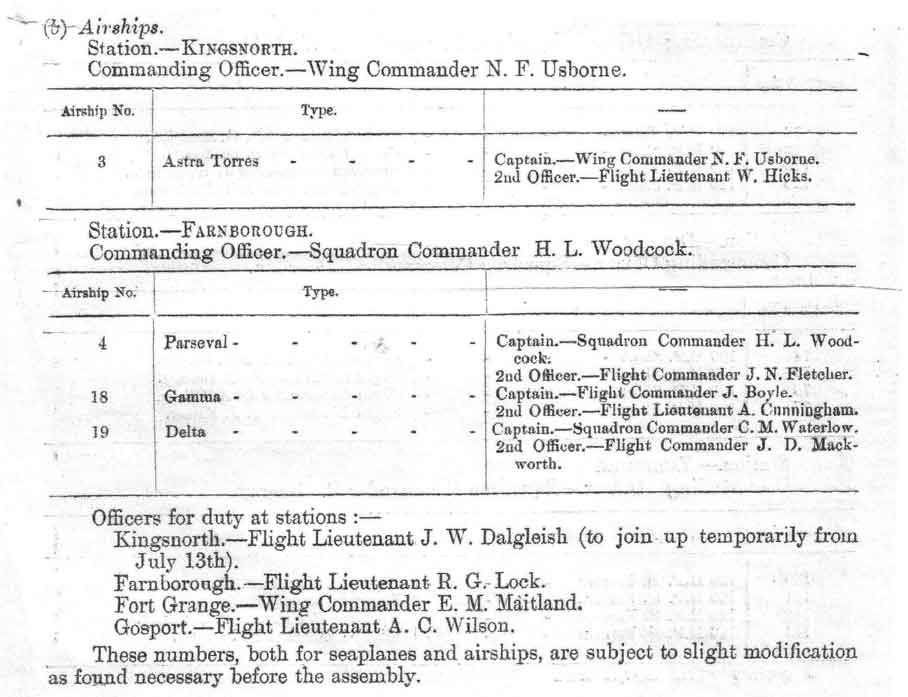
The General Orders for the assembly of aircraft at Spithead, on 18–22 July 1914, included instructions specifically for the airships. General orders covered some more specific stipulations: ‘Uniform for all officers will be monkey jacket, breeches and putties, optional flying kit to be worn over it when actually flying. Officers may also wear any form of headgear when flying, but must carry a uniform cap to wear at all other times.’ (via Sue Kilbracken)
